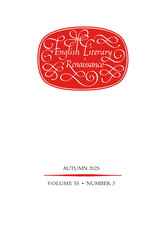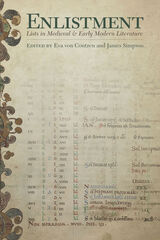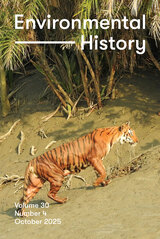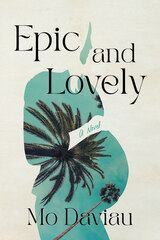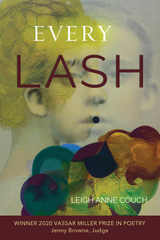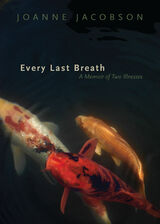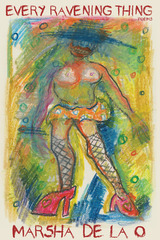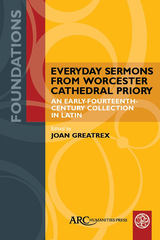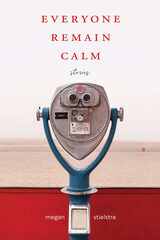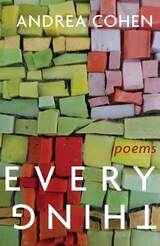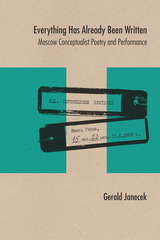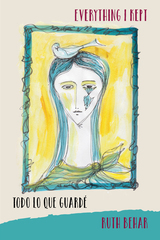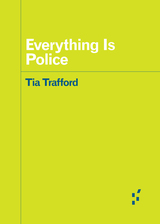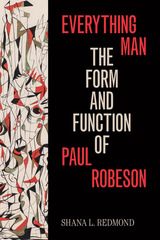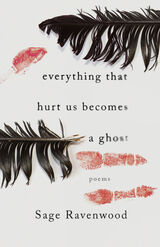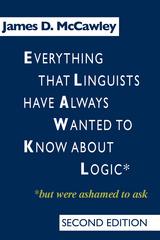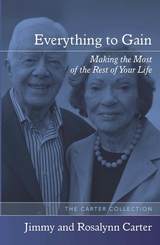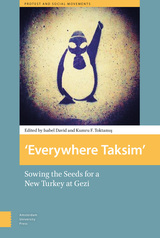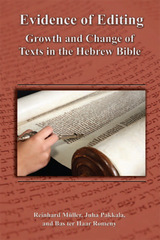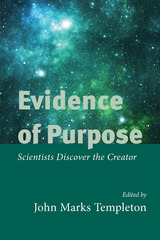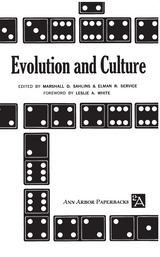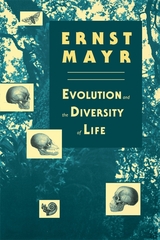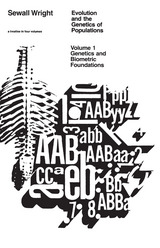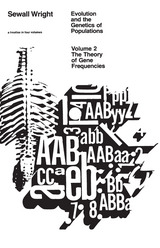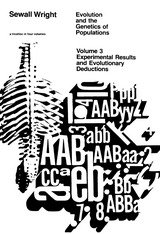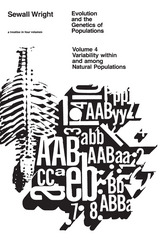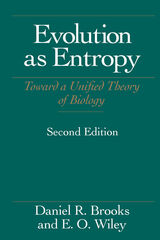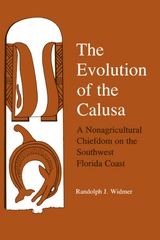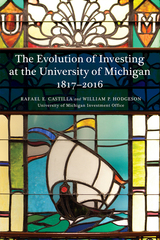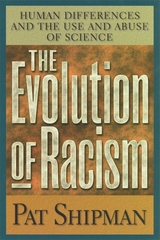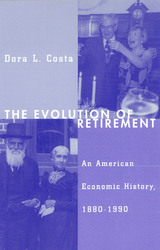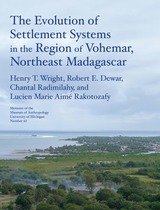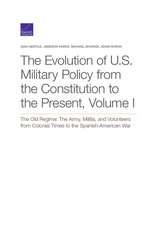 Every Hour of the Light: The Paintings of Mary Sipp Green
Beth Venn
The Artist Book Foundation, 2014 American landscape painter Mary Sipp Green, based in the bucolic Berkshire Hills of Massachusetts, has a superlative ability to engage the viewer in the emotive atmosphere of her landscapes and seascapes. The intensely saturated colors in her works evoke an immediate sense of place and a unique perspective on an intimate tableau. Sipp Green achieves an ethereal, nuanced quality in her paintings that imparts a refined and inimitable serenity. In Every Hour of the Light: The paintings of Mary Sipp Green, many of the subjects she paints—salt marshes, barns, meadows, rivers, and the occasional cityscape—are captured in the exquisite twilight of early evenings or a luminescent sunrise. The effect is dreamy yet grounded and familiar.
Sipp Green states, “While my preferred medium has always been oil on linen, my methods, techniques, and aesthetic aims have all undergone significant transformations since I first began. I learned my craft in the studio, painting still lifes and portraits, as well as landscapes drawn directly from nature. Over time, I became increasingly engaged with more abstract and spiritual aspects of the landscape form and I began to pursue a less representational, more expressive style.” When describing her “diffuse quality of color,” she explains, “I use many layers of paint, allowing each to dry before the next is applied. Along the way, the surface of the paint is often refigured in unpredictable ways, and there is much that has to be scraped, sanded, destroyed and reapplied before the essence of a place, its mood and atmosphere, finally emerges onto the canvas.”
Sipp Green’s work is widely collected in prominent private and public collections, including the D’Amour Museum of Fine Arts, part of the Springfield Museum of Art quadrangle in Springfield, Massachusetts, where her large oil painting Twilight Falls in South County hangs in the museum’s entryway, and The Butler Institute of American Art, Youngstown, Ohio.
Every Human Love: Stories
Joanna Pearson
Acre Books, 2019 The fourteen stories in Every Human Love redefine our sense of reality. Set seemingly in the quotidian, these tales veer into the unexpected, the uncomfortable, occasionally the eerie, thrusting characters in crisis into still greater quandaries, where the world of weddings and work, of frustrated hopes and mundane dissatisfactions, collides with a realm of legend, of fairy tale, of nightmare.
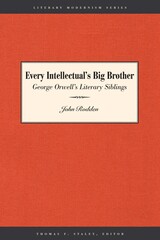 Every Intellectual's Big Brother: George Orwell's Literary Siblings
By John Rodden
University of Texas Press, 2006 George Orwell has been embraced, adopted, and co-opted by everyone from the far left to the neoconservatives. Each succeeding generation of Anglo-American intellectuals has felt compelled to engage the life, work, and cultural afterlife of Orwell, who is considered by many to have been the foremost political writer of the twentieth century. Every Intellectual's Big Brother explores the ways in which numerous disparate groups, Orwell's intellectual "siblings," have adapted their views of Orwell to fit their own agendas and how in doing so they have changed our perceptions of Orwell himself. By examining the politics of literary reception as a dimension of cultural history, John Rodden gives us a better understanding of Orwell's unique and enduring role in Anglo-American intellectual life. In Part One, Rodden opens the book with a section titled "Their Orwell, Left and Right," which focuses on Orwell's reception by several important literary circles of the latter half of the twentieth century. Beginning with Orwell's own contemporaries, Rodden addresses the ways various intellectual groups of the 1950s responded to Orwell. Rodden then moves on in Part Two to what he calls the "Orwell Confraternity Today," those contemporary intellectuals who have, in various ways, identified themselves with or reacted against Orwell. The author concludes by examining how Orwell's status as an object of admiration and detraction has complicated the way in which he has been perceived by readers since his death.
Every Lash
Leigh Anne Couch
University of North Texas Press, 2021
Every Last Breath: A Memoir of Two Illnesses
Joanne Jacobson
University of Utah Press, 2020 When Joanne Jacobson’s writing about her mother’s respiratory illness was interrupted by her own diagnosis with a rare blood disorder, she found her perspective profoundly altered. Every Last Breath follows these two chronic illnesses as they grow unexpectedly intertwined. Rejecting a fixed, retrospective point of view and the forward-moving trajectory of conventional memoir, Jacobson brings the reader to the emotionally raw present—where potentially fatal illness and “end of life” both remain, emphatically, life. As chronic illness blurs the distinction between illness and wellness, she discovers how a lifetime of relapse and remission can invite transformation. Written at the fluid, unsettling boundary between prose and poetry, these essays offer a narrative diagnosis of ongoing revision.
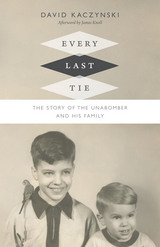 Every Last Tie: The Story of the Unabomber and His Family
David Kaczynski
Duke University Press, 2016 In August 1995 David Kaczynski's wife Linda asked him a difficult question: "Do you think your brother Ted is the Unabomber?" He couldn't be, David thought. But as the couple pored over the Unabomber's seventy-eight-page manifesto, David couldn't rule out the possibility. It slowly became clear to them that Ted was likely responsible for mailing the seventeen bombs that killed three people and injured many more. Wanting to prevent further violence, David made the agonizing decision to turn his brother in to the FBI. Every Last Tie is David's highly personal and powerful memoir of his family, as well as a meditation on the possibilities for reconciliation and maintaining family bonds. Seen through David's eyes, Ted was a brilliant, yet troubled, young mathematician and a loving older brother. Their parents were supportive and emphasized to their sons the importance of education and empathy. But as Ted grew older he became more and more withdrawn, his behavior became increasingly erratic, and he often sent angry letters to his family from his isolated cabin in rural Montana. During Ted's trial David worked hard to save Ted from the death penalty, and since then he has been a leading activist in the anti–death penalty movement. The book concludes with an afterword by psychiatry professor and forensic psychiatrist James L. Knoll IV, who discusses the current challenges facing the mental health system in the United States as well as the link between mental illness and violence.
 Every Person's Guide to Antioxidants
Smythies, John
Rutgers University Press, 1998 What are antioxidants? What do they do? Should you be taking them? How much is enough, or too much? Dr. John Smythies explores these and other questions you need to have answered about antioxidants in Every Person's Guide to Antioxidants.
Oxidants are naturally occuring chemicals in our bodies that derive from oxygen to facilitate essential biochemical processes. However, most oxidants are potentially toxic molecules and the body contains a number of antioxidants for protection against these toxic effects. Overproduction of oxidants, or underproduction of antioxidants, leads to oxidative stress, which has been linked to a wide range of chronic diseases, including heart disease, cancer, diabetes, and Alzheimer's. Smythies thoroughly evaluates current scientific work on this subject and suggests that a high proportion of many of these diseases can be prevented, or their onset delayed, by proper intake of antioxidants. He examines the pros and cons of the debate over how this necessary intake should be achieved, by eating more fruits and vegetables or by taking supplements in pill form. Smythies surveys the toxicity of antioxidants and recommends under what circumstances they should be given with caution or not at all. He also discusses whether taking supplements requires medical supervision and lists good sources of antioxidants in fruits and vegetables
 Every Person's Guide to Antioxidants
John Smythies, M.D. F.R.C.P.
Rutgers University Press, 1998 What are antioxidants? What do they do? Should you be taking them? How much is enough, or too much? Dr. John Smythies explores these and other questions you need to have answered about antioxidants in Every Person's Guide to Antioxidants.
Oxidants are naturally occuring chemicals in our bodies that derive from oxygen to facilitate essential biochemical processes. However, most oxidants are potentially toxic molecules and the body contains a number of antioxidants for protection against these toxic effects. Overproduction of oxidants, or underproduction of antioxidants, leads to oxidative stress, which has been linked to a wide range of chronic diseases, including heart disease, cancer, diabetes, and Alzheimer's. Smythies thoroughly evaluates current scientific work on this subject and suggests that a high proportion of many of these diseases can be prevented, or their onset delayed, by proper intake of antioxidants. He examines the pros and cons of the debate over how this necessary intake should be achieved, by eating more fruits and vegetables or by taking supplements in pill form. Smythies surveys the toxicity of antioxidants and recommends under what circumstances they should be given with caution or not at all. He also discusses whether taking supplements requires medical supervision and lists good sources of antioxidants in fruits and vegetables
 Every Place on the Map Is Disabled: Poems and Essays
Camisha L. Jones, Michael Northen, Naomi Ortiz, and Travis Chi Wing Lau
Northwestern University Press, 2026 An anthology of poems and essays by and celebrating Disabled writers
Declaring that Disabled people exist, innovate, thrive, and persevere, Every Place on the Map Is Disabled imagines the world we deserve. Its contributors spotlight the wisdom Disabled people embody from living within and navigating the economic and medical systems, communities, and families that often oppress their existence. This anthology is an intersectional compass pointing to the creative ways Disabled people build bridges to each other through Disability poetics and perspectives.
The contributing poets write about love, resistance, loss, pain, beauty, and culture. They capture tender and life-affirming moments where one Disabled person recognizes themself in another. The essays illustrate how Disability poetics suggest avenues for embracing the full spectrum of disability experiences. Every Place on the Map Is Disabled offers students, scholars, members of disability communities, and any reader a direction for paving a wider path toward a collective survival.
Every Ravening Thing: Poems
Marsha de la O
University of Pittsburgh Press, 2019 "Every Ravening Thing is the most exciting book I’ve read in a very long time." —Chase Twichell
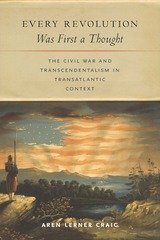 Every Revolution Was First a Thought: The Civil War and Transcendentalism in Transatlantic Context
Aren Lerner Craig
University of Massachusetts Press, 2025 Tracing the impact of transcendental philosophy on Union soldiers and their loved ones during the American Civil War
Scholars of the American Civil War have long wondered about the seemingly earnest and sincere sentimental commitment that most Northern soldiers had to their nation and the North’s cause. Unlike many others in other wars, Union soldiers appeared to embrace the war with an unusual conviction and sacrificed their lives with a rare nobility. Their grieving relatives were also buoyed up by their steadfast beliefs in the righteousness of the cause. What was so different about this war, and this period of American history, and what encouraged such an outlook?
In Every Revolution was First a Thought, Aren Lerner Craig argues that in the Civil War era the American Transcendentalist movement provided a coherent worldview that fostered powerful idealism around issues of character, gender, race, and nationhood, even in the worst of times. Through an exploration of diaries, newspaper editorials, popular songs, and more, Craig demonstrates how Transcendentalist thought moved from elite intellectual circles to the public, providing people a firm belief in the power of individual agency to shape the world and a view of spirituality in which each person was divine, and thus beyond death and destruction. Transcendentalist tenets proved strong enough to withstand the devastation of war and inspired high levels of faith and optimism in soldiers and civilians alike throughout the conflict.
Craig traces the origins of Transcendentalism across the Atlantic, to ideas from Scottish Realism and German Idealism, and connects these philosophies to writings and speeches of major figures like Ralph Waldo Emerson, Henry David Thoreau, and Margaret Fuller. This intellectual history offers a new interpretation of Transcendental thought and its role in the Civil War.
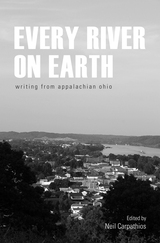 Every River on Earth: Writing from Appalachian Ohio
Neil Carpathios
Ohio University Press, 2015 Every River on Earth: Writing from Appalachian Ohio includes some of the best regional poetry, fiction, and creative nonfiction from forty contemporary writers, both established and up-and-coming. The wide range of material from authors such as David Baker, Don Bogen, Michelle Burke, Richard Hague, Donald Ray Pollock, and others, offers the reader a window into daily life in the region. The people, the landscape, the struggles, and the deepest undercurrents of what it means to be from and of a place are revealed in these original, deeply moving, and sometimes shocking pieces.
The book is divided into four sections: Family & Folks, The Land, The Grind, and Home & Away, each of which explores a different aspect of the place that these authors call home. The sections work together beautifully to capture what it means to live, to love, and to die in this particular slice of Appalachia. The writing is accessible and often emotionally raw; Every River on Earth invites all types of readers and conveys a profound appreciation of the region’s character.
The authors also offer personal statements about their writing, allowing the reader an intimate insight into their processes, aesthetics, and inspirations. What is it to be an Appalachian? What is it to be an Appalachian in Ohio? This book vividly paints that picture.
Every River on Earth
David Lee Garrison
I look out the window and see
through the neighbor’s window
to an Amish buggy
where three children are peeping back,
and in their eyes I see the darkness
of plowed earth hiding seed.
Wind pokes the land in winter,
trying to waken it,
and in the melting snow
I see rainbows and in them
every river on earth. I see all the way
to the ocean, where sand and stones
embrace each falling wave
and reach back to gather it in.
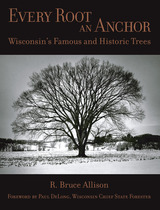 Every Root an Anchor: Wisconsin's Famous and Historic Trees
R. Bruce Allison
Wisconsin Historical Society Press, 2005 In Every Root an Anchor, writer and arborist R. Bruce Allison celebrates Wisconsin's most significant, unusual, and historic trees. More than one hundred tales introduce us to trees across the state, some remarkable for their size or age, others for their intriguing histories. From magnificent elms to beloved pines to Frank Lloyd Wright's oaks, these trees are woven into our history, contributing to our sense of place. They are anchors for time-honored customs, manifestations of our ideals, and reminders of our lives' most significant events. For this updated edition, Allison revisits the trees' histories and tells us which of these unique landmarks are still standing. He sets forth an environmental message as well, reminding us to recognize our connectedness to trees and to manage our tree resources wisely. As early Wisconsin conservationist Increase Lapham said, "Tree histories increase our love of home and improve our hearts. They deserve to be told and remembered."
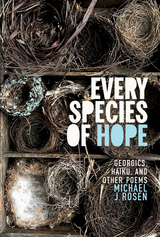 Every Species of Hope: Georgics, Haiku, and Other Poems
Michael J. Rosen
Ohio State University Press, 2017 In his first book of poetry in twenty years, Michael J. Rosen captures life in the foothills of the Appalachians. Every Species of Hope: Georgics, Haiku, and Other Poems uses a variety of poetic forms, as well as Rosen’s own pen-and-ink drawings, to give voice to the predicaments of living among other creatures who share a plot of land we think we claim as home. The poems are an attempt at homeostasis: that balancing act every creature works at every hour of every day—a way of living peacefully, expending the right energy in the most productive ways, avoiding or deflecting trouble, gravitating toward sources of fulfillment and contentment.
At the center of this book is a suite of poems inspired by Virgil’s Georgics, or “poems of pastoral instruction.” In Rosen’s case, he is more the student than the teacher. Likewise, five short sections of haiku continue his meditation on—or mediation of—art and nature. As he has written, “Haiku provides a brief and mirror-like calm in the choppy waters—in the undertow—of current events: a stillness in time where more than our singular lives can be reflected.”
Illustrated with two dozen pages from the author’s own journal, Every Species of Hope is the consummation of decades of observation, humility, and awe.
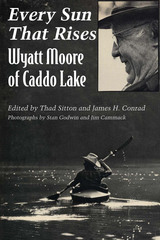 Every Sun That Rises: Wyatt Moore of Caddo Lake
Edited by Thad Sitton and James H. Conrad
University of Texas Press, 1985 “What I done and what I been accused of covers everything, you put ’em both together.” Wyatt Moore of Caddo Lake exaggerates, but perhaps not very much. During his long life at Caddo Lake, Moore was at various times a boat operator, commercial fisherman, boat builder, farmer, fishing and hunting camp operator, guide, commercial hunter, trapper, raftsman, moonshiner, oil field worker, water well driller, and mechanical jack-of-all-trades. Still, he always found time for his lifelong study of the natural and human history of Caddo Lake. Here, in words as fresh and forceful as the day they were uttered, is his tale. Moore, who was given the gift of a unique story to tell and great power to tell it, was the historical interpreter of his strange homeland of Caddo Lake. Twenty-three miles long, some forty thousand acres at high water, stretching across two Texas counties and one Louisiana parish, Caddo Lake’s fresh waters merge into a labyrinthine swamp punctuated by inlets, holes, and geological oddities like Goat Island, Whistleberry Slough, Whangdoodle Pass, and the Devil’s Elbow. Here among these lost reminders of steamboats and old bateau men is Moore’s world. Born in 1901 at Karnack, Texas, Moore grew up in a time when kids wore button shoes and in a place where pigs and chickens roamed the backyard. He drank his first whiskey at age eight, gigged fish, trapped, and hunted for pearls as a boy, and grew up to an easy assurance on the lake that comes only to those long accustomed to its ways. A walking library of the history of Caddo Lake, Moore delved into almost every nook and corner of it, and wherever he went, whatever he did, he sought to learn more about his subect. Sought out by writers and journalists—among them James Michener and Bill Moyers—because of his laconic wit and remarkable command of the region’s story, Moore became known as a resource as precious as the lake itself. Moore’s story is eloquently introduced by Thad Sitton in an opening essay that chronicles the history of Caddo Lake. Striking photographs of Moore at home and at work on the lake beautifully amplify his life story, and an exuberant word-and-picture essay of Moore expertly building the traditional boat of the region, a bateau, reinforces the vivid image we have of this remarkable man.
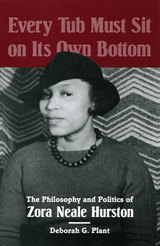 Every Tub Must Sit on Its Own Bottom: The Philosophy and Politics of Zora Neale Hurston
Deborah G. Plant
University of Illinois Press, 1995 "Plant's study is sorely
needed at this point in the evolving critical assessment of Hurston. It
is a paradigm for the study of individual African American women writers."
-- Alice Deck, University of Illinois at Urbana-Champaign
In a ground-breaking study
of Zora Neale Hurston, Deborah Plant takes issue with current notions
of Hurston as a feminist and earlier impressions of her as an intellectual
lightweight who disregarded serious issues of race in American culture.
Instead, Plant calls Hurston a "writer of resistance" who challenged
the politics of domination both in her life and in her work. One of the
great geniuses of the Harlem Renaissance, Hurston stands out as a strong
voice for African-American women. Her anthropological inquiries as well
as her evocative prose provide today's readers with a rich history of
African American folk culture, a folk culture through which Hurston expressed
her personal and political strategy of resistance and self-empowerment.
Through readings of Hurston's
fiction and autobiographical writings, Plant offers one of the first book-length
discussions of Hurston's personal philosophy of individualism and self-preservation.
From a discussion of Hurston's preacher father and influential mother,
whose guiding philosophy is reflected in the title of this book, to the
influence of Spinoza and Nietzsche, Plant puts into perspective the driving
forces behind Hurston's powerful prose.
This fresh look at one of
the most important writers of the twentieth century is sure to shape future
study of Hurston and her work.
 Every Woman's Guide to Diabetes: What You Need to Know to Lower Your Risk and Beat the Odds
Stephanie A. Eisenstat M.D. and Ellen Barlow
Harvard University Press, 2007 Women have long needed a book devoted to their unique issues with diabetes. This up-to-date and practical guide advocates simple lifestyle changes that can help women reduce their risk of getting diabetes or, if already diagnosed, prevent the disease’s most serious complications. Every Woman’s Guide to Diabetes translates the latest findings from diabetes research into proven strategies busy women can use to stay healthy and gain control over an often overwhelming disease. The authors discuss the nature of diabetes, helping readers through the complex medical decisions involved in diabetes treatment. They highlight strategies to decrease the emotional stress and social isolation that often accompany diagnosis, and offer everyday techniques for managing blood sugar.
Key features include:
— Unique aspects of diabetes for women throughout the life cycle
— Timetable of recommended tests and check-ups
— Guide to medications with common dosages
— Charts to help organize diabetes-care tasks and supplies
— Time-management tips for better disease regulation
— Guide to contraceptives available to women with diabetes
— Review of issues critical to women before, during, and following pregnancy
— Advice for overcoming barriers to weight loss and exercise
— Plan for intelligent diet trade-offs while still enjoying meals
— Practical tips for planning exercise
— Strategies to avoid diabetes “burn-out”
Written by two physicians (one of whom is a woman living with diabetes) and an experienced medical writer, Every Woman’s Guide to Diabetes recognizes the power that women have in their households to effect lifestyle changes that will benefit themselves and loved ones, including their mothers, daughters, sisters, and partners. This power can reduce the toll of the diabetes epidemic.
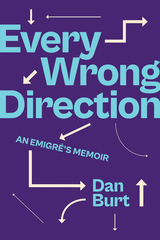 Every Wrong Direction: An Emigré’s Memoir
Dan Burt
Rutgers University Press, 2023 Every Wrong Direction recreates and dissects the bitter education of Dan Burt, an American émigré who never found a home in America. It begins in the row homes of Jewish immigrants and working-class Italians on the mean streets of 1950s South Philadelphia. Every Wrong Direction follows the author from the rough, working-class childhood that groomed him to be a butcher or charter boat captain, through America, Britain and Saudi Arabia as student, lawyer, spy, culture warrior, and expatriate, ending with a photo of his college rooms at St John’s College, Cambridge. Between this beginning and end, through a Philadelphia commuter college, to Cambridge, then Yale Law School, across the working to upper classes, three countries, and seven cities over 43 years, it maps his pursuit of, realization, disillusionment with and abandonment of America and the American Dream. Praise for Dan Burt's previous memoir, You Think It Strange:
“Burt’s early life was indeed a triumph of wit and will. He managed to escape a world filled with violence and a culture that valued street smarts over book smarts, all the while knowing that just about everyone around him thought little of his prospects. That he made it out at all is extraordinary. That he became a successful lawyer and writer is virtually unimaginable.” —Commonweal
“Dan Burt is a fine poet, and this memoir has all the sensitivity and vigilance you might expect from a writer with such a background. But his prose also has a robustness and documentary power that continually startles and engages. As it combines these things, You Think It Strange catches the strangeness of the world and makes it familiar.”
—Sir Andrew Motion, Poet Laureate of the United Kingdom, 1999-2009
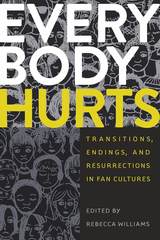 Everybody Hurts: Transitions, Endings, and Resurrections in Fan Cultures
Rebecca Williams
University of Iowa Press, 2018 Have you ever been a fan of a show that was canceled abruptly or that killed off a beloved character unexpectedly? Or perhaps it was rebooted after a long absence and now you’re worried it won’t be as good as the original? Anyone who has ever followed entertainment closely knows firsthand that such transitions can be jarring. Indeed, for truly loyal fans, the loss can feel very real—even throwing their own identity into question. Examining how fans respond to and cope with transitions, endings, or resurrections in everything from band breakups (R.E.M.) to show cancellations (Hannibal) to closing down popular amusement park rides, this collection brings together an eclectic mix of scholars to analyze the various ways fans respond to change. Essays explore practices such as fan discussion and creating alternative fan fictions, as well as cases where fans abandon their objects of interest completely and move on to new ones. Shedding light on how fans react, both individually and as a community, the contributors also trace the commonalities and differences present in fandoms across a range of media, and they pay close attention to the ways fandom operates across paratexts and transmedia forms including films, comics, and television. This fascinating approach promises to make an important contribution to the fields of fan, media, and cultural studies, and should appeal widely to students, scholars, and anyone else with a genuine interest in understanding why these transitions can have such a deep impact on fans’ lives.
Contributors: Stuart Bell, Anya Benson, Lucy Bennett, Paul Booth, Joseph Brennan, Kristina Busse, Melissa A. Click, Ruth Deller, Evelyn Deshane, Nichola Dobson, Simone Driessen, Emily Garside, Holly Willson Holladay, Bethan Jones, Nicolle Lamerichs, Kathleen Williams, Rebecca Williams
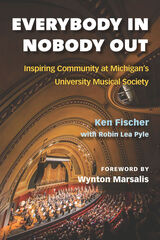 Everybody In, Nobody Out: Inspiring Community at Michigan's University Musical Society
Ken Fischer with Robin Lea Pyle
University of Michigan Press, 2020 Housed on the campus of the University of Michigan in Ann Arbor, the University Musical Society is one of the oldest performing arts presenters in the country. A past recipient of the National Medal of Arts, the nation’s highest public artistic honor, UMS connects audiences with wide-ranging performances in music, dance, and theater each season.Between 1987 and 2017, UMS was led by Ken Fischer, who over three decades pursued an ambitious campaign to expand and diversify the organization’s programming and audiences—initiatives inspired by Fischer’s overarching philosophy toward promoting the arts, “Everybody In, Nobody Out.”
The approach not only deepened UMS’s engagement with the university and southeast Michigan communities, it led to exemplary partnerships with distinguished artists across the world. Under Fischer’s leadership, UMS hosted numerous breakthrough performances, including the Vienna Philharmonic’s final tour with Leonard Bernstein, appearances by then relatively unknown opera singer Cecilia Bartoli, a multiyear partnership with the Royal Shakespeare Company, and artists as diverse as Yo-Yo Ma, Jawole Willa Jo Zollar, Elizabeth Streb, and Nusrat Fateh Ali Khan.
Though peppered with colorful anecdotes of how these successes came to be, this book is neither a history of UMS nor a memoir of Fischer’s significant accomplishments with the organization. Rather it is a reflection on the power of the performing arts to engage and enrich communities—not by handing down cultural enrichment from on high, but by meeting communities where they live and helping them preserve cultural heritage, incubate talent, and find ways to make community voices heard.
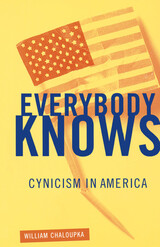 Everybody Knows: Cynicism in America
William Chaloupka
University of Minnesota Press, 2001 A witty take on what’s wrong--and right--with cynicism today, now in paperback! We are now living in the midst of the most cynical era in American history. Disaffection from government institutions is at an all-time high. Ordinary citizens perceive political leaders to be more manipulative and jaded than ever. Skepticism pervades our cultural and social attitudes and interactions, and is prominently featured in the films we see, the books we read, and the media we experience. In this biting and controversial analysis, William Chaloupka scrutinizes the cynicism that is our common condition, examining both its uses in the politics of backlash and resentment and its surprisingly positive aspects. Everybody Knows traces cynicism from its classical origins but emphasizes its recent emergence in American culture and politics, following a trajectory from H. L. Mencken to Richard Nixon to Bill Clinton to Fargo. Cutting neatly across ideological divisions, Chaloupka discusses the ways in which cynicism is rooted in all democratic politics and analyzes the role of the media-in particular, television news, political ads and speeches, and books such as E. J. Dionne’s Why Americans Hate Politics and William Bennett’s The Book of Virtues-in dissecting and encouraging cynicism.Chaloupka describes mass cynicism, which permeates popular culture; outsider cynicism, capable of cranky, even violent disruption; and the cynicism of those in power. He argues that those who issue broad pleas for civility or a renewal of community spirit usually misunderstand the cynicism they wish to treat. He also discusses the value of a cheeky, subversive “kynicism” to evoke the lively democratic practice American society must foster.Early reviews call Everybody Knows “original and compelling,” “pithy, engaging, and funny,” and “the best book on American politics in quite a while.” Sure to be widely read and debated, this entertaining book will inspire readers to take a new look at the cynicism prevalent in contemporary American society.
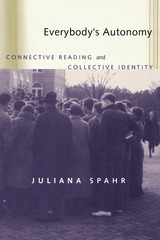 Everybody's Autonomy: Connective Reading and Collective Identity
Juliana Spahr
University of Alabama Press, 2001 Experimental texts empower the reader by encouraging self-governing approaches to reading and by placing the reader on equal footing with the author. Everybody's Autonomy is about reading and identity.
Contemporary avant garde writing has often been overlooked by those who study literature and identity. Such writing has been perceived as unrelated, as disrespectful of subjectivity. But Everybody's Autonomy instead locates within avant garde literature models of identity that are communal, connective, and racially concerned. Everybody's Autonomy, as it tackles literary criticism's central question of what sort of selves do works create, looks at works that encourage connection, works that present and engage with large, public worlds that are in turn shared with readers. With this intent, it aligns the iconoclastic work of Gertrude Stein with foreign, immigrant Englishes and their accompanying subjectivities. It examines the critique of white individualism and privilege in the work of language writers Lyn Hejinian and Bruce Andrews. It looks at how Harryette Mullen mixes language writing's open text with the distinctivesness of African-American culture to propose a communal, yet still racially conscious identity. And it examines Theresa Hak Kyung Cha's use of broken English and French to unsettle readers' fluencies and assimilating comprehensions, to decolonize reading. Such works, the book argues, well represent and expand changing notions of the public, of everybody.
 Everybody’s Family Romance: Reading Incest in Neoliberal America
Gillian Harkins
University of Minnesota Press, 2009 In the 1990s, a boom in autobiographical novels and memoirs about incest emerged, making incest one of the hottest topics to connect daytime TV talk shows, the self-help industry, and the literary publishing circuit. In Everybody's Family Romance, Gillian Harkins places this proliferation of incest literature at the center of transformations in the political and economic climate of the late twentieth century. Harkins's interdisciplinary approach reveals how women's narratives about incest were co-opted by-and yet retained resistant strains against-the cultural logics of the neoliberal state. Across chapters examining legal cases on recovered memory, popular journalism, and novels and memoirs by Dorothy Allison, Carolivia Herron, Kathryn Harrison, and Sapphire, Harkins demonstrates that incest narratives look backward into the past. In these accounts, images of incest forge links between U.S. chattel slavery and the distributive impasses of the welfare state and between decades-distant childhoods and emergent memories of the present. In contrast to recent claims that incest narratives eclipse broader frameworks of political and economic power, Harkins argues that their emergence exposes changing structural relations between the family and the nation and, in doing so, transforms the analyses of American familial sexual violence.
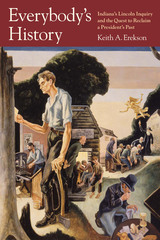 Everybody's History: Indiana's Lincoln Inquiry and the Quest to Reclaim a President's Past
Keith A. Erekson
University of Massachusetts Press, 2012 Revered by the public, respected by scholars, and imitated by politicians, Abraham Lincoln remains influential more than two hundred years after his birth. His memory has inspired books, monuments, and museums and also sparked controversies, rivalries, and forgeries. That so many people have been interested in Lincoln for so long makes him an ideal subject for exploring why history matters to ordinary Americans as well as to academic specialists.
In Everybody's History, Keith A. Erekson focuses on the Southwestern Indiana Historical Society—an organization composed of lawyers, historians, collectors, genealogists, teachers, college presidents, and newspaper editors—who joined together during the 1920s and 1930s to recover a part of Lincoln's life his biographers had long ignored: the years from age seven to twenty-one when he lived on the Indiana frontier. Participants in the "Lincoln Inquiry," as it was commonly known, researched old records, interviewed aging witnesses, hosted pageants, built a historical village, and presented their findings in public and in print. Along the way they defended their methods and findings against competitors in the fields of public history and civic commemoration, and rescued some of Indiana's own history by correcting a forgotten chapter of Lincoln's.
Everybody's History traces the development of popular interest in Lincoln to uncover the story of an extensive network of nonprofessional historians who contested old authorities and advanced new interpretations. In so doing, the book invites all who are interested in the past to see history as both vital to public life and meaningful to everybody.
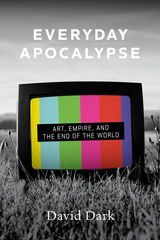 Everyday Apocalypse: Art, Empire, and the End of the World
David Dark
Vanderbilt University Press, 2025 Everyday Apocalypse recovers the root meaning of the term apocalypse (revelation) to use the concept as a lens through which art and other acts of creative nonviolence that often go unseen may be brought into focus. Interweaving an examination of popular culture with ancient insight and contemporary political awareness, Dark uses the concept of the apocalyptic to celebrate epiphanies about the world we live in and the meaning of human experience within it. Since its original publication in 2002, the book has become a deeply influential text among two generations of intellectual evangelical Christians who find themselves at odds with their families and communities over issues of politics and culture, particularly in the South.
This revised edition of the book includes an introduction by Hanif Abdurraqib, an extensive afterword, updates in light of the passage of time since its publication, and new insights from the author, whose outspokenness has placed him outside of circles in which he was once supported and celebrated.
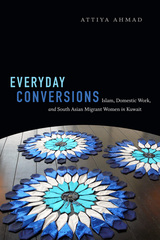 Everyday Conversions: Islam, Domestic Work, and South Asian Migrant Women in Kuwait
Attiya Ahmad
Duke University Press, 2017 Why are domestic workers converting to Islam in the Arabian Peninsula and Persian Gulf region? In Everyday Conversions Attiya Ahmad presents us with an original analysis of this phenomenon. Using extensive fieldwork conducted among South Asian migrant women in Kuwait, Ahmad argues domestic workers’ Muslim belonging emerges from their work in Kuwaiti households as they develop Islamic piety in relation—but not opposition—to their existing religious practices, family ties, and ethnic and national belonging. Their conversion is less a clean break from their preexisting lives than it is a refashioning in response to their everyday experiences. In examining the connections between migration, labor, gender, and Islam, Ahmad complicates conventional understandings of the dynamics of religious conversion and the feminization of transnational labor migration while proposing the concept of everyday conversion as a way to think more broadly about emergent forms of subjectivity, affinity, and belonging.
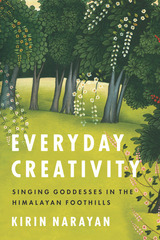 Everyday Creativity: Singing Goddesses in the Himalayan Foothills
Kirin Narayan
University of Chicago Press, 2016 Kirin Narayan’s imagination was captured the very first time that, as a girl visiting the Himalayas, she heard Kangra women join their voices together in song. Returning as an anthropologist, she became fascinated by how they spoke of singing as a form of enrichment, bringing feelings of accomplishment, companionship, happiness, and even good health—all benefits of the “everyday creativity” she explores in this book. Part ethnography, part musical discovery, part poetry, part memoir, and part unforgettable portraits of creative individuals, this unique work brings this remote region in North India alive in sight and sound while celebrating the incredible powers of music in our lives.
With rare and captivating eloquence, Narayan portrays Kangra songs about difficulties on the lives of goddesses and female saints as a path to well-being. Like the intricate geometries of mandalu patterns drawn in courtyards or the subtle balance of flavors in a meal, well-crafted songs offer a variety of deeply meaningful benefits: as a way of making something of value, as a means of establishing a community of shared pleasure and skill, as a path through hardships and limitations, and as an arena of renewed possibility. Everyday Creativity makes big the small world of Kangra song and opens up new ways of thinking about what creativity is to us and why we are so compelled to engage it.
 Everyday Democracy: Liberals, Conservatives, and Their Routine Political Lives
Jeffrey M. Berry, James M. Glaser and Deborah J. Schildkraut
University of Chicago Press, 2025 How the everyday habits and attitudes of ordinary liberals and conservatives shape the health of American democracy. In Everyday Democracy, Jeffrey M. Berry, James M. Glaser, and Deborah J. Schildkraut study Americans’ views of several manifestations of “everyday democracy,” which they define as the attitudes, behaviors, and processes that people experience in daily life and their routine considerations of politics and community. Examples include engaging in dialogue with political opponents and giving politicians license to compromise. Ordinary political moments like these constitute much of politics, and they can lay the foundation that shapes if, when, and how crisis moments unfold. Paying particular attention to the role of ideology in shaping how Americans emulate daily democratic ideals, this book considers such questions as: How do liberals and conservatives support different aspects of democratic practice, and are there ideological asymmetries between the two groups? If and when asymmetries emerge, what factors might explain them? The authors consider what their findings mean for the health of American democracy broadly.
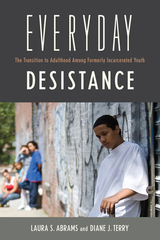 Everyday Desistance: The Transition to Adulthood Among Formerly Incarcerated Youth
Abrams, Laura S.
Rutgers University Press, 2017 Winner of the 2020 Society for Social Work and Research Book Award
In Everyday Desistance, Laura Abrams and Diane J. Terry examine the lives of young people who spent considerable time in and out of correctional institutions as adolescents. These formerly incarcerated youth often struggle with the onset of adult responsibilities at a much earlier age than their more privileged counterparts. In the context of urban Los Angeles, with a large-scale gang culture and diminished employment prospects, further involvement in crime appears almost inevitable. Yet, as Abrams and Terry point out, these formerly imprisoned youth are often quite resilient and can be successful at creating lives for themselves after months or even years of living in institutions run by the juvenile justice system.
This book narrates the day-to-day experiences of these young men and women, focusing on their attempts to surmount the challenges of adulthood, resisting a return to criminal activity, and formulating long-term goals for a secure adult future.
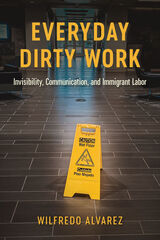 Everyday Dirty Work: Invisibility, Communication, and Immigrant Labor
Wilfredo Alvarez
Ohio State University Press, 2022 Winner, 2023 NCA Ethnography Division Best Book Award
Wilfredo Alvarez’s Everyday Dirty Work: Invisibility, Communication, and Immigrant Labor is an exploration into co-cultural communication practices within the workplace. Specifically, Alvarez investigates how Latin American immigrant janitors communicate from their marginalized standpoints in a predominantly White academic organization. He examines how custodial workers perceive, interpret, and thematize routine messages regarding race, ethnicity, social class, immigrant status, and occupation, and how those messages and overall communicative experiences affect both their work and personal lives. A Latin American immigrant himself, Alvarez relates his own experiences to those of the research participants. His positionality informs and enhances his research as he demonstrates how everyday interpersonal encounters create discursive spaces that welcome or disqualify people based on symbolic and social capital. Alvarez offers valuable insights into the lived experiences of critical––but often undervalued and invisible––organizational members. Through theoretical insights and research data, he provides practical recommendations for organizational leaders to improve how they can relate to and support all stakeholders.
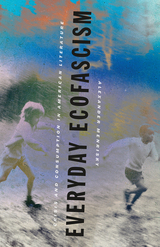 Everyday Ecofascism: Crisis and Consumption in American Literature
Alexander Menrisky
University of Minnesota Press, 2025 A timely look into how fascist ideas permeate contemporary culture well beyond the far right
As challenges posed by climate change have intensified in the twenty-first century, right-wing figures in the United States and abroad have increasingly framed anti-immigrant, anti-Indigenous, and white-supremacist sentiments in terms of environmental survival. Everyday Ecofascism explores the insidious nature of this tendency, revealing how permutations of these perspectives in fact resonate across the political spectrum. Drawing on comparative studies of fascism writ large, Alexander Menrisky demonstrates that ecofascism is best understood not as a uniquely right-wing ideology but as a political genre that reinforces white supremacy and other forms of domination. Presenting a view of fascism as a complex power network that plays out on scales both large and small, Menrisky shows how extremist sentiments have crept into everyday language, stories, and ideas. Through a literary and cultural studies lens, he illuminates ecofascism’s narrative patterns and their easy permeation of environmentalist discourses, from back-to-the-land movements to the resurgence of psychedelic drugs, food localism, and pandemic politics. Opposite his analysis of ecofascism in action, Menrisky sheds important light on narrative resistances to dominant conceptions of race, nation, and territory by Native, queer, and women-of-color writers who have countered ethnonationalism for generations. Bridging past and present, Menrisky powerfully nails down the emergent concept of ecofascism and forms a basis for understanding phenomena like Covid-19, ecological utopianism, and psychedelic environmentalism that detangles ecofascist tendencies from justice-oriented visions of place-based belonging. Retail e-book files for this title are screen-reader friendly.
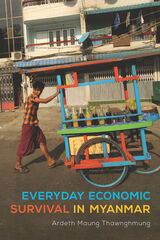 Everyday Economic Survival in Myanmar
Ardeth Maung Thawnghmung
University of Wisconsin Press, 2022 Reforms in Myanmar (formerly Burma) have eased restrictions on citizens' political activities. Yet for most Burmese, Ardeth Maung Thawnghmung shows, eking out a living from day to day leaves little time for civic engagement. Citizens have coped with extreme hardship through great resourcefulness. But by making bad situations more tolerable in the short term, these coping strategies may hinder the emergence of the democratic values needed to sustain the country's transition to a more open political environment.
Thawnghmung conducted in-depth interviews and surveys of 372 individuals from all walks of life and across geographical locations in Myanmar between 2008 and 2015. To frame her analysis, she provides context from countries with comparable political and economic situations. Her findings will be welcomed by political scientists and policy analysts, as well by journalists and humanitarian activists looking for substantive, reliable information about everyday life in a country that remains largely in the shadows.
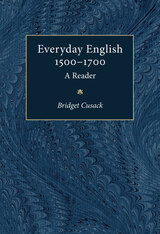 Everyday English 1500-1700: A Reader
Bridget Cusack, Editor
University of Michigan Press, 1998 What kind of language did ordinary men and women use in the seventeenth century? Everyday English 1500-1700 addresses this question by bringing together and explaining more than sixty nonliterary texts from the early modern period, ranging from witnesses' depositions to church wardens' accounts, and from letters and journals to constables' presentments and scurrilous abuse shouted in the marketplace.
This unique source book of essential documents designed for courses on Early Modern English is designed as a teaching text with full guidance to each text, including glossary, explanatory and background notes, and suggested topics for linguistic evaluation. Everyday English takes an up-to-the-minute approach by focusing on language as it was used and spoken at the time.
This wide-ranging collection for the first time makes available to students a corpus of examples of the ordinary, nonstandard language of the man and woman in the street, coming from areas as diverse as England, Scotland, and America. The emphasis throughout is on providing as much assistance as possible to the reader to aid understanding and appreciation of both the linguistic features and the everyday lifestyles of the time.
"The only book a really conscientious teacher of the history and structure of Early Modern English would use for source texts." --Roger Lass, University of Cape Town
Bridget Cusack was lecturer in English Language, University of Edinburgh.
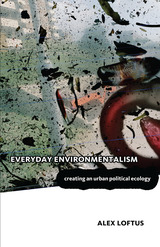 Everyday Environmentalism: Creating an Urban Political Ecology
Alex Loftus
University of Minnesota Press, 2012 Everyday Environmentalism develops a conversation between marxist theories of everyday life and recent work in urban political ecology, arguing for a philosophy of praxis in relation to the politics of urban environments. Grounding its theoretical debate in empirical studies of struggles to obtain water in the informal settlements of Durban, South Africa, as well as in the creative acts of insurgent art activists in London, Alex Loftus builds on the work of key marxist thinkers to redefine “environmental politics.” A marxist philosophy of praxis—that world-changing ideas emerge from the acts of everyday people—undergirds the book. Our daily reality, writes Loftus, is woven out of the entanglements of social and natural relations, and as such a kind of environmental politics is automatically incorporated into our lives. Nevertheless, one effect of the public recognition of global environmental change, asserts Loftus, has been a resurgence of dualistic understandings of the world: for example, that nature is inflicting revenge on arrogant human societies. This ambitious work reformulates—with the assistance of such philosophers as Lukács, Gramsci, Lefebvre, and others—a politics of the environment in which everyday subjectivity is at the heart of a revolutionary politics.
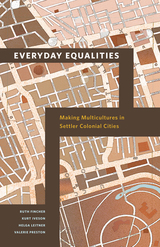 Everyday Equalities: Making Multicultures in Settler Colonial Cities
Ruth Fincher
University of Minnesota Press, 2019 A timely new look at coexisting without assimilating in multicultural cities
If city life is a “being together of strangers,” what forms of being together should we strive for in cities with ethnic and racial diversity? Everyday Equalities seeks evidence of progressive political alternatives to racialized inequality that are emerging from everyday encounters in Los Angeles, Melbourne, Sydney, and Toronto—settler colonial cities that, established through efforts to dispossess and eliminate indigenous societies, have been destinations for waves of immigrants from across the globe ever since.
Everyday Equalities finds such alternatives being developed as people encounter one another in the process of making a home, earning a living, moving around the city, and forming collective actions or communities. Here four leading scholars in critical urban geography come together to deliver a powerful and cohesive message about the meaning of equality in contemporary cities. Drawing on both theoretical reflection and urban ethnographic research, they offer the formulation “being together in difference as equals” as a normative frame to reimagine the meaning and pursuit of equality in today’s urban multicultures. As the examples in Everyday Equalities indicate, much emotional labor, combined with a willingness to learn from each other, negotiate across differences, and agitate for change goes into constructing environments that foster being together in difference as equals. Importantly, the authors argue, a commitment to equality is not only a hope for a future city but also a way of being together in the present.
Everyday Erotics: Older Chinese Women and Same-Sex Desire
Denise Tse-Shang Tang
Duke University Press, 2026 In Everyday Erotics, Denise Tse-Shang Tang explores the lives of older women with same-sex desire in Hong Kong, Singapore, and Taiwan. Tang interviews women born in the 1930’s through the 1960’s, looking at how their lives differ across culture, class, and place, and how they lived and understood their own desires and social worlds. Through these tales of love, intimacy, family obligations, and personal respectability, she presents narrative accounts and analyses that complicate cultural notions of romance and desire at the intersections of gender roles, social class, and history. An ethnography grounded in inter-Asian cultural flows and connected histories, Everyday Erotics builds an archive of queer women’s lives and a genealogy of their experiences.
Everyday Ethics: Moral Theology and the Practices of Ordinary Life
Michael Lamb and Brian A. Williams, Editors
Georgetown University Press, 2023 What might we learn if the study of ethics focused less on hard cases and more on the practices of everyday life? In Everyday Ethics, Michael Lamb and Brian Williams gather some of the world’s leading scholars and practitioners of moral theology (including some GUP authors) to explore that question in dialogue with anthropology and the social sciences. Inspired by the work of Michael Banner, these scholars cross disciplinary boundaries to analyze the ethics of ordinary practices—from eating, learning, and loving thy neighbor to borrowing and spending, using technology, and working in a flexible economy. Along the way, they consider the moral and methodological questions that emerge from this interdisciplinary dialogue and assess the implications for the future of moral theology.
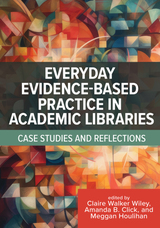 Everyday Evidence-Based Practice in Academic Libraries: Case Studies and Reflections
Clare Walker Wiley
Association of College & Research Libraries, 2023 Evidence-based practice (EBP) in academic librarianship is embedded in the way we approach our work. An EBP project might be a yearlong study with many types of evidence collected or a simple assessment that helps you make a small adjustment to your work. Large or small, EBP is a way of operating day-to-day. Everyday Evidence-Based Practice in Academic Libraries: Case Studies and Reflections collects excellent, thorough examples of EBP across functional areas of academic libraries and includes many evidence types in a variety of contexts. Five sections explore: - Understanding Users
- Leadership and Management
- Instruction and Outreach
- Collections
- Open Initiatives
Chapters include studies on how to understand the experiences and needs of diverse student populations; interviewing faculty to build scholarly partnerships; evidence-based strategic planning; incorporating intersectionality in information literacy instruction; conducting a diversity audit; and assessing open educational resources initiatives. The conclusion calls for librarian reflection to be incorporated into evidence-based decision-making, as reflection is key to understanding the ways that a librarian chooses to embody librarianship. Everyday Evidence-Based Practice in Academic Libraries offers high-quality evidence from a variety of perspectives and inspires a commitment to evidence-based practice in your day-to-day work and library culture.
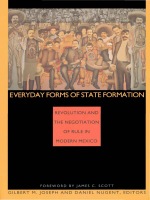 Everyday Forms of State Formation: Revolution and the Negotiation of Rule in Modern Mexico
Gilbert M. Joseph and Daniel Nugent, eds.
Duke University Press, 1994 Everyday Forms of State Formation is the first book to systematically examine the relationship between popular cultures and state formation in revolutionary and post-revolutionary Mexico. While most accounts have emphasized either the role of peasants and peasant rebellions or that of state formation in Mexico’s past, these original essays reveal the state’s day-to-day engagement with grassroots society by examining popular cultures and forms of the state simultaneously and in relation to one another. Structured in the form of a dialogue between a distinguished array of Mexicanists and comparative social theorists, this volume boldly reassesses past analyses of the Mexican revolution and suggests new directions for future study. Showcasing a wealth of original archival and ethnographic research, this collection provides a new and deeper understanding of Mexico’s revolutionary experience. It also speaks more broadly to a problem of extraordinary contemporary relevance: the manner in which local societies and self-proclaimed "revolutionary" states are articulated historically. The result is a unique collection bridging social history, anthropology, historical sociology, and cultural studies in its formulation of new approaches for rethinking the multifaceted relationship between power, culture, and resistance. Contributors. Ana María Alonso, Armando Bartra, Marjorie Becker, Barry Carr, Philip Corrigan, Romana Falcón, Gilbert M. Joseph, Alan Knight, Florencia E. Mallon, Daniel Nugent, Elsie Rockwell, William Roseberry, Jan Rus, Derek Sayer, James C. Scott
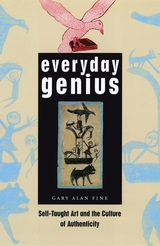 Everyday Genius: Self-Taught Art and the Culture of Authenticity
Gary Alan Fine
University of Chicago Press, 2004 From Henry Darger's elaborate paintings of young girls caught in a vicious war to the sacred art of the Reverend Howard Finster, the work of outsider artists has achieved unique status in the art world. Celebrated for their lack of traditional training and their position on the fringes of society, outsider artists nonetheless participate in a traditional network of value, status, and money. After spending years immersed in the world of self-taught artists, Gary Alan Fine presents Everyday Genius, one of the most insightful and comprehensive examinations of this network and how it confers artistic value. Fine considers the differences among folk art, outsider art, and self-taught art, explaining the economics of this distinctive art market and exploring the dimensions of its artistic production and distribution. Interviewing dealers, collectors, curators, and critics and venturing into the backwoods and inner-city homes of numerous self-taught artists, Fine describes how authenticity is central to the system in which artists—often poor, elderly, members of a minority group, or mentally ill—are seen as having an unfettered form of expression highly valued in the art world. Respected dealers, he shows, have a hand in burnishing biographies of the artists, and both dealers and collectors trade in identities as much as objects. Revealing the inner workings of an elaborate and prestigious world in which money, personalities, and values affect one another, Fine speaks eloquently to both experts and general readers, and provides rare access to a world of creative invention-both by self-taught artists and by those who profit from their work. “Indispensable for an understanding of this world and its workings. . . . Fine’s book is not an attack on the Outsider Art phenomenon. But it is masterful in its anatomization of some of its contradictions, conflicts, pressures, and absurdities.”—Eric Gibson, Washington Times
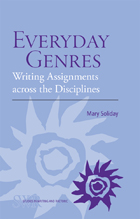 Everyday Genres: Writing Assignments across the Disciplines
Mary Soliday
Southern Illinois University Press, 2011 In Everyday Genres: Writing Assignments across the Disciplines, Mary Soliday calls on genre theory- which proposes that writing cannot be separated from social situation-to analyze the common assignments given to writing students in the college classroom, and to investigate how new writers and expert readers respond to a variety of types of coursework in different fields. This in-depth study of writing pedagogy looks at many challenges facing both instructors and students in college composition classes, and offers a thorough and refreshing exploration of writing experience, ability, and rhetorical situation. Soliday provides an overview of the contemporary theory and research in Writing across the Curriculum programs, focusing specifically on the implementation of the Writing Fellows Program at the City College of New York. Drawing on her direct observations of colleagues and students at the school, she addresses the everyday challenges that novice writers face, such as developing an appropriate "stance" in one's writing, and the intricacies of choosing and developing content. The volume then goes on to address some of the most pressing questions being asked by teachers of composition: To what extent can writing be separated from its situation? How can rhetorical expertise be shared across fields? And to what degree is writing ability local rather than general? Soliday argues that, while writing is closely connected to situation, general rhetorical principles can still be capably applied if those situations are known. The key to improving writing instruction, she maintains, is to construct contexts that expose writers to the social actions that genres perform for readers. Supplementing the author's case study are six appendixes, complete with concrete examples and helpful teaching tools to establish effective classroom practices and exercises in Writing across the Curriculum programs. Packed with useful information and insight, Everyday Genres is an essential volume for both students and teachers seeking to expand their understanding of the nature of writing.
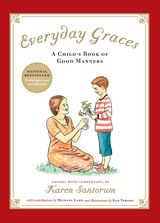 Everyday Graces: Child's Book Of Good Manners
Karen Santorum
Intercollegiate Studies Institute, 2003
The National Bestseller, Featuring a Brand-New Introduction by Karen Santorum
As a mother, Karen Santorum grew frustrated by her inability to find a book of manners that instructed through engaging stories and poems rather than by dull lists of dos and don’ts. She set out to solve the problem.
The result is this wonderfully rich and instructive anthology. A national bestseller, Everyday Graces has become a beloved feature in homes, schools, churches, and libraries across America. It speaks to the fact that manners are seldom discussed anymore—and are practiced even less. Good manners are a prerequisite for the growth of moral character; they are the habits of conduct by which we express in the most ordinary circumstances our fundamental respect for others, whether parents, friends, colleagues, or strangers.
Under such headings as “Honor Your Mother and Father,” “Please, Thank You, and Other Kind Words,” “Be Considerate at the Table,” “Good Sportsmanship,” and “Respecting Our Country,” Everyday Graces gathers stories and poems that will develop and enrich the moral imagination. This marvelous anthology features classic selections from such well-known authors as Hans Christian Andersen, Beatrix Potter, Mark Twain, Frances Hodgson Burnett, C. S. Lewis, Max Lucado, and Arnold Lobel, as well as forgotten gems that deserve a new hearing.
Find out why Everyday Graces has struck a chord with tens of thousands of families. Both inviting and informative, this book helps instill good manners in our children—and takes a stand against the decline in civility and the coarsening of our common life.
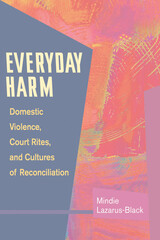 Everyday Harm: Domestic Violence, Court Rites, and Cultures of Reconciliation
Mindie Lazarus-Black
University of Illinois Press, 2007 Exposing the powerful contradictions between empowering rights and legal rites By investigating the harms routinely experienced by the victims and survivors of domestic violence, both inside and outside of law, Everyday Harm studies the limits of what domestic violence law can--and cannot--accomplish. Combining detailed ethnographic research and theoretical analysis, Mindie Lazarus-Black illustrates the ways persistent cultural norms and ingrained bureaucratic procedures work to unravel laws designed to protect the safety of society’s most vulnerable people. Lazarus-Black’s fieldwork in Trinidad traces a story with global implications about why and when people gain the right to ask the court for protection from violence, and what happens when they pursue those rights in court. Why is itthat, in spite of laws designed to empower subordinated people, so little results from that legislation? What happens in and around courts that makes it so difficult for people to obtain their legally available rights and protections? In the case of domestic violence law, what can such legislation mean for women’s empowerment, gender equity, and protection? How do cultural norms and practices intercept the law?
 Everyday Intimacies of the Middle East
Asli Zengin and Sertaç Sehlikoglu, special issue editors
Duke University Press, 2016 A special issue of the Journal of Middle East Women’s Studies This issue provides an area-studies perspective on intimacy and explores the analytic, theoretical, and political work that intimacy promises as a concept. The contributors explore how multiple domains and forms of intimacies are defined and transformed across the cultural and social worlds of the Middle East, looking in particular at Egypt, Turkey, and Israel. Focusing on everyday constructions of intimacies, the contributors engage with questions about how we should calibrate the evolving nature of intimacy in times of rapid transition, what intimacy means for individual and social lives, and what social, political, and economic possibilities it creates. Topics include physical exercise, Turkish beauty salons, transnational surrogacy arrangements, gender reassignment, and coffee shops as intimate spaces for men outside the family. Article Contributors: Aymon Kreil, Claudia Liebelt, Sibylle Lustenberger, Sertaç Sehlikoğlu, Aslı Zengin Review and Third Space Contributors: Dena Al-Adeeb, Adam George Dunn, Rima Dunn, Meral Düzgün, Iklim Goksel, Didem Havlioğlu, Sarah Ihmoud, Sarah Irving, Adi Kuntsman, Shahrzad Mojab, Afsaneh Najmabadi, Rachel Rothendler, Afiya Zia
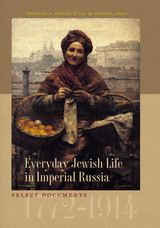 Everyday Jewish Life in Imperial Russia: Select Documents, 1772–1914
Edited by ChaeRan Y. Freeze and Jay M. Harris
Brandeis University Press, 2013 This book makes accessible—for the first time in English—declassified archival documents from the former Soviet Union, rabbinic sources, and previously untranslated memoirs, illuminating everyday Jewish life as the site of interaction and negotiation among and between neighbors, society, and the Russian state, from the beginning of the nineteenth century to World War I. Focusing on religion, family, health, sexuality, work, and politics, these documents provide an intimate portrait of the rich diversity of Jewish life. By personalizing collective experience through individual life stories—reflecting not only the typical but also the extraordinary—the sources reveal the tensions and ruptures in a vanished society. An introductory survey of Russian Jewish history from the Polish partitions (1772–1795) to World War I combines with prefatory remarks, textual annotations, and a bibliography of suggested readings to provide a new perspective on the history of the Jews of Russia.
 Everyday Jihad: The Rise of Militant Islam among Palestinians in Lebanon
Bernard Rougier
Harvard University Press, 2007 As southern Lebanon becomes the latest battleground for Islamist warriors, Everyday Jihad plunges us into the sprawling, heavily populated Palestinian refugee camp at Ain al-Helweh, which in the early 1990s became a site for militant Sunni Islamists. A place of refuge for Arabs hunted down in their countries of origin and a recruitment ground for young disenfranchised Palestinians, the camp--where sheikhs began actively recruiting for jihad--situated itself in the global geography of radical Islam.
With pioneering fieldwork, Bernard Rougier documents how Sunni fundamentalists, combining a literal interpretation of sacred texts with a militant interpretation of jihad, took root in this Palestinian milieu. By staying very close to the religious actors, their discourse, perceptions, and means of persuasion, Rougier helps us to understand how radical religious allegiances overcome traditional nationalist sentiment and how jihadist networks grab hold in communities marked by unemployment, poverty, and despair.
With the emergence of Hezbollah, the Shiite political party and guerrilla army, at the forefront of Lebanese and regional politics, relations with the Palestinians will be decisive. The Palestinian camps of Lebanon, whose disarmament is called for by the international community, constitute a contentious arena for a multitude of players: Syria and Iran, Hezbollah and the Palestinian Authority, and Bin Laden and the late Zarqawi. Witnessing everyday jihad in their midst offers readers a rare glimpse into a microcosm of the religious, sectarian, and secular struggles for the political identity of the Middle East today.
 Everyday Justice: A Legal Aid Story
Ashley Wiltshire
Vanderbilt University Press, 2022 The Legal Aid Society’s mission is to advance, defend, and enforce the legal rights of low-income and otherwise vulnerable people in order to secure for them the basic necessities of life. Everyday Justice is an on-the-ground history of the Legal Aid Society of Middle Tennessee and the Cumberlands, the story of how national debates about access to justice have impacted the work of its lawyers, and a warning about why the federally imposed limits on that work must be lifted in order to fulfill the pledge of justice for all.
Those surviving on low incomes often see the legal system as an oppressive force stacked against them. Everyday Justice is about lawyers trying to make the law work for these people. This book traces the development and evolution of legal aid in Middle Tennessee from the late 1960s to the turn of the millennium, as told by Ashley Wiltshire, who worked for the Legal Aid Society of Middle Tennessee and the Cumberlands in all its incarnations for four decades, beginning a year after its inception.
Set in the context of the legal aid movement in the United States—beginning as a part of the social awakening in the post–Civil War era, continuing with volunteer efforts in the first part of the twentieth century, and coming to fruition beginning with the OEO Office of Legal Services grants of the 1960s as part of the War on Poverty—Everyday Justice is a story of Nashville, which levied an extended period of opposition because of prevailing cultural and religious views on race and poverty.
 Everyday Justice: A Legal Aid Story
Ashley Wiltshire
Vanderbilt University Press, 2022 The Legal Aid Society’s mission is to advance, defend, and enforce the legal rights of low-income and otherwise vulnerable people in order to secure for them the basic necessities of life. Everyday Justice is an on-the-ground history of the Legal Aid Society of Middle Tennessee and the Cumberlands, the story of how national debates about access to justice have impacted the work of its lawyers, and a warning about why the federally imposed limits on that work must be lifted in order to fulfill the pledge of justice for all.
Those surviving on low incomes often see the legal system as an oppressive force stacked against them. Everyday Justice is about lawyers trying to make the law work for these people. This book traces the development and evolution of legal aid in Middle Tennessee from the late 1960s to the turn of the millennium, as told by Ashley Wiltshire, who worked for the Legal Aid Society of Middle Tennessee and the Cumberlands in all its incarnations for four decades, beginning a year after its inception.
Set in the context of the legal aid movement in the United States—beginning as a part of the social awakening in the post–Civil War era, continuing with volunteer efforts in the first part of the twentieth century, and coming to fruition beginning with the OEO Office of Legal Services grants of the 1960s as part of the War on Poverty—Everyday Justice is a story of Nashville, which levied an extended period of opposition because of prevailing cultural and religious views on race and poverty.
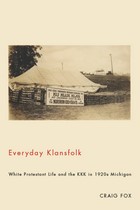 Everyday Klansfolk: White Protestant Life and the KKK in 1920s Michigan
Craig Fox
Michigan State University Press, 2011 In 1920s Middle America, the Ku Klux Klan gained popularity not by appealing to the fanatical fringes of society, but by attracting the interest of “average” citizens. During this period, the Klan recruited members through the same unexceptional channels as any other organization or club, becoming for many a respectable public presence, a vehicle for civic activism, or the source of varied social interaction. Its diverse membership included men and women of all ages, occupations, and socio-economic standings. Although surviving membership records of this clandestine organization have proved incredibly rare, Everyday Klansfolk uses newly available documents to reconstruct the life and social context of a single grassroots unit in Newaygo County, Michigan. A fascinating glimpse behind the mask of America’s most notorious secret order, this absorbing study sheds light on KKK activity and membership in Newaygo County, and in Michigan at large, during the brief and remarkable peak years of its mass popular appeal.
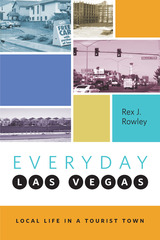 Everyday Las Vegas: Local Life in a Tourist Town
Rex J. Rowley
University of Nevada Press, 2014 Every year, more than thirty-five million people from all over the world visit Las Vegas; only two million call the city home. Everyday Las Vegas takes a close look at the lives of those who live in a place the rest of the world considers exotic, even decadent. Using broad research, including interviews with more than one hundred Las Vegans, Rex Rowley--who grew up in Las Vegas--examines everyday life in a place that markets itself as an escape from mundane reality.
Rowley considers such topics as why people move to Las Vegas, the nature of their work and personal lives, the impact of growth and rapid change, and interaction with the overwhelmingly touristic side of the city. He also considers the benefits and perils of living in a nonstop twenty-four-hour city rich in entertainment options and easy access to gambling, drugs, and other addictions. His examination includes the previously unstudied role of neighborhood casinos patronized by locals rather than tourists and the impact that a very mobile population has on schools, churches, and community life.
Rowley considers the very different ways people perceive a place as insiders or outsiders, a dichotomy that arises when tourism is a mainstay of the local economy. His work offers insights into what Las Vegas can teach us about other cities and American culture in general. It also contributes to our understanding of how people relate to places and how the personality of a place influences the lives of people who live there.
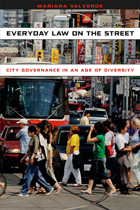 Everyday Law on the Street: City Governance in an Age of Diversity
Mariana Valverde
University of Chicago Press, 2012 Toronto prides itself on being “the world’s most diverse city,” and its officials seek to support this diversity through programs and policies designed to promote social inclusion. Yet this progressive vision of law often falls short in practice, limited by problems inherent in the political culture itself. In Everyday Law on the Street, Mariana Valverde brings to light the often unexpected ways that the development and implementation of policies shape everyday urban life. Drawing on four years spent participating in council hearings and civic association meetings and shadowing housing inspectors and law enforcement officials as they went about their day-to-day work, Valverde reveals a telling transformation between law on the books and law on the streets. She finds, for example, that some of the democratic governing mechanisms generally applauded—public meetings, for instance—actually create disadvantages for marginalized groups, whose members are less likely to attend or articulate their concerns. As a result, both officials and citizens fail to see problems outside the point of view of their own needs and neighborhood. Taking issue with Jane Jacobs and many others, Valverde ultimately argues that Toronto and other diverse cities must reevaluate their allegiance to strictly local solutions. If urban diversity is to be truly inclusive—of tenants as well as homeowners, and recent immigrants as well as longtime residents—cities must move beyond micro-local planning and embrace a more expansive, citywide approach to planning and regulation.
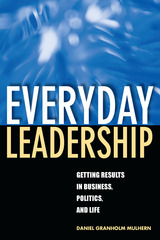 Everyday Leadership: Getting Results in Business, Politics, and Life
Daniel Granholm Mulhern
University of Michigan Press, 2007 “A book that truly speaks to everyone. . . . Always practical, often inspiring, this is more a reference book than a self-improvement text, and a great read for any would-be leader.”
—Roger Penske, owner of Penske Corporation and Penske Racing “Sound, practical advice driven home with real-world examples. . . . This is a must-read book for anyone who wants to make a positive difference in the lives of others in their community, their business, or their family.”
—Dennis W. Archer, former mayor of Detroit “Everyday Leadership is a treasure chest of engaging stories, practical tips, and rich insights into how we each can make a difference in the world when we take responsibility for the personal power that we have. . . . once you’ve taken Everyday Leadership to heart you’ll leave this world a little bit better than you found it.”
—Jim Kouzes, coauthor of The Leadership Challenge “Everyday Leadership taught me as much about how to be a better person as it did about being a better leader. In fact, it revealed how much the two are the same. Excellent and helpful reading for anyone.”
—Marianne Williamson, author of Return to Love and Everyday Grace Everyday Leadership offers strategies to improve leadership skills, achieve results, and gain greater satisfaction in these hectic times. It speaks to the everyday leader, whether that person is a principal, pastor, parent, or CEO. Daniel Granholm Mulhern brings the art of management down to earth, presenting stories that illuminate some of the best ideas about real human leadership. He offers practical steps to achieve the goal of leading well in our lives through creating a vision, communicating that vision, and living it in simple yet powerful ways. Daniel Granholm Mulhern is the “First Gentleman” of the State of Michigan and an accomplished consultant, business coach, and motivational speaker. In addition to the personal support and counsel he offers his wife, Governor Jennifer Mulhern Granholm, Dan contributes his professional expertise, spearheading the effort to make Michigan’s state government a model for the nation as a “great place to do great work!” Dan also chairs the Michigan Community Service Commission, which promotes and coordinates volunteer efforts across the state.
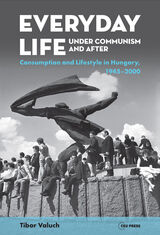 Everyday Life under Communism and After: Lifestyle and Consumption in Hungary, 1945–2000
Tibor Valuch
Central European University Press, 2022 By providing a survey of consumption and lifestyle in Hungary during the second half of the twentieth century, this book shows how common people lived during and after tumultuous regime changes. After an introduction covering the late 1930s, the study centers on the communist era, and goes on to describe changes in the post-communist period with its legacy of state socialism.
Tibor Valuch poses a series of questions. Who could be called rich or poor and how did they live in the various periods? How did living, furnishings, clothing, income, and consumption mirror the structure of the society and its transformations? How could people accommodate their lifestyles to the political and social system? How specific to the regime was consumption after the communist takeover, and how did consumption habits change after the demise of state socialism? The answers, based on micro-histories, statistical data, population censuses and surveys help to understand the complexities of daily life, not only in Hungary, but also in other communist regimes in east-central Europe, with insights on their antecedents and afterlives.
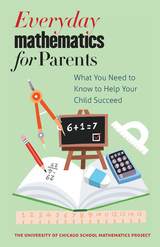 Everyday Mathematics for Parents: What You Need to Know to Help Your Child Succeed
The University of Chicago School Mathematics Project
University of Chicago Press, 2017 The Everyday Mathematics (EM) program was developed by the University of Chicago School Mathematics Project (UCSMP) and is now used in more than 185,000 classrooms by almost three million students. Its research-based learning delivers the kinds of results that all school districts aspire to. Yet despite that tremendous success, EMoften leaves parents perplexed. Learning is accomplished not through rote memorization, but by actually engaging in real-life math tasks. The curriculum isn’t linear, but rather spirals back and forth, weaving concepts in and out of lessons that build overall understanding and long-term retention. It’s no wonder that many parents have difficulty navigating this innovative mathematical and pedagogic terrain. Now help is here. Inspired by UCSMP’s firsthand experiences with parents and teachers, Everyday Mathematics for Parents will equip parents with an understanding of EM and enable them to help their children with homework—the heart of the great parental adventure of ensuring that children become mathematically proficient. Featuring accessible explanations of the research-based philosophy and design of the program, and insights into the strengths of EM, this little book provides the big-picture information that parents need. Clear descriptions of how and why this approach is different are paired with illustrative tables that underscore the unique attributes of EM. Detailed guidance for assisting students with homework includes explanations of the key EM concepts that underlie each assignment. Resources for helping students practice math more at home also provide an understanding of the long-term utility of EM. Easy to use, yet jam-packed with knowledge and helpful tips, Everyday Mathematics for Parents will become a pocket mentor to parents and teachers new to EM who are ready to step up and help children succeed. With this book in hand, you’ll finally understand that while this may not be the way that you learned math, it’s actually much better.
 Everyday Modernism: Architecture and Society in Singapore
Jiat-Hwee Chang and Justin Zhuang
National University of Singapore Press, 2022 A richly illustrated account of the development of Singapore’s modern built environment.
Everyday Modernism is the first comprehensive documentation of Singapore’s modern built environment. Through a lens of social, cultural, and architectural histories, the book uncovers the many untold stories of the Southeast Asian city-state’s modernization, from the rise of heroic skyscrapers, such as the Pearl Bank Apartments, to the spread of typical utilitarian buildings like the multistory parking garage. It investigates how modernism, through both form and function, radically transformed Singapore and made its inhabitants into modern citizens. The most intensive period of such change, the author shows, happened in the 1960s and 1970s under the rise of a developmental state that sought to safeguard its new-found independence. The book also looks both earlier and later, however, ranging from the 1930s to the 1980s to cover a wider range of histories, building types, and architectural styles, expanding from the International Style and Brutalism into Art Deco and even a touch of Postmodernism. The book’s essays are richly illustrated with hundreds of archival images and illustrations, as well as contemporary photos by architectural photographer Darren Soh. By examining the evolution of the once exceptional into the typical and by learning how abstract spaces become lived places, the book traces how modernism has become part of everyday life in Singapore.
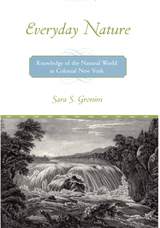 Everyday Nature: Knowledge of the Natural World in Colonial New York
Gronim, Sara S
Rutgers University Press, 2007 In the modern world, the public looks to scientists and scholars for their expertise on issues ranging from the effectiveness of vaccines to the causes of natural disasters. But for early Americans, whose relationship to nature was more intimate and perilous than our own, personal experience, political allegiances, and faith in God took precedence over the experiments of the learned. In Everyday Nature, Sara Gronim shows how scientific advances were received in the early modern world, from the time Europeans settled in America until just before the American Revolution. Settlers approached a wide range of innovations, such as smallpox inoculation, maps and surveys, Copernican cosmology, and Ben Franklin’s experiments with electricity, with great skepticism. New Yorkers in particular were distrustful because of the chronic political and religious factionalism in the colony. Those discoveries that could be easily reconciled with existing beliefs about healing the sick, agricultural practices, and the revolution of the planets were more readily embraced.
A fascinating portrait of colonial life, this book traces a series of innovations that were disseminated throughout the Atlantic world during the Enlightenment, and shows how colonial New Yorkers integrated new knowledge into their lives.
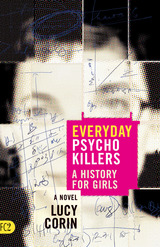 Everyday Psychokillers: A History for Girls, A Novel
Lucy Corin
University of Alabama Press, 2004 Interweaving history, myth, rumor, and news, this first novel explores what it means to grow up as a girl in a culture of girl-killers
In Everyday Psychokillers spectacular violence is the idiom of everyday life, a lurid extravaganza in which all those around the narrator seem vicarious participants. And at its center are the interchangeable young girls, thrilling to know themselves the object of so much desire and terror.
The narrative interweaves history, myth, rumor, and news with the experiences of a young girl living in the flatness of South Florida. Like Grace Paley's narrators, she is pensive and eager, hungry for experience but restrained. Into the sphere of her regard come a Ted Bundy reject, the God Osiris, a Caribbean slave turned pirate, a circus performer living in a box, broken horses, a Seminole chief in a swamp, and a murderous babysitter. What these preposterously commonplace figures all know is that murder is identity: "Of course what matters really is the psychokiller, what he's done, what he threatens to do. Of course to be the lucky one you have to be abducted in the first place. Without him, you wouldn't exist."
Everyday Psychokillers reaches to the edge of the psychoanalytical and jolts the reader back to daily life. The reader becomes the killer, the watcher, the person on the verge, hiding behind an everyday face.
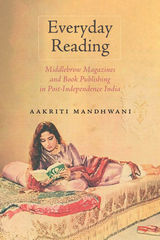 Everyday Reading: Middlebrow Magazines and Book Publishing in Post-Independence India
Aakriti Mandhwani
University of Massachusetts Press, 2024 Finalist for the 2025 SHARP Book History Book Prize
During the two difficult decades immediately following the 1947 Indian Independence, a new, commercially successful print culture emerged that articulated alternatives to dominant national narratives. Through what Aakriti Mandhwani defines as middlebrow magazines—like Delhi Press’s Saritā—and the first paperbacks in Hindi—Hind Pocket Books—North Indian middle classes cultivated new reading practices that allowed them to reimagine what it meant to be a citizen. Rather than focusing on individual sacrifices and contributions to national growth, this new print culture promoted personal pleasure and other narratives that enabled readers to carve roles outside of official prescriptions of nationalism, austerity, and religion.
Utilizing a wealth of previously unexamined print culture materials, as well as paying careful attention to the production of commercial publishing companies and the reception of ordinary reading practices—particularly those of women—Everyday Reading offers fresh perspectives into book history, South Asian literary studies, and South Asian gender studies.
 Everyday Reading: Print Culture and Collective Identity in the Rio de la Plata, 1780-1910
William Garrett Acree
Vanderbilt University Press, 2011 Winner of the LASA Southern Cone Studies Section Book Prize in the Humanities, 2013
Starting in the late nineteenth century, the region of South America known as the Rio de la Plata (containing modern-day Uruguay and Argentina) boasted the highest literacy rates in Latin America. In Everyday Reading, William Acree explores the history, events, and culture that gave rise to the region's remarkable progress. With a specific focus on its print culture, in the form of newspapers, political advertisements and documents, schoolbooks, and even stamps and currency, Acree creates a portrait of a literary culture that permeated every aspect of life.
Everyday Reading argues that the introduction of the printing press into the Rio de la Plata in the 1780s hastened the collapse of Spanish imperial control and played a major role in the transition to independence some thirty years later. After independence, print culture nurtured a new identity and helped sustain the region through the tumult of civil war in the mid-1800s. Acree concludes by examining the role of reading in formal education, which had grown exponentially by the early twentieth century as schoolchildren were taught to fulfill traditional roles in society.
Ultimately, Everyday Reading humanizes literary culture, demonstrating its unrecognized and unexpected influence in everyday lives.
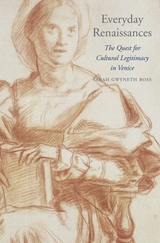 Everyday Renaissances: The Quest for Cultural Legitimacy in Venice
Sarah Gwyneth Ross
Harvard University Press, 2016 The world of wealth and patronage that we associate with sixteenth- and early seventeenth-century Italy can make the Renaissance seem the exclusive domain of artists and aristocrats. Revealing a Renaissance beyond Michelangelo and the Medici, Sarah Gwyneth Ross recovers the experiences of everyday men and women who were inspired to pursue literature and learning.
Ross draws on a trove of original unpublished sources—wills, diaries, household inventories, account books, and other miscellany—to reconstruct the lives of over one hundred artisans, merchants, and others on the middle rung of Venetian society who embraced the ennobling virtues of a humanistic education. These men and women sought out the latest knowledge, amassed personal libraries, and passed both their books and their hard-earned wisdom on to their families and heirs.
Physicians were often the most avid—and the most anxious—of professionals seeking cultural legitimacy. Ross examines the lives of three doctors: Nicolò Massa (1485–1569), Francesco Longo (1506–1576), and Alberto Rini (d. 1599). Though they had received university training, these self-made men of letters were not patricians but members of a social group that still yearned for credibility. Unlike priests or lawyers, physicians had not yet rid themselves of the taint of artisanal labor, and they were thus indicative of a middle class that sought to earn the respect of their peers and betters, protect and advance their families, and secure honorable remembrance after death.
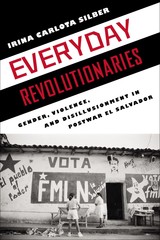 Everyday Revolutionaries: Gender, Violence, and Disillusionment in Postwar El Salvador
Irina Carlota Silber
Rutgers University Press, 2011 Everyday Revolutionaries provides a longitudinal and rigorous analysis of the legacies of war in a community racked by political violence. By exploring political processes in one of El Salvador's former war zones-a region known for its peasant revolutionary participation-Irina Carlota Silber offers a searing portrait of the entangled aftermaths of confrontation and displacement, aftermaths that have produced continued deception and marginalization.
Silber provides one of the first rubrics for understanding and contextualizing postwar disillusionment, drawing on her ethnographic fieldwork and research on immigration to the United States by former insurgents. With an eye for gendered experiences, she unmasks how community members are asked, contradictorily and in different contexts, to relinquish their identities as "revolutionaries" and to develop a new sense of themselves as productive yet marginal postwar citizens via the same "participation" that fueled their revolutionary action. Beautifully written and offering rich stories of hope and despair, Everyday Revolutionaries contributes to important debates in public anthropology and the ethics of engaged research practices.
Everyday Ruptures: Children, Youth, and Migration in Global Perspective
Cati Coe
Vanderbilt University Press, 2011 When people--whether children, youth, or adults--migrate, that migration is often perceived as a rupture, with people separated by great distances and for extended periods of time. But for migrants and those affected by migration, the everyday persists, and migration itself may be critical to the continuation of social life. Everyday Ruptures illuminates the wide-ranging continuities and disruptions in the experiences of children around the world, those who participate in and those who are affected by migration.
The book is organized around four themes:
• how children's agency is affected by institutions, families, and beliefs
• how families and individuals create and maintain kin ties in conditions of rupture
• how emotion and affect are linked to global divisions and flows
• how the actions of states create ruptures and continuities
Everyday Sermons from Worcester Cathedral Priory: An Early-Fourteenth-Century Collection in Latin
Joan Greatrex
Arc Humanities Press, 2019 Edited and with commentary by Joan Greatrex, this book makes available for the first time in printed form the sermon manuscript, MS Q. 18, which survives in its original home in the medieval cathedral library at Worcester. At first glance this small, untidy quarto-size manuscript appears to be merely an unremarkable collection of early fourteenth-century Latin sermons. However, their importance lies in the fact that they appear to be a rare, if not unique, example of working copies of sermons, providing us with a glimpse into daily life in a medieval monastic community.
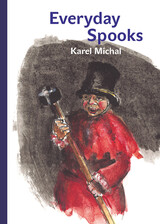 Everyday Spooks
Karel Michal
Karolinum Press, 2008 Prague-born Karel Michal (1932–84) lived a significant part of his adult life under Czechoslovakia’s oppressive communist regime. Prevented from studying at the university as a young man, he fruitlessly cycled through a number of professions before finally turning to writing in the early 1960s. Michal’s works—which include detective fiction, historical novels, short stories, and screenplays—offer a Kafkaesque perspective on the mechanism of the absurd and argue for substantial reinterpretation of the concept of ordinary life under a totalitarian regime.
With Everyday Spooks, Michal presents an unforgettable assortment of fantastic creatures that inhabit his strange vision of everyday reality in ’50s and ’60s communist Czechoslovakia. Translated from the Czech by David Short and complemented with suitably eerie illustrations by Dagmar Hamsíková, this collection of seven short stories describes bizarre encounters where the past melts into the present, ordinary people meet comic and anxious figures and interact with ghosts, and mundane speech drifts repeatedly into absurdity.
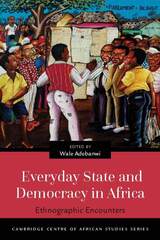 Everyday State and Democracy in Africa: Ethnographic Encounters
Wale Adebanwi
Ohio University Press, 2022 Bottom-up case studies, drawn from the perspective of ordinary Africans’ experiences with state bureaucracies, structures, and services, reveal how citizens and states define each other. This volume examines contemporary citizens’ everyday encounters with the state and democratic processes in Africa. The contributions reveal the intricate and complex ways in which quotidian activities and experiences—from getting an identification card (genuine or fake) to sourcing black-market commodities to dealing with unreliable waste collection—both (re)produce and (re)constitute the state and democracy. This approach from below lends gravity to the mundane and recognizes the value of conceiving state governance not in terms of its stated promises and aspirations but rather in accordance with how people experience it. Both new and established scholars based in Africa, Europe, and North America cover a wide range of examples from across the continent, including - bureaucratic machinery in South Sudan, Nigeria, and Kenya
- infrastructure and shortages in Chad and Nigeria
- disciplinarity, subjectivity, and violence in Rwanda, South Africa, and Nigeria
- the social life of democracy in the Congo, Cameroon, and Mozambique
- education, welfare, and health in Ethiopia, the Democratic Republic of Congo, and Burkina Faso
Everyday State and Democracy in Africa demonstrates that ordinary citizens’ encounters with state agencies and institutions define the meanings, discourses, practices, and significance of democratic life, as well its distressing realities. Contributors: - Daniel Agbiboa
- Victoria Bernal
- Jean Comaroff
- John L. Comaroff
- E. Fouksman
- Fred Ikanda
- Lori Leonard
- Rose Løvgren
- Ferenc Dávid Markó
- Ebenezer Obadare
- Rogers Orock
- Justin Pearce
- Katrien Pype
- Edoardo Quaretta
- Jennifer Riggan
- Helle Samuelsen
- Nicholas Rush Smith
- Eric Trovalla
- Ulrika Trovalla
 Everyday Streets: Inclusive Approaches to Understanding and Designing Streets
Edited by Agustina Martire, Birgit Hausleitner, and Jane Clossick
University College London, 2023 A comparative look at everyday streets in contemporary cities and how they could be more inclusively used.
Everyday streets are both the most used and most undervalued of cities’ public spaces. They are places of social aggregation, bringing together people of different classes, genders, ages, ethnicities, and nationalities. They comprise not just the familiar outdoor spaces that we move through and interact in but also urban blocks, interiors, depths, and hinterlands, which are integral to streets’ nature and contribute to their vitality. Everyday Streets offers an inclusive approach to understanding and designing these streets through an analysis of them as found in cities around the globe. From the regular rectilinear urban blocks of Montreal to the carefully regulated narrow alleyways of Naples, and from the resilient market streets of London to the crammed commercial streets of Chennai, the streets in this book were all conceived with a certain level of control. Everyday Streets is a palimpsest of methods, perspectives, and recommendations that together provide a solid understanding of everyday streets, their degree of inclusiveness, and to what extent they could be more inclusive.
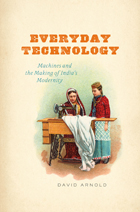 Everyday Technology: Machines and the Making of India's Modernity
David Arnold
University of Chicago Press, 2013 In 1909 Mohandas Karamchand Gandhi, on his way back to South Africa from London, wrote his now celebrated tract Hind Swaraj, laying out his vision for the future of India and famously rejecting the technological innovations of Western civilization. Despite his protestations, Western technology endured and helped to make India one of the leading economies in our globalized world. Few would question the dominant role that technology plays in modern life, but to fully understand how India first advanced into technological modernity, argues David Arnold, we must consider the technology of the everyday. Everyday Technology is a pioneering account of how small machines and consumer goods that originated in Europe and North America became objects of everyday use in India in the late nineteenth and early twentieth centuries. Rather than investigate “big” technologies such as railways and irrigation projects, Arnold examines the assimilation and appropriation of bicycles, rice mills, sewing machines, and typewriters in India, and follows their impact on the ways in which people worked and traveled, the clothes they wore, and the kind of food they ate. But the effects of these machines were not limited to the daily rituals of Indian society, and Arnold demonstrates how such small-scale technologies became integral to new ways of thinking about class, race, and gender, as well as about the politics of colonial rule and Indian nationhood. Arnold’s fascinating book offers new perspectives on the globalization of modern technologies and shows us that to truly understand what modernity became, we need to look at the everyday experiences of people in all walks of life, taking stock of how they repurposed small technologies to reinvent their world and themselves.
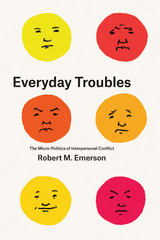 Everyday Troubles: The Micro-Politics of Interpersonal Conflict
Robert M. Emerson
University of Chicago Press, 2015 From roommate disputes to family arguments, trouble is inevitable in interpersonal relationships. In Everyday Troubles, Robert M. Emerson explores the beginnings and development of the conflicts that occur in our relationships with the people we regularly encounter—family members, intimate partners, coworkers, and others—and the common responses to such troubles.
To examine these issues, Emerson draws on interviews with college roommates, diaries documenting a wide range of irritation with others, conversations with people caring for family members suffering from Alzheimer’s, studies of family interactions, neighborly disputes, and other personal accounts. He considers how people respond to everyday troubles: in non-confrontational fashion, by making low-visibility, often secretive, changes in the relationship; more openly by directly complaining to the other person; or by involving a third party, such as friends or family. He then examines how some relational troubles escalate toward extreme and even violent responses, in some cases leading to the involvement of outside authorities like the police or mental health specialists.
By calling attention to the range of possible reactions to conflicts in interpersonal relationships, Emerson also reminds us that extreme, even criminal actions often result when people fail to find ways to deal with trouble in moderate, non-confrontational ways. Innovative and insightful, Everyday Troubles is an illuminating look at how we deal with discord in our relationships.
Everyday Use: Alice Walker
Christian, Barbara T
Rutgers University Press, 1994 Alice Walker's early story, "Everyday Use," has remained a cornerstone of her work. Her use of quilting as a metaphor for the creative legacy that African Americans inherited from their maternal ancestors changed the way we define art, women's culture, and African American lives. By putting African American women's voices at the center of the narrative for the first time, "Everyday Use" anticipated the focus of an entire generation of black women writers.
This casebook includes an introduction by the editor, a chronology of Walker's life, an authoritative text of "Everyday Use" and of "In Search of Our Mothers' Gardens," an interview with Walker, six critical essays, and a bibliography. The contributors are Charlotte Pierce-Baker, Houston A. Baker, Jr., Thadious M. Davis, Margot Anne Kelley, John O'Brien, Elaine Showalter, and Mary Helen Washington.
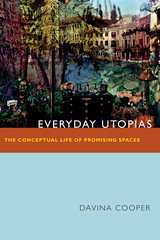 Everyday Utopias: The Conceptual Life of Promising Spaces
Davina Cooper
Duke University Press, 2013 Everyday utopias enact conventional activities in unusual ways. Instead of dreaming about a better world, participants seek to create it. As such, their activities provide vibrant and stimulating contexts for considering the terms of social life, of how we live together and are governed. Weaving conceptual theorizing together with social analysis, Davina Cooper examines utopian projects as seemingly diverse as a feminist bathhouse, state equality initiatives, community trading networks, and a democratic school where students and staff collaborate in governing. She draws from firsthand observations and interviews with participants to argue that utopian projects have the potential to revitalize progressive politics through the ways their innovative practices incite us to rethink mainstream concepts including property, markets, care, touch, and equality. This is no straightforward story of success, however, but instead a tale of the challenges concepts face as they move between being imagined, actualized, hoped for, and struggled over. As dreaming drives new practices and practices drive new dreams, everyday utopias reveal how hard work, feeling, ethical dilemmas, and sometimes, failure, bring concepts to life.
 Everyday Violence: The Public Harassment of Women and LGBTQ People
Simone Kolysh
Rutgers University Press, 2021 Everyday Violence is based on ten years of scholarly rage against catcalling and aggression directed at women and Lesbian, Gay, Bisexual, Transgender and Queer (LGBTQ) people of New York City. Simone Kolysh recasts public harassment as everyday violence and demands an immediate end to this pervasive social problem. Analyzing interviews with initiators and recipients of everyday violence through an intersectional lens, Kolysh argues that gender and sexuality, shaped by race, class, and space, are violent processes that are reproduced through these interactions in the public sphere. They examine short and long-term impacts and make inroads in urban sociology, queer and trans geographies, and feminist thought. Kolysh also draws a connection between public harassment, gentrification, and police brutality resisting criminalizing narratives in favor of restorative justice. Through this work, they hope for a future where women and LGBTQ people can live on their own terms, free from violence.
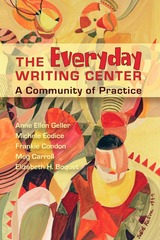 Everyday Writing Center: A Community of Practice
Anne E. Geller, Michele Eodice, Frankie Condon, Meg Carroll, Elizabeth H. Boquet
Utah State University Press, 2007 The Everyday Writing Center challenges some of the most comfortable traditions in its field, and it does so with a commitment and persuasiveness that one seldom sees in scholarly discussion. The book, at its core, is an argument for a new writing center consciousness--one that makes the most of the writing center's unique, and uniquely fluid, identity. Writing center specialists live with a liminality that has been acknowledged but not fully explored in the literature. Their disciplinary identity is with the English department, but their mission is cross-disciplinary; their research is pedagogical, but they often report to central administration. Their education is in humanities, but their administrative role demands constant number-crunching. This fluid identity explains why Trickster--an icon of spontaneity, shape-shifting, and the creative potential of chaos--has come to be a favorite cultural figure for the authors of this book. Adapting Lewis Hyde and others, these authors use Trickster to develop a theme of ordinary disruptions ("the everyday") as a source of provocative learning moments that can liberate both student writers and writing center staff. At the same time, the authors parlay Etienne Wenger's concept of "community of practice" into an ethos for a dynamic, learner-centered pedagogy that is especially well-suited to the peculiar teaching situation of the writing center. Through Trickster, they question not only accepted approaches to writing center pedagogy, but conventional approaches to race, time, leadership, and collaboration as well. They encourage their field to exploit the creative potential in ordinary events that are normally seen as disruptive or defeating, and they challenge traditions in the field that tend to isolate a writing center director from the department and campus. Yet all is not random, for the authors anchor this high-risk/high-yield approach in their commitment to a version of Wenger's community of practice. Conceiving of themselves, their colleagues, student writers, and student tutors as co-learners engaged together in a dynamic life of learning, the authors find a way to ground the excess and randomness of the everyday, while advancing an ethic of mutual respect and self-challenge. Committed to testing a region beyond the edge of convention, the authors of The Everyday Writing Center constantly push themselves and their field toward deeper, more significant research, and more reflective, dynamic teaching.
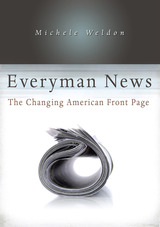 Everyman News: The Changing American Front Page
Michele Weldon
University of Missouri Press, 2007
One need only look at the front pages of newspapers over the past few years to see that something has changed. Stories are more personal, more inclusive, less distant from readers’ experiences. Once called the first draft of history, news has become more of an anecdotal companion. The evidence is telling: stories use more unofficial sources than ever before; the “inverted pyramid” form of news writing is barely practiced; and, especially after 9/11, tragedy has become more humanized.
Scanning the crowded media landscape, Michele Weldon—a journalist passionate about her profession—takes a fresh look at how newspapers have carved out a narrative niche that reflects society’s fascination with personal stories and readers’ demands for diversity in content. Comparing some 850 stories, story approaches, and unofficial sourcing in twenty American newspapers for eight dates in 2001 and 2004—a total of 160 front pages—she shows a shift toward features over hard news, along with an increase in anecdotal or humanistic approaches to all stories.
Everyman News offers a provocative look at why American newspapers have become story papers, with their content and style saying as much about our culture as they do about the journalists and the readers. Weldon shows that a variety of forces both inside and outside journalism—blogs, citizen journalism, newsroom diversity, and other factors—have converged to remake the front page, and she unveils the content of “everyman news” as a commodity apart from the mode of delivery. Her assessment also incorporates more than fifty interviews with people connected to journalism about what these changes mean—revealing that not everyone in the industry believes they are for the better.
Is everyman news perhaps right for its time, or is it merely a symptom of what Weldon calls “Chicken Little journalism”? Weighing in on such matters as the New York Times’s “Portraits of Grief” series and the dangers of the blogosphere, she invites readers to make their own calls in this original and important contribution to the study of media. Everyman News is a book that will contribute to our understanding of newspapers in the new century—must reading for professionals and an eye-opener for anyone trying to comprehend the significant shifts in today’s front pages.
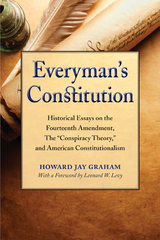 Everyman's Constitution: Historical Essays on the Fourteenth Amendment, the "Conspiracy Theory," and American Constitutionalism
Howard Jay Graham
Wisconsin Historical Society Press, 1968 In 1938, Howard Jay Graham, a deaf law librarian, successfully argued that the authors of the Fourteenth Amendment--ratified after the American Civil War to establish equal protection under the law for all American citizens regardless of race--were motivated by abolitionist fervor, debunking the notion of a corporate conspiracy at the heart of the amendment's wording. For over half a century, the amendment had been used to endow corporations with rights as individuals and thus protect them from state legislation. By 1968, when Everyman's Constitution was first published, the Fourteenth Amendment had become a tool for the incorporation of the Bill of Rights to apply to all American citizens. The essays in this reprinted edition are still relevant as the nation continues to interpret our framing legislation in light of the concerns of today and to balance citizens' rights against those of corporations. Howard Jay Graham was a law librarian brought in by the NAACP's legal team to write a brief on the Fourteenth Amendment for the Supreme Court case Brown v. Board of Education. Though the Supreme Court justices ruled in favor of the NAACP based on the sociological rather than historical evidence it provided, Graham's work, published in various law journals over several decades, contributed greatly to the ongoing interpretation of the Fourteenth Amendment.
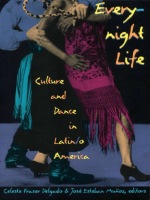 Everynight Life: Culture and Dance in Latin/o America
Celeste Fraser Delgado and José Esteban Muñoz, eds.
Duke University Press, 1997 The function of dance in Latin/o American culture is the focus of the essays collected in Everynight Life. The contributors interpret how Latin/o culture expresses itself through dance, approaching the material from the varying perspectives of literary, cultural, dance, performance, queer, and feminist studies. Viewing dance as privileged sites of identity formation and cultural resistance in Latin/o America, Everynight Life translates the motion of bodies into speech, and the gestures of dance into a provocative socio-political grammar. This anthology looks at many modes of dance—including salsa, merengue, cumbia, rumba, mambo, tango, samba, and norteño—as models for the interplay of cultural memory and regional conflict. Barbara Browning’s essay on capoeira, for instance, demonstrates how dance has been used as a literal form of resistance, while José Piedra explores the meanings conveyed by women of color dancing the rumba. Pieces such as Gustavo Perez Fírmat’s "I Came, I Saw, I Conga’d" and Jorge Salessi’s "Medics, Crooks, and Tango Queens" illustrate the lively scope of this volume’s subject matter. Contributors. Barbara Browning, Celeste Fraser Delgado, Jane C. Desmond, Mayra Santos Febres, Juan Carlos Quintero Herencia, Josh Kun, Ana M. López, José Esteban Muñoz, José Piedra, Gustavo Perez Fírmat, Augusto C. Puleo, David Román, Jorge Salessi, Alberto Sandoval
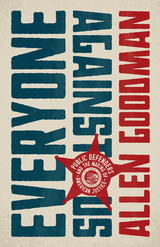 Everyone against Us: Public Defenders and the Making of American Justice
Allen Goodman
University of Chicago Press, 2023 A former public defender testifies to the vivid human suffering at the heart of America’s criminal justice system.
As a public defender, Allen Goodman faced cross-examination from family and friends every day: How could he work to help criminals? How could he live with himself? Presumed guilty by association, Goodman quickly learned that people didn’t really want an answer; they wanted a justification, perhaps even an apology. Ever the idealist, Goodman answered anyway: Everyone deserves justice.
Everyone against Us is Goodman’s testimony of his life as a public defender. In it, he documents his efforts to defend clients, both guilty and innocent, against routine police abuse, prosecutorial misconduct, and unjust sentencing. To work in criminal justice, Goodman shows, is to confront and combat vivid human suffering, of both victims and perpetrators. From sex trafficking, murder, and abuse to false conviction, torture, and systemic racism, Goodman describes the daily experiences that both rattled his worldview and motivated him to work ever harder. Part memoir, part exposé, Everyone against Us is the moving story of an embattled civil servant who staves off the worst abuses of the criminal justice system, at great personal cost.
Everyone Here Spoke Sign Language: Hereditary Deafness on Martha’s Vineyard
Nora Ellen Groce
Harvard University Press, 1985 From the seventeenth century to the early years of the twentieth, the population of Martha’s Vineyard manifested an extremely high rate of profound hereditary deafness. In stark contrast to the experience of most Deaf people in our own society, the Vineyarders who were born Deaf were so thoroughly integrated into the daily life of the community that they were not seen—and did not see themselves—as handicapped or as a group apart. Deaf people were included in all aspects of life, such as town politics, jobs, church affairs, and social life. How was this possible?
On the Vineyard, hearing and Deaf islanders alike grew up speaking sign language. This unique sociolinguistic adaptation meant that the usual barriers to communication between the hearing and the Deaf, which so isolate many Deaf people today, did not exist.
Everyone I Love, Alive
Jason Bayani
Omnidawn, 2025 Bayani’s third poetry collection considers how we might cultivate life in times of oppression and upheaval.
With this collection of poems, Jason Bayani leans into traditions of lyric, song, and prayer to cultivate life while existing within a time of empire and societal collapse. Everyone I Love, Alive wrestles with form to summon both the living and the dead. Bayani’s rich language calls us to experience a connection to cultural heritage and, even during times of oppression, to find the compassion and awareness needed to drive change. These poems show how not only our love and desires—but also our rage and resistance—can be the very things that keep us alive.
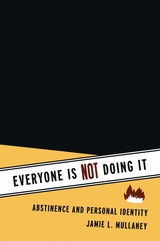 Everyone Is NOT Doing It: Abstinence and Personal Identity
Jamie L. Mullaney
University of Chicago Press, 2005 Labels like vegan, virgin, or nonsmoker get thrown around to identify forms of abstinence, but for many abstainers such labels are also proud declarations of who they are. Setting aside the moral debates and psychological assessments surrounding abstinence, Jamie L. Mullaney here asks why it is that the act of not doing something plays such a crucial role in the formation of our personal identities.
Based on interviews with individuals who abstain from habits as diverse as sex, cigarettes, sugar, and technology, Everyone Is NOT Doing It identifies four different types of abstainers: quitters; those who have never done something and never will; those who haven't done something yet, but might in the future; and those who are not doing something temporarily. Mullaney assesses the commonalities that bind abstainers, as well as how perceptions of abstinence change according to social context, age, and historical era. In contrast to such earlier forms of abstinence as social protest, entertainment, or an instrument of social stratification, not doing something now gives people a more secure sense of self by offering a more affordable and manageable identity in a world of ever-expanding options.
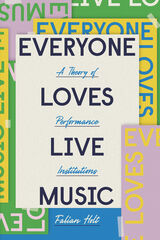 Everyone Loves Live Music: A Theory of Performance Institutions
Fabian Holt
University of Chicago Press, 2020 For decades, millions of music fans have gathered every summer in parks and fields to hear their favorite bands at festivals such as Lollapalooza, Coachella, and Glastonbury. How did these and countless other festivals across the globe evolve into glamorous pop culture events, and how are they changing our relationship to music, leisure, and public culture? In Everyone Loves Live Music, Fabian Holt looks beyond the marketing hype to show how festivals and other institutions of musical performance have evolved in recent decades, as sites that were once meaningful sources of community and culture are increasingly subsumed by corporate giants.
Examining a diverse range of cases across Europe and the United States, Holt upends commonly-held ideas of live music and introduces a pioneering theory of performance institutions. He explores the fascinating history of the club and the festival in San Francisco and New York, as well as a number of European cities. This book also explores the social forces shaping live music as small, independent venues become corporatized and as festivals transform to promote mainstream Anglophone culture and its consumerist trappings. The book further provides insight into the broader relationship between culture and community in the twenty-first century. An engaging read for fans, industry professionals, and scholars alike, Everyone Loves Live Music reveals how our contemporary enthusiasm for live music is more fraught than we would like to think.
Everyone Remain Calm: Stories
Megan Stielstra
Northwestern University Press, 2021 The stories in Everyone Remain Calm reveal landscapes where the surreal and the familiar clash, to visceral effect. A woman yearns for—and dreads—the snowfall that arrives whenever her ex-boyfriend returns to the home she shares with their son. Another character reassures herself after breakups by seeking out the monster under her bed, the Incredible Hulk himself, for rebound sex that can be hot, heavy, and unnerving. Marching bands blare all the way from New Orleans to the Midwest. There are wild shootouts, rising tides, and perils embedded in the act of storytelling itself. “There are words that can kill you if you’re not careful,” Stielstra writes. And the stories we tell ourselves are the most fantastic tales of all. Everyone Remain Calm is eerie, hilarious, moving, and down-to-earth, even as its characters defy the rules—sometimes in the ways we wish we could.
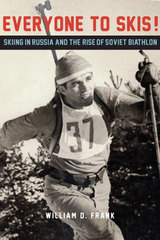 Everyone to Skis!: Skiing in Russia and the Rise of Soviet Biathlon
William D. Frank
Northern Illinois University Press, 2013 Nowhere in the world was the sport of biathlon, a combination of cross-country skiing and rifle marksmanship, taken more seriously than in the Soviet Union, and no other nation garnered greater success at international venues. From the introduction of modern biathlon in 1958 to the USSR’s demise in 1991, athletes representing the Soviet Union won almost half of all possible medals awarded in world championship and Olympic competition. Yet more than sheer technical skill created Soviet superiority in biathlon. The sport embodied the Soviet Union’s culture, educational system and historical experience and provided the perfect ideological platform to promote the state’s socialist viewpoint and military might, imbuing the sport with a Cold War sensibility that transcended the government’s primary quest for post-war success at the Olympics.
William D. Frank’s book is the first comprehensive analysis of how the Soviet government interpreted the sport of skiing as a cultural, ideological, political and social tool throughout the course of seven decades. In the beginning, the Soviet Union owned biathlon, and so the stories of both the state and the event are inseparable. Through the author’s unique perspective on biathlon as a former nationally-ranked competitor and current professor of Soviet history, Everyone to Skis! will appeal to students and scholars of Russian and Soviet history as well as to general readers with an interest in skiing and the development of twentieth-century sport.
 Everyone's Apocalypse: A Reflection Guide, 2nd Edition
Donal A. McIlraith
Saint Paul Seminary Press , 2024 Everyone’s Apocalypse attempts to respond to the request of Dei Verbum 22 that “Easy access to Sacred Scripture should be provided for all the faithful.” In this easy-to-read introduction for beginners, modern scholarship and the Church’s tradition meet to help readers understand and pray through this demanding part of God’s Word.
Following Ugo Vanni’s proved structure, the two parts of the Apocalypse (chapters 1–3 and 4–22) are presented in seven chapters. The opening two chapters show John’s vision of the Risen Jesus as Son of Man and his words to the seven churches of Asia Minor. Chapter three presents the vital section, full of worship, of the throne vision of God as creator and of Jesus, slaughtered and risen, as redeemer. The opening of the seven seals by the Lamb, the four horsemen, the Risen Jesus, the destruction wrought by the seven trumpets, the three signs of the Woman, the Dragon, and the seven angels with the seven bowls of wrath are dealt with in the next three chapters. The final chapter outlines the climax of the book. Harlot Babylon, the evil city, is judged and falls and, following the intervention of the bridegroom Lamb and the removal of God’s enemies, the marriage of the Lamb reaches its fulfillment when the prepared wife becomes the possessed bride. In the imagery of this text, the kingdom has come.
Uniquely, this book reads the entire Apocalypse in a nuptial manner. This is a love story. Jesus, the lover, following the pattern of Jewish marriage in the first century, helps his espoused wife, the seven churches, to persevere in their nuptial response of love to him, their first love. After coming through the tribulation, they finally become his beloved, possessed Bride, filled with glory. This eschatological union of love is humankind’s destiny.
 Everyone's Business: What Companies Owe Society
Amit Ron and Abraham A. Singer
University of Chicago Press, 2024 Business is political. What are the ethics of it? Businesses are political actors. They not only fund political campaigns, take stances on social issues, and wave the flags of identity groups – they also affect politics in their everyday hiring and investment decisions. As a highly polarized public demands political alignment from the powerful businesses they deal with, what’s a company to do? Amit Ron and Abraham Singer show that the unavoidably political role of companies in modern life is both the fundamental problem and inescapable fact of business ethics: corporate power makes business ethics necessary, and business ethics must strive to mitigate corporate power. Because of its economic and social influence, Ron and Singer forcefully argue that modern business’s primary social responsibility is to democracy. Businesses must work to avoid wielding their power in ways that undermine key democratic practices like elections, public debate, and social movements. Pragmatic and urgent, Everyone’s Business offers an essential new framework for how we pursue profit—and democracy—in our increasingly divided world.
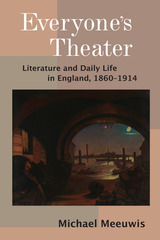 Everyone’s Theater: Literature and Daily Life in England, 1860–1914
Michael Meeuwis
University of Michigan Press, 2019 Nearly all residents of England and its colonies between 1860 and 1914 were active theatergoers, and many participated in the amateur theatricals that defined late Victorian life. The Victorian theater was not an abstract figuration of the world as a stage, but a media system enmeshed in mass lived experience that fulfilled in actuality the concept of a theatergoing nation. Everyone’s Theater turns to local history, the words of everyday Victorians found in their diaries and production records, to recover this lost chapter of theater history in which amateur drama domesticates the stage. Professional actors and playwrights struggled to make their productions compatible with ideas and techniques that could be safely reproduced in the home—and in amateur performances from Canada to India. This became the first true English national theater: a society whose myriad classes found common ground in theatrical display. Everyone’s Theater provides new ways to extend Victorian literature into the dimension of voice, sound, and embodiment, and to appreciate the pleasures of Victorian theatricality.
Everything
Andrea Cohen
Four Way Books, 2021 The poems in Everything, Andrea Cohen’s seventh collection, traffic in wonder and woe, in dialogue and interior speculation. Humor and gravity go hand in hand here. Cohen’s poems have the rueful irony of a stand-up comic playing to an empty room. But look around: there are wrecking balls, zebras, lovers, milk money. It’s a room to hang around in.
Everything Broken Up Dances
James Byrne
Tupelo Press, 2015 James Byrne’s first book to be published in America navigates personal and socio-political worlds, journeying through Burma, Libya, and Syria along with documenting the poet’s years in New York City and subsequent return to England. This is a flexible poetry written “on the hoof,” nomadic and innovative, with imagery and language dexterously sparring. Byrne embraces Maurice Blanchot’s avowal that the fragmentary is permanent, “beyond fracturing, or bursting, the patience of pure impatience, the little by little suddenly.” With linguistic tenacity but by tremendously varied means, Byrne shows how “everything that is broken up dances.”
 Everything Flirts: Philosophical Romances
Sharon Wahl
University of Iowa Press, 2024 2025 Carol Shields Prize for Fiction, longlist
At the heart of the stories in Everything Flirts are some of life’s trickiest questions: Why is it so hard to make the first move on a date? How do we find the person we will love? If you finally find a person to love, how do you convince them to love you back?
With a mixture of humor and reverence, Sharon Wahl hijacks classic works of philosophy and turns their focus to love. The philosopher Wittgenstein helps us consider the limits of language: Does there exist an argument, a logical deduction, that will cause another person to love us? The philosopher Zeno’s laws of motion stipulate that we can only ever cross half of any distance. This principle is applied to a first date, where making a first move becomes more and more impossible because the movie this couple goes to see is a depressing mood-killer. A woman afraid of love applies Bentham’s utilitarian principles to find her perfect match, testing every man she meets until she finds one who aces every one of her tests. Nonetheless, she wonders: Is he right for her? Is she ready to fall in love forever? The sublime and the ridiculous come together to playfully examine why love just might be a topic too hard for philosophers to explain.
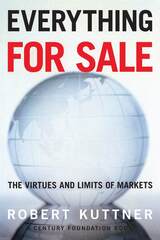 Everything for Sale: The Virtues and Limits of Markets
Robert Kuttner
University of Chicago Press, 1999 In this highly acclaimed, provocative book, Robert Kuttner disputes the laissez-faire direction of both economic theory and practice that has been gaining in prominence since the mid-1970s. Dissenting voices, Kuttner argues, have been drowned out by a stream of circular arguments and complex mathematical models that ignore real-world conditions and disregard values that can't easily be turned into commodities. With its brilliant explanation of how some sectors of the economy require a blend of market, regulation, and social outlay, and a new preface addressing the current global economic crisis, Kuttner's study will play an important role in policy-making for the twenty-first century.
"The best survey of the limits of free markets that we have. . . . A much needed plea for pragmatism: Take from free markets what is good and do not hesitate to recognize what is bad."—Jeff Madrick, Los Angeles Times
"It ought to be compulsory reading for all politicians—fortunately for them and us, it is an elegant read."—The Economist
"Demonstrating an impressive mastery of a vast range of material, Mr. Kuttner lays out the case for the market's insufficiency in field after field: employment, medicine, banking, securities, telecommunications, electric power."—Nicholas Lemann, New York Times Book Review
"A powerful empirical broadside. One by one, he lays on cases where governments have outdone markets, or at least performed well."—Michael Hirsh, Newsweek
"To understand the economic policy debates that will take place in the next few years, you can't do better than to read this book."—Suzanne Garment, Washington Post Book World
Everything Has Already Been Written: Moscow Conceptualist Poetry and Performance
Gerald Janecek
Northwestern University Press, 2019
Innovative poets such as Vsevolod Nekrasov, Lev Rubinstein, and Dmitry Prigov are among the most prominent literary figures of Russia in the 1980s and 1990s, yet they are virtually unknown outside Russia. The same is true of the numerous active Russian performance art groups, especially the pioneering Collective Actions group led by the brilliantly inventive Andrei Monastyrsky. Everything Has Already Been Written strives to make Moscow Conceptualism more accessible, to break the language barrier and to foster understanding among an international readership by thoroughly discussing a broad range of specific works and theories. Janecek’s study is the first comprehensive analysis of Moscow Conceptualist poetry and theory, vital for an understanding of Russian culture in the post‑Conceptualist era.
Everything I Kept: Todo Lo Que Guardé
Ruth Behar
Swan Isle Press, 2018 Moving between the speech and silence of a woman struggling to speak freely, Ruth Behar embarks on a poetic voyage into her own vulnerability and the sacrifices of her exiled ancestors as she tries to understand love, loss, regret, and the things we keep and carry with us. Behar’s vivid renderings of wilted gardens, crashing waves, and firefly-lit nights recall the imagery of her inspiration, Dulce María Loynaz, who is often known as the Cuban Emily Dickinson. Presented in a beautiful bilingual English-Spanish edition—Behar serves as her own translator—Everything I Kept/Todo lo que guardé will haunt readers with the cries and whispers which illuminate the human spirit and the spectrum of emotions that make for a life and lives well-remembered.
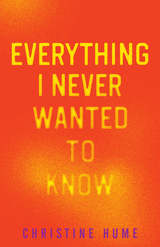 Everything I Never Wanted to Know
Christine Hume
Ohio State University Press, 2023 “A dauntless and harrowing indictment of patriarchal violence.” —Publishers Weekly
In Everything I Never Wanted to Know, Christine Hume confronts the stigma and vulnerability of women’s bodies in the US. She explores bodily autonomy and sexual assault alongside the National Sex Offender Registry in order to invoke not solutions but a willingness to complicate our ideas of justice and defend every human’s right to be treated like a member of the community. Feminist autobiography threads into historical narrative and cultural criticism about the Victorian-era Frozen Charlotte doll; the Nylon Riots of the 1940s; the movie Halloween; Larry Nassar, who practiced in Hume’s home state of Michigan; and other material. In these reflections on sexuality, gender, criminality, and violence, Hume asks readers to reconsider what we have collectively normalized and how we are each complicit, writing through the darkness of what we don’t want to see, what we’d rather not believe, and what some of us have long tried to forget.
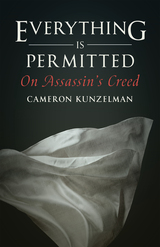 Everything Is Permitted: On Assassin's Creed
Cameron Kunzelman
University of Minnesota Press, 2025 An entertaining deep dive into the world, gameplay, and evolution of the hugely successful Assassin’s Creed video game franchise A hooded figure stands in a bell tower overlooking medieval Jerusalem, surveying his prey. Parkour-style, he leaps down into the square to kill his target before vanishing into the crowd . . . Released in fall 2007, Assassin’s Creed transformed video gaming. Across more than a dozen franchise entries, players engage with the eternal conflict between the Order of Assassins and the nefarious Templar Order, carrying out missions in a series of painstakingly rendered historical settings, from the Holy Lands during the Third Crusade to Renaissance Italy, the Age of Piracy, the French Revolution, and Victorian London. Everything is Permitted is an analysis of the development, evolution, gameplay, and world-building of this sprawling and distinctive franchise. Cameron Kunzelman examines key themes and concepts that connect the games in the series. Combining close readings of the games themselves with discussion of the broader landscape of video game franchises since its initial release, he uncovers what it means for a game to be part of the Assassin’s Creed franchise. Kunzelman maps the elements that contribute to the immersiveness and continual playability of the games, showing how historically inflected conspiracies and science fictional premises ground the fantastical stories the games tell on a massive scale. Diving into the real-world histories and ideas that the game designers used for inspiration, Kunzelman argues that the virtual conflicts between the franchise’s opposing sides offer intriguing insights into actual reality, from ethical dilemmas to the roles of freedom and fate. He demonstrates how, by incorporating themes of means and ends, control and freedom into its gameplay, the franchise engages with profound questions in a sustained, long-form way that is unique among video games. As the Assassins say, “Nothing is true, everything is permitted.” Retail e-book files for this title are screen-reader friendly with images accompanied by short alt text and/or extended descriptions.
Everything is Police
Tia Trafford
University of Minnesota Press, 2024 How institutional and interpersonal policing have been central to worldmaking
Policing is constitutive of colonial modernity: normalizing, internalizing, and legalizing anti-Black violence as the ongoing condition for white life and freedom. The result, Tia Trafford argues here, is a situation where we cannot practically experience or even imagine worlds free from policing. From the plantation to the prison, global apartheid, and pandemic control, this book examines why and how policing has become the most ingrained, commonsense—and insidious—way of managing our world.
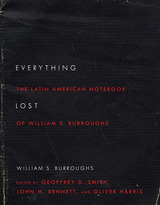 Everything Lost: The Latin American Notebook of William S. Burroughs, Revised Edition
William S. Burroughs, Edited by Geoffrey D. Smith, John M. Bennett, and Oliver Harris
Ohio State University Press, 2017 In late summer 1953, as he returned to Mexico City after a seven-month expedition through the jungles of Ecuador, Colombia, and Peru, William Burroughs began a notebook of final reflections on his four years in Latin America. His first novel, Junkie, had just been published and he would soon be back in New York to meet Allen Ginsberg and together complete the manuscripts of what became The Yage Letters and Queer. Yet this notebook, the sole survivor from that period, reveals Burroughs not as a writer on the verge of success, but as a man staring down personal catastrophe and visions of looming cultural disaster. Losses that will not let go of him haunt Burroughs throughout the notebook: “Bits of it keep floating back to me like memories of a daytime nightmare.” However, out of these dark reflections we see emerge vivid fragments of Burroughs’ fiction and, even more tellingly, unique, primary evidence for the remarkable ways in which his early manuscripts evolved. Assembled in facsimile and transcribed by Geoffrey D. Smith, John M. Bennett, and Burroughs scholar Oliver Harris, the notebook forces us to change the way we see both Burroughs and his writing at a turning point in his literary career.
Everything Man: The Form and Function of Paul Robeson
Shana L. Redmond
Duke University Press, 2020 From his cavernous voice and unparalleled artistry to his fearless struggle for human rights, Paul Robeson was one of the twentieth century's greatest icons and polymaths. In Everything Man Shana L. Redmond traces Robeson's continuing cultural resonances in popular culture and politics. She follows his appearance throughout the twentieth century in the forms of sonic and visual vibration and holography; theater, art, and play; and the physical environment. Redmond thereby creates an imaginative cartography in which Robeson remains present and accountable to all those he inspired and defended. With her bold and unique theorization of antiphonal life, Redmond charts the possibility of continued communication, care, and collectivity with those who are dead but never gone.
Everything That Hurt Us Becomes a Ghost: Poems
Sage Ravenwood
Gallaudet University Press, 2023 Sage Ravenwood is a deaf Indigenous poet whose work deals with the lingering, resurgent trauma of familial violence and the machinations of colonialism. Everything That Hurt Us Becomes a Ghost is a poet’s response to her place in the wider world, exploring grief, anger, tenderness, and defiance. Ravenwood sheds light on Indigenous issues such as MMIW (Missing and Murdered Indigenous Women) and the Native American boarding schools, but she also makes space to center the natural world and her reverence of it. The poems in this collection are unafraid to name rage and pain as driving emotions yet strive for understanding and a way forward to healing.
Everything that Linguists have Always Wanted to Know about Logic . . . But Were Ashamed to Ask
James D. McCawley
University of Chicago Press, 1993 McCawley supplements his earlier book—which covers such topics as presuppositional logic, the logic of mass terms and nonstandard quantifiers, and fuzzy logic—with new material on the logic of conditional sentences, linguistic applications of type theory, Anil Gupta's work on principles of identity, and the generalized quantifier approach to the logical properties of determiners.
Everything to Gain: Making the Most of the Rest of Your Life
Jimmy Carter
University of Arkansas Press, 1995 Everything to Gain, first published in 1987, is the warm account of Jimmy and Rosalynn Carter’s life after their years in the White House. They discuss their marriage and health issues, their work with Habitat for Humanity and the Carter Center, and much more.
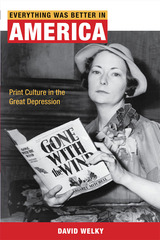 Everything Was Better in America: Print Culture in the Great Depression
David Welky
University of Illinois Press, 2007 As a counterpart to research on the 1930s that has focused on liberal and radical writers calling for social revolution, David Welky offers this eloquent study of how mainstream print culture shaped and disseminated a message affirming conservative middle-class values and assuring its readers that holding to these values would get them through hard times. Through analysis of the era's most popular newspaper stories, magazines, and books, Welky examines how voices both outside and within the media debated the purposes of literature and the meaning of cultural literacy in a mass democracy. He presents lively discussions of such topics as the newspaper treatment of the Lindbergh kidnapping, issues of race in coverage of the 1936 Olympic games, domestic dynamics and gender politics in cartoons and magazines, Superman's evolution from a radical outsider to a spokesman for the people, and the popular consumption of such novels as the Ellery Queen mysteries, Gone with the Wind, and The Good Earth. Through these close readings, Welky uncovers the subtle relationship between the messages that mainstream media strategically crafted and those that their target audience wished to hear.
 Everything We Could Do: A Novel
David McGlynn
Northwestern University Press, 2025 Set against the backdrop of a small-town Wisconsin NICU, a sweeping story of parenthood, family, and redemption
After a decade of miscarriages, Brooke Jensen is finally pregnant—with quadruplets. When she goes into labor after twenty-three weeks, Brooke and her husband rush to the hospital in the small town of Hanover, Wisconsin. For the 203 days that follow, they’re plunged into the terrifying and mysterious netherworld of the neonatal intensive care unit.
As the babies grow and struggle, fall turns to stark upper-Midwest winter. Brooke bonds with Dash, a senior nurse whose son, Landon, had been a patient in the NICU years earlier and is now straining his parents’ abilities to care for him. Both families bend and edge closer to breaking, and the questions mount: What does love look like? What does it mean to save a life?
A fiercely honest portrait of American parenthood, the American healthcare system, and Rust Belt communities, Everything We Could Do lays bare the ways that families are formed and remade in times of crisis.
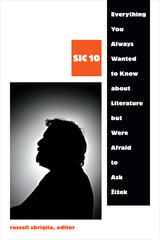 Everything You Always Wanted to Know about Literature but Were Afraid to Ask Žižek: SIC 10
Russell Sbriglia, editor
Duke University Press, 2017 Challenging the widely-held assumption that Slavoj Žižek's work is far more germane to film and cultural studies than to literary studies, this volume demonstrates the importance of Žižek to literary criticism and theory. The contributors show how Žižek's practice of reading theory and literature through one another allows him to critique, complicate, and advance the understanding of Lacanian psychoanalysis and German Idealism, thereby urging a rethinking of historicity and universality. His methodology has implications for analyzing literature across historical periods, nationalities, and genres and can enrich theoretical frameworks ranging from aesthetics, semiotics, and psychoanalysis to feminism, historicism, postcolonialism, and ecocriticism. The contributors also offer Žižekian interpretations of a wide variety of texts, including Geoffrey Chaucer's Troilus and Criseyde, Shakespeare's The Merchant of Venice, Samuel Beckett's Not I, and William Burroughs's Nova Trilogy. The collection includes an essay by Žižek on subjectivity in Shakespeare and Beckett. Everything You Always Wanted to Know about Literature but Were Afraid to Ask Žižek affirms Žižek's value to literary studies while offering a rigorous model of Žižekian criticism. Contributors. Shawn Alfrey, Daniel Beaumont, Geoff Boucher, Andrew Hageman, Jamil Khader, Anna Kornbluh, Todd McGowan, Paul Megna, Russell Sbriglia, Louis-Paul Willis, Slavoj Žižek
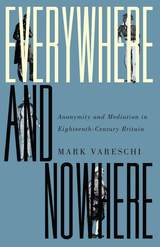 Everywhere and Nowhere: Anonymity and Mediation in Eighteenth-Century Britain
Mark Vareschi
University of Minnesota Press, 2018 A fascinating analysis of anonymous publication centuries before the digital age
Everywhere and Nowhere considers the ubiquity of anonymity and mediation in the publication and circulation of eighteenth-century British literature—before the Romantic creation of the “author”—and what this means for literary criticism. Anonymous authorship was typical of the time, yet literary scholars and historians have been generally unable to account for it as anything more than a footnote or curiosity.
Mark Vareschi shows the entangled relationship between mediation and anonymity, revealing the nonhuman agency of the printed text. Drawing richly on quantitative analysis and robust archival work, Vareschi brings together philosophy, literary theory, and media theory in a trenchant analysis, uncovering a history of textual engagement and interpretation that does not hinge on the known authorial subject. In discussing anonymous poetry, drama, and the novel along with anonymously published writers such as Daniel Defoe, Frances Burney, and Walter Scott, he unveils a theory of mediation that renews broader questions about agency and intention. Vareschi argues that textual intentionality is a property of nonhuman, material media rather than human subjects alone, allowing the anonymous literature of the eighteenth century to speak to contemporary questions of meaning in the philosophy of language. Vareschi closes by exploring dubious claims about the death of anonymity and the reexplosion of anonymity with the coming of the digital. Ultimately, Everywhere and Nowhere reveals the long history of print anonymity so central to the risks and benefits of the digital culture.
Everywhere Taksim: Sowing the Seeds for a New Turkey at Gezi
Edited by Isabel David and Kumru F. Toktamis
Amsterdam University Press, 2015 In May 2013, a small group of protesters made camp in Istanbul's Taksim Square, protesting the privatisation of what had long been a vibrant public space. When the police responded to the demonstration with brutality, the protests exploded in size and force, quickly becoming a massive statement of opposition to the Turkish regime. This book assembles a collection of field research, data, theoretical analyses, and cross-country comparisons to show the significance of the protests both within Turkey and throughout the world.
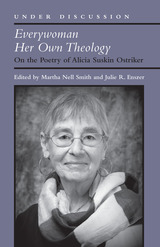 Everywoman Her Own Theology: On the Poetry of Alicia Suskin Ostriker
Martha Nell Smith and Julie R. Enszer, Editors
University of Michigan Press, 2018 Alicia Ostriker’s artistic and intellectual productions as a poet, critic, and essayist over the past 50 years are protean and have been profoundly influential to generations of readers, writers, and critics. In all her writings, both the feminist and the human engage fiercely with the material and metaphysical world. Ostriker is a poet concerned with questions of social justice, equality, religion, and how to live in a world marked by both beauty and tragedy.
Everywoman Her Own Theology: On the Poetry of Alicia Suskin Ostriker engages Ostriker’s poetry from throughout her career, including her first volume Songs, her award-winning collection The Imaginary Lover, and her more recent work in the collections No Heaven, the volcano sequence, The Old Woman, the Tulip, and the Dog, and Waiting for the Light. Like her literary criticism and essays, Ostriker’s poetry explores themes of feminism, Jewish life, family, and social justice.
With insightful essays—some newly written for this collection—poets and literary critics including Toi Derricotte, Daisy Fried, Cynthia Hogue, Tony Hoagland, and Eleanor Wilner illuminate and open new pathways for critical engagement with Alicia Ostriker’s lifetime of poetic work.
Everywoman’s Guide to Nutrition
Judith Brown
University of Minnesota Press, 1991
Everywoman’s Guide to Nutrition was first published in 1991.This comprehensive, practical book, based on Judith Brown’s considerable experience as a nutrition counselor, teacher, and researcher, is a resource women can turn to with confidence for information on nutrition and healthy eating. The author has talked extensively with women to identify the nutrition information they are looking for, and has tailored this book to meet their needs. Fertility, pregnancy, and breast-feeding are discussed, as are the prevention and treatment of obesity, heart disease, cancer, PMS, osteoporosis, and other health problems. Special attention has been given to the results of studies conducted with women. Unique features are a section of tasty, low-fat recipes developed for the book and a self-assessment exercise that helps identify the strengths and weaknesses of your current diet.
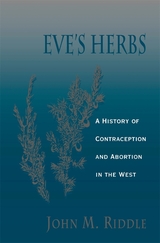 Eve’s Herbs: A History of Contraception and Abortion in the West
John M. Riddle
Harvard University Press, 1999 In Contraception and Abortion from the Ancient World to the Renaissance, John M. Riddle showed, through extraordinary scholarly sleuthing, that women from ancient Egyptian times to the fifteenth century had relied on an extensive pharmacopoeia of herbal abortifacients and contraceptives to regulate fertility. In Eve’s Herbs, Riddle explores a new question: If women once had access to effective means of birth control, why was this knowledge lost to them in modern times?
Beginning with the testimony of a young woman brought before the Inquisition in France in 1320, Riddle asks what women knew about regulating fertility with herbs and shows how the new intellectual, religious, and legal climate of the early modern period tended to cast suspicion on women who employed “secret knowledge” to terminate or prevent pregnancy. Knowledge of the menstrual-regulating qualities of rue, pennyroyal, and other herbs was widespread through succeeding centuries among herbalists, apothecaries, doctors, and laywomen themselves, even as theologians and legal scholars began advancing the idea that the fetus was fully human from the moment of conception.
Drawing on previously unavailable material, Riddle reaches a startling conclusion: while it did not persist in a form that was available to most women, ancient knowledge about herbs was not lost in modern times but survived in coded form. Persecuted as “witchcraft” in centuries past and prosecuted as a crime in our own time, the control of fertility by “Eve’s herbs” has been practiced by Western women since ancient times.
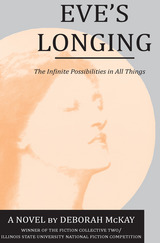 Eve's Longing: The Infinite Possibilities in All Things
Deborah McKay
University of Alabama Press, 1992 Eve's Longing: The Infinite Possibilities in All Things is a story of a modern fictional saint in the making. In the course of Eve's twin spiritual and physical journeys. Deborah McKay's moving yet unsentimental novel explores alarming real-life resolutions to universal complexities and offers instead of answers the seductive and dangerous experience of its captivating central character. Eve is a shockingly original character: at once a philosopher, an artist with a highly developed visual imagination, and a visionary mystic. Her longing, as the subtitle suggests, is for: the Infinite Possibilities in All Things." In the course of her journey, this longing, which is essentially spiritual and philosophical in origin, becomes for us immediately tangible, sensuous, and fully real. Eve's longing takes her from New York City to a monastery in Assisi, Italy, the home of St. Francis, then back again to New York. Along the way her longing grows into a desire so intense that it engenders a compassion verging on the saintly and a cruelty equally as extreme. Her desires, when unfulfilled, lead to sexual excesses, hallucinations, and transformative spiritual visions. In the course of Eve's journey we meet characters both alive and dead: her sister Claire, her parents, her lovers, St. Francis, and the Virgin Mary: and two of her most intimate companions, the Spiral and the Pearl String, both creations of her own mind. Eve's Longing creates almost a new literary genre in literature. It combines the intimacy of an entrusting autobiography with the intrigue of a novel and the cool detachment of a clinical study. The consequence of Eve's Fascination with "The Infinite Possibilities in All Things"—the temptation to which the original and our Eve succumb—is both an end and a beginning.
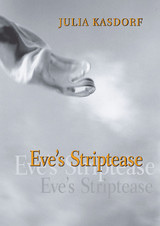 Eve's Striptease
Julia Spicher Kasdorf
University of Pittsburgh Press, 1998 "You have to admire a poet who can take an onion, the flu, houseguests, migraines, and a nurse's coat and turn them in to poetry. Of course, Kasdorf is using the concrete to get a deeper things: there's an amazement at life in these poems, and a hard-headed determination to make it work." --Library Journal
"It may initially seem as though Kasdorf has meant to shock the home folks with her new book. Think of her overall themes: Mennonites and sex, a novel connection. Yet Eve's Striptease uses these two lenses to focus on the world. However, viewing the book only in terms of ethnicity and biology trivializes what is a significant work by a brilliant young poet. . . . It is a book about coming to terms with one's sexuality and how that affects one's place in the world." --Pittsburgh Quarterly
"Most readers will be grateful for the gift outright of Kasdorf's achingly beautiful language of desire and of a "full store" of unavoidable passings from discovery to dark discovery and from expectations and surprises of childhood to retrospections and surprises of adulthood." --Mennonite Quarterly Review
"Crosshatched by body, spirit, and the relation between them; animated by bright instinctive exchanges between carnal and religious zones of experience; driven by an honest, explicitly female consciousness of what 'animal' and 'soul' might mean, the poems in Eve's Striptease keep pace with a considered life in its search for some consoling 'homeliness' in the world." --Eamon Grennan
Julia Kasdorf grew up in Western Pennsylvania. Her previous collection, Sleeping Preacher, was the winner of the 1991 Agnes Lynch Starrett Poetry Prize and was awarded the 1993 Great Lakes Colleges Association Award for New Writing. Eve's Striptease was named one of Library Journal's Top 20 Best Poetry Books of 1998. Her poems have appeared in the New Yorker, Poetry, and various anthologies and journals. She teaches at Messiah college and lives in Camp Hill, Pennsylvania.
 Evicted from Eternity: The Restructuring of Modern Rome
Michael Herzfeld
University of Chicago Press, 2009 Modern Rome is a city rife with contradictions. Once the seat of ancient glory, it is now often the object of national contempt. It plays a significant part on the world stage, but the concerns of its residents are often deeply parochial. And while they live in the seat of a world religion, Romans can be vehemently anticlerical. These tensions between the past and the present, the global and the local, make Rome fertile ground to study urban social life, the construction of the past, the role of religion in daily life, and how a capital city relates to the rest of the nation. Michael Herzfeld focuses on Rome’s historic Monti district and the wrenching dislocation caused by rapid economical, political, and social change. Evicted from Eternity tells the story of the gentrification of Monti—once the architecturally stunning home of a community of artisans and shopkeepers now displaced by an invasion of rapacious real estate speculators, corrupt officials, dithering politicians, deceptive clerics, and shady thugs. As Herzfeld picks apart the messy story of Monti’s transformation, he ranges widely over many aspects of life there and in the rest of the city, richly depicting the uniquely local landscape of globalization in Rome.
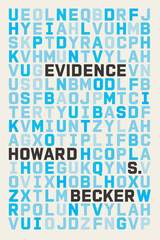 Evidence
Howard S. Becker
University of Chicago Press, 2017 Howard S. Becker is a master of his discipline. His reputation as a teacher, as well as a sociologist, is supported by his best-selling quartet of sociological guidebooks: Writing for Social Scientists, Tricks of the Trade, Telling About Society, and What About Mozart? What About Murder? It turns out that the master sociologist has yet one more trick up his sleeve—a fifth guidebook, Evidence.
Becker has for seventy years been mulling over the problem of evidence. He argues that social scientists don’t take questions about the usefulness of their data as evidence for their ideas seriously enough. For example, researchers have long used the occupation of a person’s father as evidence of the family’s social class, but studies have shown this to be a flawed measure—for one thing, a lot of people answer that question too vaguely to make the reasoning plausible. The book is filled with examples like this, and Becker uses them to expose a series of errors, suggesting ways to avoid them, or even to turn them into research topics in their own right. He argues strongly that because no data-gathering method produces totally reliable information, a big part of the research job consists of getting rid of error. Readers will find Becker’s newest guidebook a valuable tool, useful for social scientists of every variety.
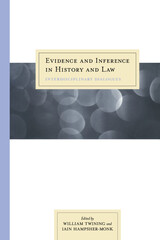 Evidence and Inference in History and Law: Interdisciplinary Dialogues
William Twining and Ian Hampsher-Monk
Northwestern University Press, 2003 Northwestern University Press co-published William Twining's Rethinking Evidence in 1994 and Analysis of Evidence in 1998. This new volume, Evidence and Inference, is an interdisciplinary volume exploring the application of techniques of evidence and inference across a variety of fields.
Coedited by Twining, one of the world's outstanding evidence scholars, and Iain Hampsher-Monk, a leading political theorist, the volume considers intriguing questions from Assyriology, theater iconography, musicology, criminology, the history of ideas, and colonial history as it reveals how particular concepts, lines of questioning, and techniques of reasoning and analysis developed in one context can be fruitfully applied in others. Did cuneiform languages really die out in the second or third century B.C.? Was Schubert responsible for any of the guitar arrangements for some of his lieder? In these cases and others, the authors' work demonstrates that, regardless of the field or the problem, all such projects involve drawing inferences from evidence, and that the logic of this kind of inquiry is always governed by the same principles.
 Evidence and Transcendence: Religious Epistemology and the God-World Relationship
Anne E. Inman
University of Notre Dame Press, 2008
In Evidence and Transcendence, Anne Inman critiques modern attempts to explain the knowability of God and points the way toward a religious epistemology that avoids their pitfalls. Christian apologetics faces two major challenges: the classic Enlightenment insistence on the need to provide evidence for anything that is put forward for belief; and the argument that all human knowledge is mediated by finite reality and thus no “knowledge” of a being interpreted as completely other than finite reality is possible.
Modern Christian apologists have tended to understand their task primarily, if not exclusively, in terms of one of these challenges. As examples of contemporary rationalist and postliberal approaches, Inman analyzes in depth the religious epistemologies of philosopher Richard Swinburne and theologians George Lindbeck and Ronald Theimann. She concludes that none of their positions is satisfactory, because none can uphold the notion of God’s transcendence while at the same time preserving a sound account of our claims to freedom and knowledge.
The root cause of such failures, Inman argues, is an inadequate philosophy of God and of the relation of God and the finite world. Her exploration of the theologies of Karl Rahner and Friedrich Schleiermacher provides the material for the constructive work in this book. Against rationalist and postliberal epistemologies, Inman calls for an austere grounding of Christian faith in the claim that God is known in human conscious activity as such, as the “other” that grounds the finite.
“An invaluable contribution to theology. It illuminates central issues of theology: the understanding of God, the demand for evidence, the rationality of Christian belief, and the relationship between philosophy and theology. It presents an excellent survey of several major theological approaches (analytic philosophy of religion, American neo-pragmatism, and continental theology) and offers a balanced proposal that seeks to incorporate the best from each approach. A must read for anyone interested in current approaches to God and Christian belief.” —Francis Schüssler Fiorenza, Stillman Professor of Roman Catholic Theological Studies, Harvard Divinity School
“Evidence and Transcendence addresses a critically important topic: the need for evidence (about God) and the insistence on the mediation of knowledge. Anne Inman’s ambitious project makes an original contribution to the field by framing the problem very well and bringing in a variety of thinkers to analyze it. The book will be welcomed by students and scholars of systematic theology and philosophy of God.” —Thomas M. Kelly, Creighton University
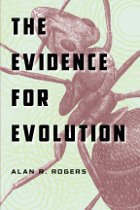 The Evidence for Evolution
Alan R. Rogers
University of Chicago Press, 2011 According to polling data, most Americans doubt that evolution is a real phenomenon. And it’s no wonder that so many are skeptical: many of today’s biology courses and textbooks dwell on the mechanisms of evolution—natural selection, genetic drift, and gene flow—but say little about the evidence that evolution happens at all. How do we know that species change? Has there really been enough time for evolution to operate? With The Evidence for Evolution, Alan R. Rogers provides an elegant, straightforward text that details the evidence for evolution. Rogers covers different levels of evolution, from within-species changes, which are much less challenging to see and believe, to much larger ones, say, from fish to amphibian, or from land mammal to whale. For each case, he supplies numerous lines of evidence to illustrate the changes, including fossils, DNA, and radioactive isotopes. His comprehensive treatment stresses recent advances in knowledge but also recounts the give and take between skeptical scientists who first asked “how can we be sure” and then marshaled scientific evidence to attain certainty. The Evidence for Evolution is a valuable addition to the literature on evolution and will be essential to introductory courses in the life sciences.
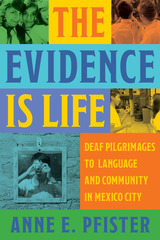 The Evidence Is Life: Deaf Pilgrimages to Language and Community in Mexico City
Anne E. Pfister
Gallaudet University Press, 2025 Drawing on theories of language socialization and communities of practice in an ethnographic study of deaf children and their families in Mexico City, sociolinguistic and medical anthropologist Anne E. Pfister shows how her participants reject stigmatizing social and biomedical beliefs about deafness. Grounded in over ten years of ethnographic research through participant observation, visual methods, and participatory analysis, The Evidence Is Life shares the story of La Familia López, a composite narrative woven from the common themes and experiences of the deaf individuals and families in Pfister’s study. The story of the Lopez family is framed as a pilgrimage, through which readers reflect on participating families’ journeys from confusion to profound transformation. Moving from a deficit perspective on deafness to discovering the value of accessible language, the families and children in this study eventually arrive at a community of belonging. Contextualized through Mexican history and institutional structures, The Evidence Is Life illuminates common experiences, challenges dominant narratives regarding deafness, and provides recommendations for families, educators, policymakers, medical professionals, and advocates working in deaf education.
Evidence: Its Meanings in Health Care and in Law, Volume 26
Mark Peterson, ed.
Duke University Press Evidence: Its Meanings in Health Care and in Law examines the ways in which scientists, clinical practitioners, judges, legal scholars, and juries interpret and use evidence. The articles find that the concept and attributes of "evidence" depend on where one sits. They recognize the time-honored legal and medical science interpretation and operationalization of "evidence" while, at the same time, acknowledging that the health care system and the legal system would each benefit by sustained efforts of mutual education of practitioners in both fields.
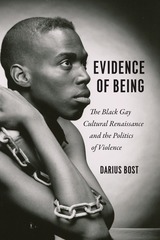 Evidence of Being: The Black Gay Cultural Renaissance and the Politics of Violence
Darius Bost
University of Chicago Press, 2018 Evidence of Being opens on a grim scene: Washington DC’s gay black community in the 1980s, ravaged by AIDS, the crack epidemic, and a series of unsolved murders, seemingly abandoned by the government and mainstream culture. Yet in this darkest of moments, a new vision of community and hope managed to emerge. Darius Bost’s account of the media, poetry, and performance of this time and place reveals a stunning confluence of activism and the arts. In Washington and New York during the 1980s and ’90s, gay black men banded together, using creative expression as a tool to challenge the widespread views that marked them as unworthy of grief. They created art that enriched and reimagined their lives in the face of pain and neglect, while at the same time forging a path toward bold new modes of existence. At once a corrective to the predominantly white male accounts of the AIDS crisis and an openhearted depiction of the possibilities of black gay life, Evidence of Being above all insists on the primacy of community over loneliness, and hope over despair.
Evidence of Editing: Growth and Change of Texts in the Hebrew Bible
Reinhard Müller
SBL Press, 2014 A new perspective on editorial activity in the Hebrew Bible for research and teaching
Evidence of Editing lays out the case for substantial and frequent editorial activity within the Hebrew Bible. The authors show how editors omitted, expanded, rewrote, and compiled both smaller and larger phrases and passages to address religious and political change. The book refines the exegetical method of literary and redaction criticism, and its results have important consequences for the future use of the Hebrew Bible in historical and theological studies.
Features:
- Hebrew, Greek, and Aramaic examples of editorial activity
- Clear explanations of the distinctions between textual, literary, and redaction criticism
- Fifteen chapters attesting to continual editorial activity in the Torah, the Prophets, and the Writings
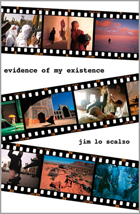 Evidence of My Existence
Jim Lo Scalzo
Ohio University Press, 2007 From a leper colony in India to an American research station on the Antarctic Peninsula, from the back rooms of the White House to the battlefields of Iraq and Afghanistan, Evidence of My Existence tells a unique and riveting story of seventeen years spent racing from one photo assignment to the next. It is also a story of photojournalism and theconsequences of obsessive wanderlust.
When the book opens, Jim Lo Scalzo is a blur to his wife, her remarkable tolerance wearing thin. She is heading to the hospital with her second miscarriage, and Jim is heading to Baghdad to cover the American invasion of Iraq. He hates himself for this—for not giving her a child, for deserting her when she soobviously needs him, for being consumed by his job—but how to stop moving? Sure, there have been some tough trips. He’s been spit on by Mennonites in Missouri, by heroin addicts in Pakistan, and by the KKK in South Carolina. He’s contracted hepatitis on the Navajo Nation, endured two bouts of amoebic dysentery in India and Burma and four cases of giardia in Nepal, Peru, Afghanistan, and Cuba. He’s been shot with rubber bullets in Seattle, knocked to the ground by a water cannon in Quebec, and sprayed with more teargas than he cares to recall. But photojournalism is his career, and travel is his compulsivecraving.
We follow Lo Scalzo through the maze of airports and crowds and countries as he chases the career he has always wanted, struggles with his family problems, and reveals the pleasures of a life singularly focused. For him, as for so many photojournalists, it is always about the going.
Evidence Of Purpose: Scientists Discover The Creator
John Marks Templeton
Templeton Press, 1996
For nearly a century, the central theological message of science seemed to be that there was no need for theology: science could stand alone to explain the universe. But today, that message is changing. In this volume, a gallery of respected scientists describes new developments in their fields and their relationship with theological views of the universe. Contributors include Owen Gingerich, Russell Stannard, Paul Davies, Walter R. Hearn, Robert Russell, Arthur Peacocke, John Polkinghorne, John C. Eccles, Daniel H. Osmond, and David Wilcox.
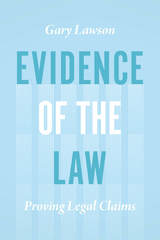 Evidence of the Law: Proving Legal Claims
Gary Lawson
University of Chicago Press, 2017 How does one prove the law? If your neighbor breaks your window, the law regulates how you can show your claim to be true or false; but how do you prove that in breaking your window your neighbor has broken the law? American jurisprudence devotes an elaborate body of doctrine—and an equally elaborate body of accompanying scholarly commentary—to worrying about how to prove facts. It establishes rules for the admissibility of evidence, creates varying standards of proof, and assigns burdens of proof that determine who wins or loses when the facts are unclear. But the law is shockingly inexplicit when addressing these issues with respect to the proof of legal claims. Indeed, the entire language of evidentiary proof, so sophisticated when it comes to questions of fact, is largely absent from the American legal system with respect to questions of law.
As Gary Lawson shows, legal claims are inherently objects of proof, and whether or not the law acknowledges the point openly, proof of legal claims is just a special case of the more general norms governing proof of any claim. As a result, similar principles of evidentiary admissibility, standards of proof, and burdens of proof operate, and must operate, in the background of claims about the law. This book brings these evidentiary principles for proving law out of the shadows so that they can be analyzed, clarified, and discussed. Viewing legal problems through this lens of proof illuminates debates about everything from constitutional interpretation to the role of stipulations in litigation. Rather than prescribe resolutions to any of those debates, Evidence of the Law instead provides a set of tools that can be used to make those debates more fruitful, whatever one’s substantive views may be. As lawyers, judges, and legal subjects confront uncertainty about what the law is, they can, should, and must, Lawson argues, be guided by the same kinds of abstract considerations, structures, and doctrines long used to make determinations about questions of fact.
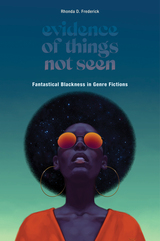 Evidence of Things Not Seen: Fantastical Blackness in Genre Fictions
Rhonda D. Frederick
Rutgers University Press, 2022 Evidence of Things Not Seen: Fantastical Blackness in Genre Fictions is an interdisciplinary study of blackness in genre literature of the Americas. The “fantastical” in fantastical blackness is conceived by an unrestrained imagination because it lives, despite every attempt at annihilation. This blackness amazes because it refuses the limits of anti-blackness. As put to work in this project, fantastical blackness is an ethical praxis that centers black self-knowledge as a point of departure rather than as a reaction to threatening or diminishing dominant narratives. Mystery, romance, fantasy, mixed-genre, and science fictions’ unrestrained imaginings profoundly communicate this quality of blackness, specifically here through the work of Barbara Neely, Colson Whitehead, Nalo Hopkinson, and Colin Channer. When black writers center this expressive quality, they make fantastical blackness available to a broad audience that then uses its imaginable vocabularies to reshape extra-literary realities. Ultimately, popular genres’ imaginable possibilities offer strategies through which the made up can be made real.
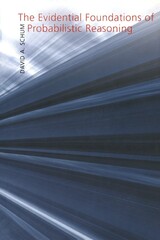 The Evidential Foundations of Probabilistic Reasoning
David A. Schum
Northwestern University Press, 2001 No matter how irrefutable it may seem, evidence is often a matter of interpretation. Incomplete, inconclusive, imprecise, or vague, it is nonetheless the basis of myriad everyday conclusions and decisions. In this authoritative work, David A. Schum develops a general theory of evidence as it is understood and applied across a broad range of disciplines and practical undertakings.
Synthesizing insights from law, philosophy and logic, probability, semiotics, artificial intelligence, psychology, and history, Schum provides a detailed examination of the various properties and uses of evidence and the evaluative skills evidence requires. Along with the evidential subtleties of probabilistic reasoning, Schum also explores the processes by which evidence is generated or discovered and looks at the intellectual and practical underpinnings of probabilistic reasoning. It is a useful resourse for students, researchers, and practitioners of every discipline concerned with evidence and its inferential use.
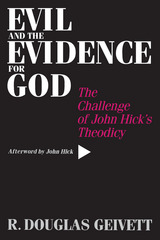 Evil & the Evidence For God: The Challenge of John Hick's Theodicy
R. Geivett
Temple University Press, 1995 "By appealing to recent scientific opinion that the universe may well have had an absolute beginning, Geivett develops an interesting, forceful argument for the rationality of belief in God. He then expounds the Augustinian free will theodicy and defends it against Hick's criticisms."
--William L. Rowe
How to reconcile the existence of evil with the belief in a benevolent God has long posed a philosophical problem to the system of Christian theism. John Hick's book, Evil and the Love of God, is perhaps the best known work to redress this difficulty in modern terms. Sharing Hick's interest in responding to the question of evil, R. Douglas Geivett constructs his own new "theodicy for today." But Geivett departs from Hick by embracing the Augustinian tradition of free will and returning the responsibility for evil to human beings themselves.
Reviews
"Moving from a comparison of the Irenaean and Augustinian traditions in theodicy to a powerfully original critique of Hick's influential 'soul-making' theodicy, Geivett presents a richly developed natural theology drawing on contemporary scientific opinion in support of an ex nihilo creation. Geivett's writing on natural theology is lucid and informed, honestly engaging many of that tradition's critics....This work is notable for its exceptionally thorough documentation and references, making it a valuable sourcebook for reflection on God and evil. A stimulating afterword by Hick himself significantly enriches this book's provocative analyses."
--Religious Studies Review
"Geivett details a natural theology and develops a way of understanding the existence of evil that places the fact of evil within, rather than in opposition to, a theistic view. Both the natural theology and the theodicy are rich and complex."
--Keith E. Yandell, University of Wisconsin
"In this interesting and worthwhile work, Geivett's statement of arguments in natural theology is fuller and fairer than that given by Hick in his writings. This book is an outstanding contribution to the field."
--Richard L. Purtill, Western Washington University
Contents
Preface
Part I: Two Traditions
1. The Problem of Evil
2. The Augustinian Tradition
3. John Hick's Theodicy
Part II: Religious Epistemology
4. The Value of Natural Theology
5. The Danger of Dismissing Natural Theology
6. The Possibility of Natural Theology, Part 1: The Argument for a Non-Natural Reality
7. The Possibility of Natural Theology, Part 2: Personality, Power, and Providence
8. Explanation and Religious Ambiguity
Part III: Theodicy Proper
9. John Hick's View of Divine Purpose
10. The Augustinian View of Divine Purpose
11. Free Will and Evil
12. Evil and the Afterlife
Afterword by John Hick
Notes
Index
About the Author(s)
R. Douglas Geivett is Associate Professor of Philosophy at Biola University in La Mirada, California.
Evil and Exile: Revised Edition
Michaël de Saint Cheron
University of Notre Dame Press, 2000 “Throughout this book, Wiesel's understanding of the human condition offers both an honest assessment and also hope that we may learn to live with one another in harmony.” —The Jewish Book News
“Saint-Cheron probes deeply, asking searching questions about evil, responsibility, faith, and the meaning of life as well as addressing topics of current political import. Wiesel responds passionately, offering, many penetrating, personal comments.” —Library Journal
Evil and/or/as the Good: Omnicentrism, Intersubjectivity, and Value Paradox in Tiantai Buddhist Thought
Brook Ziporyn
Harvard University Press, 2000 “Other than the devil, there is no Buddha; other than the Buddha, there is no devil.” The Chinese monk Siming Zhili (960–1028) uttered this remark as part of his justification for his self-immolation. An exposition of the intent, implications, and resonances of this one sentence, this book expands and unravels the context in which the seeming paradox of the ultimate identity of good and evil is to be understood. In analyzing this idea, Brook Ziporyn provides an overview of the development of Tiantai thought from the fifth through the eleventh centuries in China and contributes to our understanding of Chinese intellectual culture and Chinese Buddhism, as well as to basic ontological, epistemological, and axiological issues of interest in modern philosophy.
 Evil Arabs in American Popular Film: Orientalist Fear
By Tim Jon Semmerling
University of Texas Press, 2006 2006 — Runner-up, Arab American National Museum Book Awards The "evil" Arab has become a stock character in American popular films, playing the villain opposite American "good guys" who fight for "the American way." It's not surprising that this stereotype has entered American popular culture, given the real-world conflicts between the United States and Middle Eastern countries, particularly since the oil embargo of the 1970s and continuing through the Iranian hostage crisis, the first and second Gulf Wars, and the ongoing struggle against al-Qaeda. But when one compares the "evil" Arab of popular culture to real Arab people, the stereotype falls apart. In this thought-provoking book, Tim Jon Semmerling further dismantles the "evil" Arab stereotype by showing how American cultural fears, which stem from challenges to our national ideologies and myths, have driven us to create the "evil" Arab Other. Semmerling bases his argument on close readings of six films (The Exorcist, Rollover, Black Sunday, Three Kings, Rules of Engagement, and South Park: Bigger, Longer & Uncut), as well as CNN's 9/11 documentary America Remembers. Looking at their narrative structures and visual tropes, he analyzes how the films portray Arabs as threatening to subvert American "truths" and mythic tales—and how the insecurity this engenders causes Americans to project evil character and intentions on Arab peoples, landscapes, and cultures. Semmerling also demonstrates how the "evil" Arab narrative has even crept into the documentary coverage of 9/11. Overall, Semmerling's probing analysis of America's Orientalist fears exposes how the "evil" Arab of American popular film is actually an illusion that reveals more about Americans than Arabs.
Evil by Design: The Creation and Marketing of the Femme Fatale
Elizabeth K. Menon
University of Illinois Press, 2000
Evil by Design documents the search for the origins of the iconic “femme fatale.” Depicted as a dangerous, depraved, and deadly woman, this image was found frequently in Salon paintings from 1885 to 1910.
Elizabeth K. Menon’s study is the first to use popular sources to make the critical link between the femme fatale and the rise of feminism. In addition to the Salon paintings, Menon sifts through a variety of popular sources, including French illustrated journals, literature, posters, and decorative arts. Over 120 images depict women with serpents, evil flowers, and even miniature men having their hearts cooked. She argues that the evolution of the femme fatale, with both literary and visual links to the biblical Eve figure, came as a response to increasing feminism and the desire by men to halt its spread.
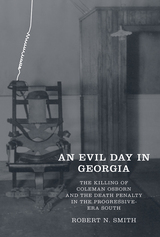 An Evil Day in Georgia: The Killing of Coleman Osborn and the Death Penalty in the Progressive-Era South
Robert Neil Smith
University of Tennessee Press, 2015 "American history is cluttered with wrongful convictions and miscarriages of justice.
In An Evil Day in Georgia, author Robert Smith raises lingering questions about the
guilt of two men—one white and one black—executed for a murder in the Deep South
in the 1920s. . . . The telling of this story, one that played out in the Jim Crow era and the
days of bootlegging and the Ku Klux Klan, exposes the death penalty’s imperfections even
as it calls into question the veracity of a woman’s confession, later recanted, that
once brought her within a stone’s throw of the state’s electric chair.”
—John Bessler, author of Cruel and Unusual: The American Death Penalty
and the Founders’ Eighth Amendment
On the night of August 5, 1927, someone shot and killed Coleman Osborn, a store owner in
Chatsworth, Georgia, in his place of business. Police and neighbors found only circumstantial
traces of the murderer: tire tracks, boot prints, shell casings, and five dollars in cash near
Osborn’s body. That day, three individuals—James Hugh Moss, a black family man locally
renowned for his baseball skills; Clifford Thompson, Moss’s white friend who grew up in the
Smoky Mountains; and Eula Mae Thompson, Clifford’s wife and a woman with a troubling history
of failed marriages and minor run-ins with the law—left Etowah, Tennessee, unknowingly
on a collision course with Deep South justice.
In chilling detail, Robert N. Smith examines the circumstantial evidence and deeply flawed
judicial process that led to death sentences for Moss and the Thompsons. Moving hastily in the
wake of the crime, investigators determined from the outset that the Tennessee trio, well known
as bootleggers, were the culprits. Moss and Clifford Thompson were tried and convicted within a
month of the murder. Eula Mae was tried separately from the other two defendants in February
1928, and her sentence brought her notoriety and celebrity status. On the night of her husband’s
execution, she recanted her original story and would change it repeatedly in the following years.
As reporters from Atlanta and across Georgia descended on Murray County to cover the trials
and convictions, the public perception of Eula Mae changed from that of cold-blooded murderer
to victim—one worthy of certain benefits that suited her status as a white woman. Eula Mae
Thompson’s death sentence was commuted in 1928, thanks in part to numerous press interviews
and staged photos. She was released in 1936 but would not stay out of trouble for long.
An Evil Day in Georgia exposes the historic deficiencies in death penalty implementation
and questions, through its case study of the Osborn murder, whether justice can ever be truly
unbiased when capital punishment is inextricably linked to personal and political ambition and
to social and cultural values.
Robert N. Smith is an independent scholar living in Oxford, England.
Evil Dead Center: A Mystery
Carole laFavor
University of Minnesota Press, 2017 An Ojibwa woman has been found dead on the outskirts of the Minnesota Red Earth Reservation. The coroner ruled the death a suicide, but after an ex-lover comes back into her life saying foul play was involved, Renee LaRoche wants to prove otherwise. As the events begin to unfold, Renee conducts a presumably normal welfare check on a young Ojibwa boy in foster care. After she learns the boy has suffered abuse, Renee finds herself amid an investigation into the foster care system and the deep trauma it has inflicted on the Ojibwa people. As Renee uncovers horrible truths, she must work through her own childhood issues to help shine a light on the dark web she has stumbled into.
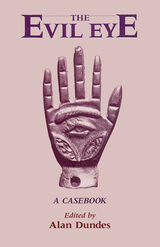 The Evil Eye: A Casebook
Alan Dundes
University of Wisconsin Press, 1992 The evil eye—the power to inflict illness, damage to property, or even death simply by gazing at or praising someone—is among the most pervasive and powerful folk beliefs in the Indo-European and Semitic world. It is also one of the oldest, judging from its appearance in the Bible and in Sumerian texts five thousand years old. Remnants of the superstition persist today when we drink toasts, tip waiters, and bless sneezers. To avert the evil eye, Muslim women wear veils, baseball players avoid mentioning a no-hitter in progress, and traditional Jews say their business or health is "not bad" (rather than "good").
Though by no means universal, the evil eye continues to be a major factor in the behavior of millions of people living in the Mediterranean and Arab countries, as well as among immigrants to the Americas. This widespread superstition has attracted the attention of many scholars, and the twenty-one essays gathered in this book represent research from diverse perspectives: anthropology, classics, folklore studies, ophthalmology, psychiatry, psychoanalysis, sociology, and religious studies. Some essays are fascinating reports of beliefs about the evil eye, from India and Iran to Scotland and Slovak-American communities; others analyze the origin, function, and cultural significance of this folk belief from ancient times to the present day. Editor Alan Dundes concludes the volume by proffering a comprehensive theoretical explanation of the evil eye.
Anyone who has ever knocked on wood to ward off misfortune will enjoy this generous sampling of evil eye scholarship, and may never see the world through the same eyes again.
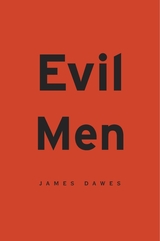 Evil Men
James Dawes
Harvard University Press, 2013 Presented with accounts of genocide and torture, we ask how people could bring themselves to commit such horrendous acts. A searching meditation on our all-too-human capacity for inhumanity, Evil Men confronts atrocity head-on—how it looks and feels, what motivates it, how it can be stopped.
Drawing on firsthand interviews with convicted war criminals from the Second Sino-Japanese War (1937–1945), James Dawes leads us into the frightening territory where soldiers perpetrated some of the worst crimes imaginable: murder, torture, rape, medical experimentation on living subjects. Transcending conventional reporting and commentary, Dawes’s narrative weaves together unforgettable segments from the interviews with consideration of the troubling issues they raise. Telling the personal story of his journey to Japan, Dawes also lays bare the cultural misunderstandings and ethical compromises that at times called the legitimacy of his entire project into question. For this book is not just about the things war criminals do. It is about what it is like, and what it means, to befriend them.
Do our stories of evil deeds make a difference? Can we depict atrocity without sensational curiosity? Anguished and unflinchingly honest, as eloquent as it is raw and painful, Evil Men asks hard questions about the most disturbing capabilities human beings possess, and acknowledges that these questions may have no comforting answers.
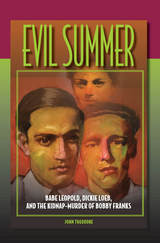 Evil Summer: Babe Leopold, Dickie Loeb, and the Kidnap-Murder of Bobby Franks
John Theodore
Southern Illinois University Press, 2007 In 1924, fourteen-year-old Bobby Franks was abducted while walking home from school, killed by a chisel blow to his head, and later found stuffed in a culvert in a marshy wasteland at the Illinois-Indiana state line. Acid had been poured over his naked body. Evil Summer examines the shocking kidnapping and murder of Franks by two University of Chicago students, Nathan “Babe” Leopold and Richard “Dickie” Loeb, both from families of privilege.
In this new examination of the crime, author John Theodore takes readers into the minds of the two criminals as he focuses on three months in 1924. Theodore covers the killing, the confessions, the defense, and the sentencing surrounding the horrific murder, placing the killers’ actions and Clarence Darrow’s historic defense into the context of 1920s Chicago.
Theodore deftly investigates the psychological dimensions of the crime, revealing the murderers’ fantasies, relationships, sexuality, and motives. The author examines the killers’ past, outlining Loeb’s obsession with detective fiction and crime and his editorial on random killing—written at age nine—and Leopold’s nightly master-slave fantasies and fascination with Nietzsche.
Evil Summer, which includes twenty-three illustrations, meticulously traces the murder from inception to confession, including such details as the special-delivery ransom letter sent to Jacob Franks and the discovery of Leopold’s horn-rimmed eyeglasses lying on a railroad embankment near Bobby’s dead body. Theodore re-creates such scenes as the convergence of hundreds of people in front of the Franks home, Bobby’s body lying in a small white casket in the library, and Loeb being voyeuristically drawn to the home while Bobby’s classmates carry the casket to the hearse.
Worldwide press coverage reflected the public fascination with the case in what was then called “the trial of the century.” The story became a media circus: Chicago’s six daily newspapers battled vigorously for readers, two Daily News cub reporters became part of the story, and the Chicago Tribune carried a voting ballot asking readers whether radio station WGN should broadcast the courtroom spectacle. The changing drama was delivered to Chicagoans every morning and evening, and the public feasted on every press run.
More than a crime story, Evil Summer illuminates the dark side of American life in the 1920s, including the excesses of privileged youth, the troubled childhoods, the random victimization, the anti-Semitism, and the sexuality.
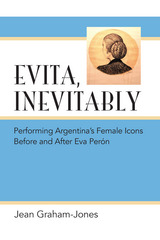 Evita, Inevitably: Performing Argentina's Female Icons Before and After Eva Perón
Jean Graham-Jones
University of Michigan Press, 2014 Evita, Inevitably sheds new light on the history and culture of Argentina by examining the performances and reception of the country’s most iconic female figures, in particular, Eva Perón, who rose from poverty to become a powerful international figure. The book links the Evita legend to a broader pattern of female iconicity from the mid-nineteenth century onward, reading Evita against the performances of other female icons: Camila O’Gorman, executed by firing squad over her affair with a Jesuit priest; Difunta Correa, a devotional figure who has achieved near-sainthood; cumbia-pop performer Gilda; the country’s patron saint, the Virgin of Luján; and finally, Argentina’s president, Cristina Fernández de Kirchner. Employing the tools of discursive, visual, and performance analysis, Jean Graham-Jones studies theatrical performance, literature, film, folklore, Catholic iconography, and Internet culture to document the ways in which these “femicons” have been staged.
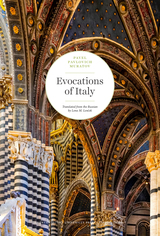 Evocations of Italy
Pavel Pavlovic Muratov and Lena Lencek (Trans.)
Northwestern University Press, 2026 A collector’s edition of a world-historical classic
In 1907, Pavel Muratov, a budding littérateur and art connoisseur from Moscow, set off for Italy with his wife, three friends, and a dozen books on the Italian Renaissance. This journey, the first of over a dozen he would make in a decade, inspired an obsession with the country’s art and culture that would produce, in the words of Clive James, “one of the most dazzling books of its type ever written.” First published in Russian between 1911 and 1924, Evocations of Italy(Obrazy Italii) chronicles Muratov’s encounters with the art, myth, and land of Italy. A classic of the Silver Age, it built on the tradition of Italian travelogues by Goethe, Stendhal, John Ruskin, and Henry James and defined the idea of Italy for generations of Russian artists and writers. Finally available in English, this three-volume collector's edition illuminates the personalities, conditions, and dreams that gave us the Italian Renaissance. At once intimate and authoritative, and here richly illustrated with photographs that echo Muratov’s shimmering juxtapositions of image and sensation, Evocations of Italy is as timely and compelling a guide today as it was a hundred years ago.
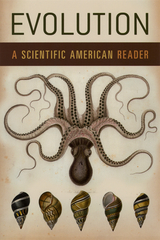 Evolution: A Scientific American Reader
Edited by Scientific American
University of Chicago Press, 2006 From the Scopes “Monkey Trial” of 1925 to the court ruling against the Dover Area School Board’s proposed intelligent design curriculum in 2005, few scientific topics have engendered as much controversy—or grabbed as many headlines—as evolution. And since the debate shows no signs of abating, there is perhaps no better time to step back and ask: What is evolution? Defined as the gradual process by which something changes into a different and usually more complex and efficient form, evolution explains the formation of the universe, the nature of viruses, and the emergence of humans. A first-rate summary of the actual science of evolution, this Scientific American reader is a timely collection that gives readers an opportunity to consider evolution’s impact in various settings.
Divided into four sections that consider the evolution of the universe, cells, dinosaurs, and humans, Evolution brings together more than thirty articles written by some of the world’s most respected evolutionary scientists. As tour guides through the genesis of the universe and complex cells, P. James E. Peebles examines the evidence in support of an expanding cosmos, while Christian de Duve discusses the birth of eukaryotes. In an article that anticipated his book Full House, Stephen Jay Gould argues that chance and contingency are as important as natural selection for evolutionary change. And Ian Tatersall makes two fascinating contributions, submitting his view that the schematic of human evolution looks less like a ladder and more like a bush.
With the latest on what’s being researched at every level of evolutionary studies, from prospects of life on other planets to the inner working of cells, Evolution offers general readers an opportunity to update their knowledge on this hot topic while giving students an introduction to the problems and methodologies of an entire field of inquiry.
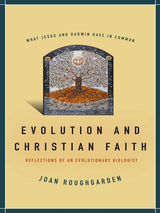 Evolution and Christian Faith: Reflections of an Evolutionary Biologist
Joan Roughgarden
Island Press, 2006 "I'm an evolutionary biologist and a Christian," states Stanford professor Joan Roughgarden at the outset of her groundbreaking new book, Evolution and Christian Faith: Reflections of an Evolutionary Biologist. From that perspective, she offers an elegant, deeply satisfying reconciliation of the theory of evolution and the wisdom of the Bible.
Perhaps only someone with Roughgarden's unique academic standing could examine so well controversial issues such as the teaching of intelligent design in public schools, or the potential flaws in Darwin's theory of evolution. Certainly Roughgarden is uniquely suited to reference both the minutiae of scientific processes and the implication of Biblical verses. Whether the topic is mutation rates and lizards or the hidden meanings behind St. Paul's letters, Evolution and Christian Faith distils complex arguments into everyday understanding. Roughgarden has scoured the Bible and scanned the natural world, finding examples time and again, not of conflict, but of harmony.
The result is an accessible and intelligent context for seeing a Christian vision of the world that embraces science. In the ongoing debates over creationism and evolution, Evolution and Christian Faith will be seen as a work of major significance, written for contemporary readers who wonder how-or if-they can embrace scientific advances while maintaining their traditional values.
 Evolution and Christian Faith: Reflections of an Evolutionary Biologist
Joan Roughgarden
Island Press, 2006 Click here to visit evolutionandchristianfaith.org
"I'm an evolutionary biologist and a Christian," states Stanford professor Joan Roughgarden at the outset of her groundbreaking new book, Evolution and Christian Faith: Reflections of an Evolutionary Biologist. From that perspective, she offers an elegant, deeply satisfying reconciliation of the theory of evolution and the wisdom of the Bible.
Perhaps only someone with Roughgarden's unique academic standing could examine so well controversial issues such as the teaching of intelligent design in public schools, or the potential flaws in Darwin's theory of evolution. Certainly Roughgarden is uniquely suited to reference both the minutiae of scientific processes and the implication of Biblical verses. Whether the topic is mutation rates and lizards or the hidden meanings behind St. Paul's letters, Evolution and Christian Faith distils complex arguments into everyday understanding. Roughgarden has scoured the Bible and scanned the natural world, finding examples time and again, not of conflict, but of harmony.
The result is an accessible and intelligent context for a Christian vision of the world that embraces science. In the ongoing debates over creationism and evolution, Evolution and Christian Faith will be seen as a work of major significance, written for contemporary readers who wonder how-or if-they can embrace scientific advances while maintaining their traditional values.
Evolution and Culture
Marshall D. Sahlins and Elman R. Service, Editors
University of Michigan Press, 1960 A unified interpretation of the evolution of species, humanity, and society
 Evolution and Environment in Tropical America
Edited by Jeremy B. C. Jackson, Ann F. Budd, and Anthony G. Coates
University of Chicago Press, 1996 How were the tropical Americas formed? This ambitious volume draws on extensive, multidisciplinary research to develop new views of the geological formation of the isthmus linking North and South America and of the major environmental changes that reshaped the Neotropics to create its present-day marine and terrestrial ecosystems.
Recent discoveries show that dramatic changes in climate and ocean circulation can occur very quickly, and that ecological communities respond just as rapidly. Abrupt changes in the composition of fossil assemblages, formerly dismissed as artifacts of a poor fossil record, now are seen as accurate records of swift changes in the composition of ocean communities.
The twenty-four contributors use current work in paleontology, geology, oceanography, anthropology, ecology, and evolution to paint this challenging portrait of rapid environmental and evolutionary change. Their conclusions argue for a revision of existing interpretations of the fossil record and the processes—including invading Eurasian peoples—that have produced it.
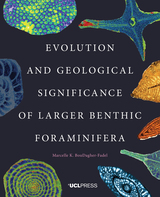 Evolution and Geological Significance of Larger Benthic Foraminifera
Marcelle K. BouDagher-Fadel
University College London, 2018 Evolution and Geological Significance of Larger Benthic Foraminifera is a comprehensive reference work on the larger benthic foraminifera. This second edition is substantially revised, including extensive reanalysis of the most recent work on Cenozoic forms. It provides documentation of the biostratigraphic ranges and palaeoecological significance of the larger foraminifera, which is essential for understanding many major oil-bearing sedimentary basins. In addition, it offers a palaeogeographic interpretation of the shallow marine late Palaeozoic to Cenozoic world.
Marcelle K. BouDagher-Fadel collects and significantly adds to the information already published on the larger benthic foraminifera. New research in the Far East, the Middle East, South Africa, Tibet, and the Americas has provided fresh insights into the evolution and palaeographic significance of these vital reef-forming forms. With the aid of new and precise biostratigraphic dating, she presents revised phylogenies and ranges of the larger foraminifera. The book is illustrated throughout, with examples of different families and groups at the generic levels. Key species are discussed and their biostratigraphic ranges are depicted in comparative charts.
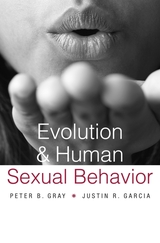 Evolution and Human Sexual Behavior
Peter B. Gray and Justin R. Garcia
Harvard University Press, 2013 Few things come more naturally to us than sex—or so it would seem. Yet to a chimpanzee, the sexual practices and customs we take for granted would appear odd indeed. He or she might wonder why we bother with inconveniences like clothes, why we prefer to make love on a bed, and why we fuss so needlessly over privacy. Evolution and Human Sexual Behavior invites us into the thought-experiment of imagining human sex from the vantage point of our primate cousins, in order to underscore the role of evolution in shaping all that happens, biologically and behaviorally, when romantic passions are aroused.
Peter Gray and Justin Garcia provide an interdisciplinary synthesis that draws on the latest discoveries in evolutionary theory, genetics, neuroscience, comparative primate research, and cross-cultural sexuality studies. They are our guides through an exploration of the patterns and variations that exist in human sexuality, in chapters covering topics ranging from the evolution of sex differences and reproductive physiology to the origins of sexual play, monogamous unions, and the facts and fictions surrounding orgasm.
Intended for generally curious readers of all stripes, this up-to-date, one-volume survey of the evolutionary science of human sexual behavior explains why sexuality has remained a core fascination of human beings throughout time and across cultures.
Evolution and Revolution in Linguistic Theory: Studies in Honor of Carlos P. Otero
Héctor Campos and Paula Kempchinsky, Editors
Georgetown University Press, 1995 This volume presents essays by some of the leading figures in the vanguard of theoretical linguistics within the framework of universal grammmar. One of the first books to adopt the "minimalist" framework to syntactic analysis, it includes a central essay by Noam Chomsky on the minimalist program and covers a range of topics in syntax and morphology. Contributors: Luigi Burzio, Héctor Campos, Noam Chomsky, Joseph E. Emonds, Robert Freidin, James Harris, Ray Jackendoff, Paula Kempchinsky, Howard Lasnik, Claudia Parodi, Carlos Piera, A. Carlos Quicoli, Dominique Sportiche, Esther Torrego.
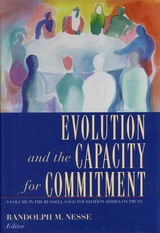 Evolution and the Capacity for Commitment
Randolph Nesse
Russell Sage Foundation, 2001 Commitment is at the core of social life. The social fabric is woven from promises and threats that are not always immediately advantageous to the parties involved. Many commitments, such as signing a contract, are fairly straightforward deals, in which both parties agree to give up certain options. Other commitments, such as the promise of life-long love or a threat of murder, are based on more intangible factors such as human emotions. In Evolution and the Capacity for Commitment, distinguished researchers from the fields of economics, psychology, ethology, anthropology, philosophy, medicine, and law offer a rich variety of perspectives on the nature of commitment and question whether the capacity for making, assessing, and keeping commitments has been shaped by natural selection. Game theorists have shown that players who use commitment strategies—by learning to convey subjective offers and to gauge commitments others are willing to make—achieve greater success than those who rationally calculate every move for immediate reward. Evolution and the Capacity for Commitment includes contributions from some of the pioneering students of commitment. Their elegant analyses highlight the critical role of reputation-building, and show the importance of investigating how people can believe that others would carry out promises or threats that go against their own self-interest. Other contributors provide real-world examples of commitment across cultures and suggest the evolutionary origins of the capacity for commitment. Perhaps nowhere is the importance of commitment and reputation more evident than in the institutions of law, medicine, and religion. Essays by professionals in each field explore why many practitioners remain largely ethical in spite of manifest opportunities for client exploitation. Finally, Evolution and the Capacity for Commitment turns to leading animal behavior experts to explore whether non-humans also use commitment strategies, most notably through the transmission of threats or signs of non-aggression. Such examples illustrate how such tendencies in humans may have evolved. Viewed as an adaptive evolutionary strategy, commitment offers enormous potential for explaining complex and irrational emotional behaviors within a biological framework. Evolution and the Capacity for Commitment presents compelling evidence for this view, and offers a potential bridge across the current rift between biology and the social sciences. A Volume in the Russell Sage Foundation Series on Trust
Evolution and the Diversity of Life: Selected Essays
Ernst Mayr
Harvard University Press, 1976 The diversity of living forms and the unity of evolutionary processes are themes that have permeated the research and writing of Ernst Mayr, a Grand Master of evolutionary biology. The essays collected here are among his most valuable and durable: contributions that form the basis for much of the contemporary understanding of evolutionary biology.
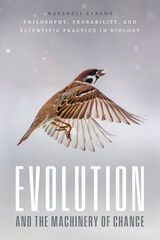 Evolution and the Machinery of Chance: Philosophy, Probability, and Scientific Practice in Biology
Marshall Abrams
University of Chicago Press, 2023 An innovative view of the role of fitness concepts in evolutionary theory.
Natural selection is one of the factors responsible for changes in biological populations. Some traits or organisms are fitter than others, and natural selection occurs when there are changes in the distribution of traits in populations because of fitness differences. Many philosophers of biology insist that a trait’s fitness should be defined as an average of the fitnesses of individual members of the population that have the trait.
Marshall Abrams argues convincingly against this widespread approach. As he shows, it conflicts with the roles that fitness is supposed to play in evolutionary theory and with the ways that evolutionary biologists use fitness concepts in empirical research. The assumption that a causal kind of fitness is fundamentally a property of actual individuals has resulted in unnecessary philosophical puzzles and years of debate. Abrams came to see that the fitnesses of traits that are the basis of natural selection cannot be defined in terms of the fitnesses of actual members of populations, as philosophers of biology often claim. Rather, it is an overall population-environment system—not actual, particular organisms living in particular environmental conditions—that is the basis of trait fitnesses. Abrams argues that by distinguishing different classes of fitness concepts and the roles they play in the practice of evolutionary biology, we can see that evolutionary biologists’ diverse uses of fitness concepts make sense together and are consistent with the idea that fitness differences cause evolution.
Abrams’s insight has broad significance, for it provides a general framework for thinking about the metaphysics of biological evolution and its relations to empirical research. As such, it is a game-changing book for philosophers of biology, biologists who want deeper insight into the nature of evolution, and anyone interested in the applied philosophy of probability.
Evolution As Entropy: Toward a Unified Theory of Biology
Daniel R. Brooks and E. O. Wiley
University of Chicago Press, 1988 "By combining recent advances in the physical sciences with some of the novel ideas, techniques, and data of modern biology, this book attempts to achieve a new and different kind of evolutionary synthesis. I found it to be challenging, fascinating, infuriating, and provocative, but certainly not dull."—James H, Brown, University of New Mexico
"This book is unquestionably mandatory reading not only for every living biologist but for generations of biologists to come."—Jack P. Hailman, Animal Behaviour, review of the first edition
"An important contribution to modern evolutionary thinking. It fortifies the place of Evolutionary Theory among the other well-established natural laws."—R.Gessink,TAXON
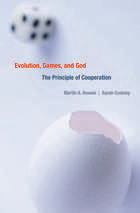 Evolution, Games, and God: The Principle of Cooperation
Martin A. Nowak
Harvard University Press, 2013 According to the reigning competition-driven model of evolution, selfish behaviors that maximize an organism’s reproductive potential offer a fitness advantage over self-sacrificing behaviors—rendering unselfish behavior for the sake of others a mystery that requires extra explanation. Evolution, Games, and God addresses this conundrum by exploring how cooperation, working alongside mutation and natural selection, plays a critical role in populations from microbes to human societies. Inheriting a tendency to cooperate, argue the contributors to this book, may be as beneficial as the self-preserving instincts usually thought to be decisive in evolutionary dynamics.
Assembling experts in mathematical biology, history of science, psychology, philosophy, and theology, Martin Nowak and Sarah Coakley take an interdisciplinary approach to the terms “cooperation” and “altruism.” Using game theory, the authors elucidate mechanisms by which cooperation—a form of working together in which one individual benefits at the cost of another—arises through natural selection. They then examine altruism—cooperation which includes the sometimes conscious choice to act sacrificially for the collective good—as a key concept in scientific attempts to explain the origins of morality. Discoveries in cooperation go beyond the spread of genes in a population to include the spread of cultural transformations such as languages, ethics, and religious systems of meaning.
The authors resist the presumption that theology and evolutionary theory are inevitably at odds. Rather, in rationally presenting a number of theological interpretations of the phenomena of cooperation and altruism, they find evolutionary explanation and theology to be strongly compatible.
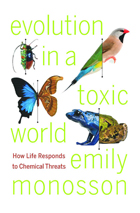 Evolution in a Toxic World: How Life Responds to Chemical Threats
Emily Monosson
Island Press, 2012 With BPA in baby bottles, mercury in fish, and lead in computer monitors, the world has become a toxic place. But as Emily Monosson demonstrates in her groundbreaking new book, it has always been toxic. When oxygen first developed in Earth's atmosphere, it threatened the very existence of life: now we literally can't live without it. According to Monosson, examining how life adapted to such early threats can teach us a great deal about today's (and tomorrow's) most dangerous contaminants. While the study of evolution has advanced many other sciences, from conservation biology to medicine, the field of toxicology has yet to embrace this critical approach.
In Evolution in a Toxic World, Monosson seeks to change that. She traces the development of life's defense systems—the mechanisms that transform, excrete, and stow away potentially harmful chemicals—from more than three billion years ago to today. Beginning with our earliest ancestors' response to ultraviolet radiation, Monosson explores the evolution of chemical defenses such as antioxidants, metal binding proteins, detoxification, and cell death.
As we alter the world's chemistry, these defenses often become overwhelmed faster than our bodies can adapt. But studying how our complex internal defense network currently operates, and how it came to be that way, may allow us to predict how it will react to novel and existing chemicals. This understanding could lead to not only better management and preventative measures, but possibly treatment of current diseases. Development of that knowledge starts with this pioneering book.
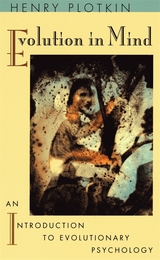 Evolution in Mind: An Introduction to Evolutionary Psychology
Henry Plotkin
Harvard University Press, 1998 We aren't very strong, nor very fast, we have insufficient body hair to keep us warm and dry, and we will never eat bananas with our feet. But like our chimpanzee cousins, we, the naked apes, have evolved to flourish in our surroundings--a cultural environment largely of our own creation. For the human race, the critical evolution of the past million years has been the evolution of our minds.
Yet psychology, the very science that purports to understand us, has long been deeply ambivalent about Darwin's unsettling discoveries. In an accessible, level-headed overview, Henry Plotkin describes the new rapprochement called 'evolutionary psychology.' He examines how such a powerful theory as Darwinism could have been disregarded by much academic psychology and shows why the relationship between the two must be readdressed. The theory and data of evolutionary biology and animal behavior can illuminate many of our most basic mental processes and activities: language learning, perception, social understanding, and most controversially, culture and the sharing of knowledge and beliefs.
Ranging from the nature-nurture question, which has bedeviled philosophers and scientists for thousands of years, to recent debates about the mind's structure, Evolution in Mind vividly demonstrates how an evolutionary perspective helps us understand what we are, and how we got that way.
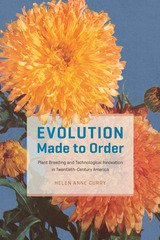 Evolution Made to Order: Plant Breeding and Technological Innovation in Twentieth-Century America
Helen Anne Curry
University of Chicago Press, 2016 Plant breeders have long sought technologies to extend human control over nature. Early in the twentieth century, this led some to experiment with startlingly strange tools like x-ray machines, chromosome-altering chemicals, and radioactive elements. Contemporary reports celebrated these mutation-inducing methods as ways of generating variation in plants on demand. Speeding up evolution, they imagined, would allow breeders to genetically engineer crops and flowers to order. Creating a new food crop or garden flower would soon be as straightforward as innovating any other modern industrial product.
In Evolution Made to Order, Helen Anne Curry traces the history of America’s pursuit of tools that could intervene in evolution. An immersive journey through the scientific and social worlds of midcentury genetics and plant breeding and a compelling exploration of American cultures of innovation, Evolution Made to Order provides vital historical context for current worldwide ethical and policy debates over genetic engineering.
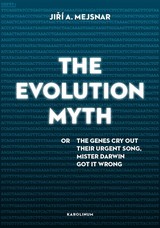 The Evolution Myth: or, The Genes Cry Out Their Urgent Song, Mister Darwin Got It Wrong
Jirí Mejsnar
Karolinum Press, 2014 The origins of life, species, and man continue to interest scientists and stir debate among the general public more than one hundred and fifty years after Charles Darwin published On the Origin of Species. The Evolution Myth approaches the subject with two intertwined objectives. Jirí A. Mejsnar first sets out to convey the advances made in cosmology, molecular biology, genetics, and other sciences that have enabled us to change our views on our origins and our relationship with the universe. Scientific advances now allow us to calculate, for example, the age of the universe, the period in which biblical Eve lived, and, with good justification, to reconsider the possibility that the Neanderthals and primates might be our ancestors.
The author’s second objective is to use biology to explain why evolution cannot have taken place in the way that is most commonly assumed. Mejsnar builds his case around gene stability and on the sophisticated modern techniques for gene manipulation, the complexity of which make these modified genes inaccessible to nature. Development of life on Earth is a discontinuous, saltatory progression that results in stages following from preceding latent periods in which new forms suddenly appear and possess new types of genome. This, the author argues, is difficult to reconcile with the hypothesis of continuous biological evolution based on the natural selection of random variations.
Taking a new approach to a much-debated subject, Mejsnar distills complex information into a readable style. The result is a book that is sure to get readers talking.
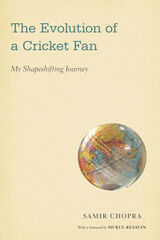 The Evolution of a Cricket Fan: My Shapeshifting Journey
Samir Chopra
Temple University Press, 2021 Samir Chopra is an immigrant, a “voluntary exile,” who discovers he can tell the story of his life through cricket, a game that has long been an influence—really, an obsession—for him. In so doing, he reveals how his changing views on the sport mirror his journey of self-discovery. In The Evolution of a Cricket Fan, Chopra is thus able to reflect on his changing perceptions of self, and of the nations and cultures that have shaped his identity, politics, displacement, and fandom. Chopra’s passion for the sport began as a child, when he rooted for Pakistan and against his native India. When he migrated, he became a fan of the Indian team that gave him a sense of home among the various cultures he encountered in North America and Australia. This “shapeshifting” exposes the rift between the Old and the New world, which Chopra acknowledges is “cricket’s greatest modern crisis.” But it also illuminates the identity dilemmas of post-colonial immigrants in the Indian diaspora. Chopra’s thoughts about the sport and its global influence are not those of a player. He provides access to the inner world of the global cricket fan navigating the world that colonial empire wrought and that cricket continues to connect and animate. He observes that the Indian cricket team carries many burdens—not only must they win cricket matches, but their style of play must generate a pride that assuages generations of wounds inflicted by history. And Chopra must navigate where he stands in that history. The Evolution of a Cricket Fan shows Chopra’s own wins and losses as his life takes new directions and his fandom changes allegiances.
 Evolution of a Missouri Asylum: Fulton State Hospital, 1851-2006
Richard L. Lael, Barbara Brazos, and Margot Ford McMillen
University of Missouri Press, 2007 Fulton State Hospital was not only Missouri’s first state mental asylum but also the first such institution west of the Mississippi. In tracing its founding and evolution over a century and a half, this book sheds light on both a neglected aspect of the state’s history and the development of mental health care in America. It acknowledges the noble aspirations of Fulton State Hospital—as well as its failures, throughout much of its existence, to transform those aspirations into realities. This institutional history of the hospital traces the debates surrounding its creation (as the State Lunatic Asylum) in a time when mental illness was barely understood. Although the Fulton hospital was initially conceived as a treatment facility, it quickly transformed into a primarily custodial institution. It existed as a self-sufficient establishment until the mid-twentieth century, dependent on patient labor and even producing its own food. But for the most socially disadvantaged and for the severely delusional, life at Fulton was anything but therapeutic. The book describes not only the lofty goals of professionals dedicated to treating the mentally ill but also an institution once clouded by overcrowding, financial mismanagement, political cronyism, and wrongful confinement. It considers segregation within the hospital, where the first black doctor was hired in 1960 and where racism nevertheless continued to flourish, and it describes how, even after the 1921 Eleemosynary Act, the patronage system continued to plague Fulton for two more decades. The authors reveal changing attitudes toward new treatments in the mid-twentieth century as psychotherapy and drugs became common, and decisions at Fulton regarding patient care are described within the context of progress in Europe and the eastern United States. The book addresses the complexities facing the physician-superintendents who supervised both medical therapies and administrative matters, depicting ongoing tension between hospital finances and state support and showing the difficulties state institutions faced in a “low tax/low public service” environment.
As Fulton State Hospital enters the twenty-first century, clients have become active in the development of institutional policies—a far cry from the warehousing of patients a hundred years ago. In tracing these seismic shifts in mental health care, this book offers an eye-opening exploration of how one state has sought to care for its citizens.
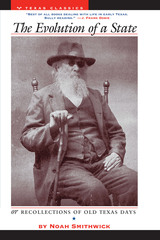 The Evolution of a State, or, Recollections of Old Texas Days
By Noah Smithwick
University of Texas Press, 1983 "I was but a boy in my nineteenth year, and in for adventure when I started out from Hopkinsville, Kentucky, with all my worldly possessions, consisting of a few dollars in money, a change of clothes, and a gun, of course, to seek my fortune in this lazy man's paradise." Noah Smithwick was an old man, blind and near his ninetieth year, when his daughter recorded these words. He had stayed on in "paradise"—Texas—from 1827 to 1861, when his opposition to secession took him to California. The Evolution of a State is his story of these "old Texas days." A blacksmith and a tobacco smuggler, Noah Smithwick made weapons for the Battle of Concepción, and he fought in that battle. With Hensley's company, he chased the Mexican army south of the Rio Grande after the Battle of San Jacinto. Twice he served with the Texas Rangers. In quieter times, he was a postmaster and justice of the peace in little Webber's Prairie. Eyewitness to so much Texas history, Smithwick recounts his life and adventures in a simple, straightforward style, with a wry sense of humor. His keen memory for detail—what the people wore, what they ate, how they worked and played— vividly evokes the sights, sounds, and smells of the frontier. First published in part by the Dallas Morning News, Smithwick's recollections gained such popularity that they were published in book form, as The Evolution of a State, in 1900. This new edition of a Texas classic makes widely available for the first time in many years this "best of all books dealing with life in early Texas."
 Evolution of African Mammals
Vincent J. Maglio
Harvard University Press, 1978 The recent explosion of publications on African prehistory has forced researchers in vertebrate evolution to sift through countless details of morphology, distribution and geological setting. Now, to simplify access to this information, Vincent Maglio and H.B.S. Cooke have prepared a single volume that summarizes our current knowledge about the origin and evolution of the Class Mammalia in Africa. Their book, consequently, is of great importance, and much of its material derives from ongoing research not available in any other published form.
In thirty chapters, fifteen mammalian orders are described in detail—their taxonomic groupings; the origins of their various subgroups; geographical distributions; major phyletic units; and specific evolutionary trends. Numerous illustrations accompany the text, and complete bibliographic references are given for each group. The modern mammalian fauna of Africa is summarized, with a description of the environments in which it is found. Man's impact on wildlife is also assessed. The major geological deposits of the African Cenozoic are reviewed, and the broader patterns of faunal evolution are synthesized in an attempt to cut across taxonomic boundaries and demonstrate the interdependence of faunal events on the continent as a whole.
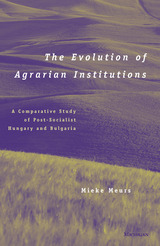 The Evolution of Agrarian Institutions: A Comparative Study of Post-Socialist Hungary and Bulgaria
Mieke Meurs
University of Michigan Press, 2001 The Evolution of Agrarian Institutions studies the unexpectedly slow and uneven growth of private agriculture in postsocialist East-Central Europe. Comparing developments in Hungary and Bulgaria, Mieke Meurs offers an explanation for this slow growth and examines its implications for efficiency and income distribution in postsocialist agriculture.
With the collapse of the state socialist regimes in East-Central Europe, it was widely expected that collectivized agriculture would quickly be remade in the glowing image of China--a patchwork of small, privately run farms yielding rapid increases in output and incomes. However, the European experience has been quite different; while socialist collective farms have disappeared, collective forms of organization have persisted, and private farming has been slow to emerge. Meurs argues that an understanding of the causes of the slow emergence of private farming is essential to effective policy intervention in agriculture. This book contributes to such an understanding through analyzing variations in farm organization and rural market development and comparing agricultural restructuring in Hungary and Bulgaria.
The Evolution of Agrarian Institutions is unique in its combination of original survey data, published data on land use, and published historical data. It also tests two institutionalist explanations for the pace and direction of change in agricultural organization. This book will be of interest to economists, political scientists, sociologists, scholars working in the area of rural development in emerging countries, and anyone with an interest in transitional economics.
Mieke Meurs is Associate Professor of Economics, American University.
 The Evolution of Altruism and the Ordering of Love
Stephen J. Pope
Georgetown University Press In this book, Stephen J. Pope argues that contemporary scientifically-based theories of the evolution of altruism provide important insights into one of the fundamental moral problems of Christian ethics, the natural basis of love and its ordering. He explores the contributions evolutionary theory makes to our understanding of the biological foundations of kin preference and reciprocal care, the limits of love, and the need for an ordering of love—issues relevant to any ethic that accords a central role to the deeply natural affections found in friendship, marriage, and the family. He proposes that understanding human nature in its broader evolutionary context brings to ethics a needed balance between the personal and biological dimensions of human nature. In the context of Catholic ethics, Pope points out functional similarities between Thomas Aquinas's use of then-available scientific theories in his interpretation of the natural basis of primary relationships and Pope's own efforts to avoid the deficiencies that characterize contemporary Catholic interpretations of love based on personalism and existentialism. He concludes with a call for a multidimensional interpretation of love, one that incorporates scientifically-based theories about human nature together with an appreciation of the significance of motives, intentions, and freedom, for the ordering of human affections and moral responsibility. This book will be of interest to moral theologians, especially those concerned with the topics of love, justice, and natural law ethics.
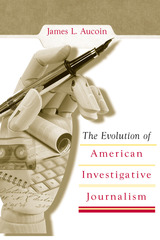 The Evolution of American Investigative Journalism
James L. Aucoin
University of Missouri Press, 2007 Beginning with America’s first newspaper, investigative reporting has provided journalism with its most significant achievements and challenging controversies. Yet it was an ill-defined practice until the 1960s when it emerged as a potent voice in newspapers and on television news programs. In The Evolution of American Investigative Journalism, James L. Aucoin provides readers with the first comprehensive history of investigative journalism, including a thorough account of the founding and achievements of Investigative Reporters and Editors (IRE). Aucoin begins by discussing in detail the tradition of investigative journalism from the colonial era through the golden age of muckraking in the 1900s, and into the 1960s. Subsequent chapters examine the genre’s critical period from 1960 to 1975 and the founding of IRE by a group of journalists in the 1970s to promote investigative journalism and training methods. Through the organization’s efforts, investigative journalism has evolved into a distinct practice, with defined standards and values. Aucoin applies the social-moral development theory of Alasdair MacIntyre—who has explored the function, development, and value of social practices—to explain how IRE contributed to the evolution of American investigative journalism. Also included is a thorough account of IRE’s role in the controversial Arizona Project. After Arizona Republic reporter Don Bolles (a founding member of IRE) was murdered while investigating land fraud, scores of reporters from around the country descended on the area to continue his work. The Arizona Project brought national attention and stature to the fledgling IRE and was integral to its continuing survival. Emerging investigative reporters and editors, as well as students and scholars of journalism history, will benefit from the detailed presentation and insightful discussion provided in this book.
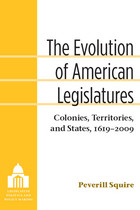 The Evolution of American Legislatures: Colonies, Territories, and States, 1619-2009
Peverill Squire
University of Michigan Press, 2014 The institutional development of American legislatures, beginning with the first colonial assembly of 1619, has been marked by continuity as well as change. Peverill Squire draws upon a wealth of primary sources to document this institutional history. Beginning with the ways in which colonial assemblies followed the precedents of British institutions, Squire traces the fundamental ways they evolved to become distinct. He next charts the formation of the first state legislatures and the Constitutional Congress, describes the creation of territorial and new state legislatures, and examines the institutionalization of state legislatures in the nineteenth century and their professionalization since 1900. With his conclusion, Squire discusses the historical trajectory of American legislatures and suggests how they might further develop over the coming decades. While Squire's approach will appeal to historians, his focus on the evolution of rules, procedures, and standing committee systems, as well as member salaries, legislative sessions, staff, and facilities, will be valuable to political scientists and legislative scholars.
The Evolution of Calusa: A Nonagricultural Chiefdom of the Southwest Florida Coast
Randolph J. Widmer
University of Alabama Press, 1988 The aims of this study are twofold: compile, for the first time, all the archaeological, environmental, and geological data pertinent to the evolution of the aboriginal inhabitants of southwest Florida; and, using this basis, develop a specific, integrated, and dynamic model of cultural adaptation that will serve as a stimulus for hypotheses that go beyond simple culture-historical concerns for future archaeological research in this region.
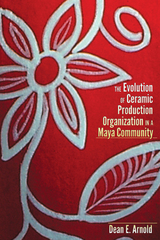 The Evolution of Ceramic Production Organization in a Maya Community
Dean E. Arnold
University Press of Colorado, 2014 In The Evolution of Ceramic Production Organization in a Maya Community, Dean E. Arnold continues his unique approach to ceramic ethnoarchaeology, tracing the history of potters in Ticul, Yucatán, and their production space over a period of more than four decades. This follow-up to his 2008 work Social Change and the Evolution of Ceramic Production and Distribution uses narrative to trace the changes in production personnel and their spatial organization through the changes in production organization in Ticul. Although several kinds of production units developed, households were the most persistent units of production in spite of massive social change and the reorientation of pottery production to the tourist market. Entrepreneurial workshops, government-sponsored workshops, and workshops attached to tourist hotels developed more recently but were short-lived, whereas pottery-making households extended deep into the nineteenth century. Through this continuity and change, intermittent crafting, multi-crafting, and potters' increased management of economic risk also factored into the development of the production organization in Ticul. Illustrated with more than 100 images of production units, The Evolution of Ceramic Production Organization in a Maya Community is an important contribution to the understanding of ceramic production. Scholars with interests in craft specialization, craft production, and demography, as well as specialists in Mesoamerican archaeology, anthropology, history, and economy, will find this volume especially useful.
 The Evolution of Cetacean Societies: Uncovering the Social Complexity of Whales and Dolphins
Edited by Darren P. Croft, Andrew D. Foote, Ellen C. Garland, and Stephanie L. King
University of Chicago Press From leading cetacean biologists, an up-to-date, comprehensive collection exploring advancements in our understanding of cetacean ecology, behavior, and societies.
Cetaceans—whales, dolphins, and porpoises—represent an evolutionary peak with respect to their advanced cognitive capacities; flexible communication systems; and structured, multilevel societies. Indeed, the social lives of whales and dolphins have long fascinated scientists and the public alike. The Evolution of Cetacean Societies provides a comprehensive overview of the significant advancements made in studying cetacean behavior and ecology over the last twenty-five years, focusing on our growing understanding of these animals’ complex social lives.
Bringing together scientists from multiple disciplines, the volume summarizes key innovations and progress related to studying cetacean societies’ cultural and genetic basis, their complex social structures, their use of cooperation and patterns of social conflict, and their significant interactions with humans. Each chapter provides an in-depth account of the social lives of whales and dolphins, incorporating the latest cutting-edge research from genomics, communication, network analysis, and animal culture to explain how these animals form societies, maintain relationships, and share information. The final chapters focus on the existential threats facing these diverse and charismatic species, how human-cetacean interactions have shaped our perceptions, and what scientists can learn from their diverse social lives by championing researcher diversity in marine mammal science. The result is an essential and forward-looking book that both contextualizes the lessons of the past two decades and questions the challenges these enigmatic species might face in the future.
Published in 2000 by Chicago, Cetacean Societies: Field Studies of Dolphins and Whales, edited by Janet Mann, Richard C. Connor, Peter Tyack, and Hal Whitehead, inspired a generation of marine biologists. In this new volume, Darren P. Croft, Andrew D. Foote, Ellen C. Garland, and Stephanie L. King—all respected cetacean researchers—offer a worthy successor.
 The Evolution of Childhood: Relationships, Emotion, Mind
Melvin Konner
Harvard University Press, 2011 This book is an intellectual tour de force: a comprehensive Darwinian interpretation of human development. Looking at the entire range of human evolutionary history, Melvin Konner tells the compelling and complex story of how cross-cultural and universal characteristics of our growth from infancy to adolescence became rooted in genetically inherited characteristics of the human brain.
All study of our evolution starts with one simple truth: human beings take an extraordinarily long time to grow up. What does this extended period of dependency have to do with human brain growth and social interactions? And why is play a sign of cognitive complexity, and a spur for cultural evolution? As Konner explores these questions, and topics ranging from bipedal walking to incest taboos, he firmly lays the foundations of psychology in biology.
As his book eloquently explains, human learning and the greatest human intellectual accomplishments are rooted in our inherited capacity for attachments to each other. In our love of those we learn from, we find our way as individuals and as a species. Never before has this intersection of the biology and psychology of childhood been so brilliantly described.
"Nothing in biology makes sense except in the light of evolution," wrote Dobzhansky. In this remarkable book, Melvin Konner shows that nothing in childhood makes sense except in the light of evolution.
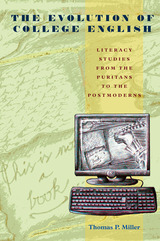 The Evolution of College English: Literacy Studies from the Puritans to the Postmoderns
Thomas P. Miller
University of Pittsburgh Press, 2011
Thomas P. Miller defines college English studies as literacy studies and examines how it has evolved in tandem with broader developments in literacy and the literate. He maps out “four corners” of English departments: literature, language studies, teacher education, and writing studies. Miller identifies their development with broader changes in the technologies and economies of literacy that have redefined what students write and read, which careers they enter, and how literature represents their experiences and aspirations.
Miller locates the origins of college English studies in the colonial transition from a religious to an oratorical conception of literature. A belletristic model of literature emerged in the nineteenth century in response to the spread of the “penny” press and state-mandated schooling. Since literary studies became a common school subject, professors of literature have distanced themselves from teachers of literacy. In the Progressive era, that distinction came to structure scholarly organizations such as the MLA, while NCTE was established to develop more broadly based teacher coalitions. In the twentieth century New Criticism came to provide the operating assumptions for the rise of English departments, until those assumptions became critically overloaded with the crash of majors and jobs that began in 1970s and continues today.<br><br>
For models that will help the discipline respond to such challenges, Miller looks to comprehensive departments of English that value studies of teaching, writing, and language as well as literature. According to Miller, departments in more broadly based institutions have the potential to redress the historical alienation of English departments from their institutional base in work with literacy. Such departments have a potentially quite expansive articulation apparatus. Many are engaged with writing at work in public life, with schools and public agencies, with access issues, and with media, ethnic, and cultural studies. With the privatization of higher education, such pragmatic engagements become vital to sustaining a civic vision of English studies and the humanities generally.
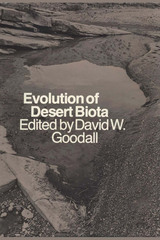 Evolution of Desert Biota
Edited by David W. Goodall
University of Texas Press, 1976 Written by specialists in the field, the papers in this volume explore evolution of animals and plants on the deserts of North America, South America, and Australia. Together, the articles constitute a complete survey of the geological history of the deserts of three continents, the evolution of the animals and plants of those deserts, and their adaptations to the environments in which they live. The first paper, by Otto T. Solbrig, discusses the flora of the South American temperate and semidesert regions, citing numerous genera and reasons that they are found in the different areas. John S. Beard uses the same approach in his discussion of the evolution of Australian desert plants and focuses on western Australian areas. Guillermo Sarmiento appraises the evolution of arid vegetation in tropical America, including the Lesser Antilles and the Coast Range of Venezuela and Colombia. A. R. Main surveys the adaptation of Australian vertebrates to desert conditions and gives examples of how various species of birds, reptiles, and amphibians adapt to their environment in order for the greatest number to survive. James A. MacMahon designates specific communities in the Mojave, Sonoran, and Chihuahuan deserts and discusses the similarity of species of the North American desert mammal faunas found there, while Bobbi S. Low focuses on the evolution of amphibian life histories in the desert and compiles a lengthy table of amphibia comparing egg size, habitat, number of eggs per clutch, and so forth. Finally, W. Frank Blair treats adaptation of anurans to equivalent desert scrub of North and South America and cites various species of frogs and toads that are found in similar areas. The volume also includes an introduction by the editor and an index. Evolution of Desert Biota is the result of a symposium held during the First International Congress of Systematic and Evolutionary Biology in Boulder, Colorado; in August 1973.
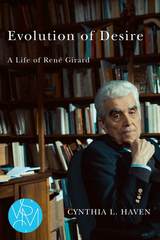 Evolution of Desire: A Life of René Girard
Cynthia L Haven
Michigan State University Press, 2018 René Girard (1923–2015) was one of the leading thinkers of our era—a provocative sage who bypassed prevailing orthodoxies to offer a bold, sweeping vision of human nature, human history, and human destiny. His oeuvre, offering a “mimetic theory” of cultural origins and human behavior, inspired such writers as Milan Kundera and J. M. Coetzee, and earned him a place among the forty “immortals” of the Académie Française. Too often, however, his work is considered only within various academic specializations. This first-ever biographical study takes a wider view. Cynthia L. Haven traces the evolution of Girard’s thought in parallel with his life and times. She recounts his formative years in France and his arrival in a country torn by racial division, and reveals his insights into the collective delusions of our technological world and the changing nature of warfare. Drawing on interviews with Girard and his colleagues, Evolution of Desire: A Life of René Girard provides an essential introduction to one of the twentieth century’s most controversial and original minds.
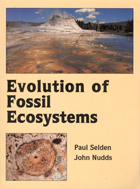 Evolution of Fossil Ecosystems
Paul A. Selden and John R. Nudds
University of Chicago Press, 2005 Major advances in our understanding of the history of life on Earth have been achieved through the study of exceptionally well-preserved fossil sites, known scientifically as fossil Lagerstätten. The examination of such sites provides a surprisingly complete picture of the evolution of ecosystems throughout the ages. In Evolution of Fossil Ecosystems, Paul A. Selden and John R. Nudds celebrate these unique and rare preserves of ancient ecosystems with succinct summaries of fourteen of the better-known fossil Lagerstätten—including the Ediacara in South Australia, the Hunsrück Slate in Germany, the Santana and Crato Formations in Brazil, and the La Brea Tar Pits in Los Angeles.
Beginning with a general introduction to fossil Lagerstätten, Evolution of Fossil Ecosystems goes on, chapter by chapter, to consider each fossil site, detailing its evolutionary position and significance; a brief history of the locality; its background sedimentology, stratigraphy, and paleoenvironment; its biota and paleoecology; and its commonalities with similar Lagerstätten. Considering deposits both marine and terrestrial, the book covers one fossil site from the Precambrian era, five sites from the Paleozoic era, five sites from the Mesozoic era, and three sites from the Cenozoic era.
Illustrated with hundreds of color photographs and drawings, Evolution of Fossil Ecosystems is a sophisticated yet accessible guide to these critical sites. Containing useful appendixes listing important museums, instructions on how to visit the fossil sites, and additional suggested reading, this book will attract students, academics, and professionals in paleontology, evolution, and the earth and life sciences, as well as dedicated amateurs interested in fossils and geology.
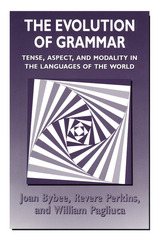 The Evolution of Grammar: Tense, Aspect, and Modality in the Languages of the World
Joan Bybee, Revere Perkins, and William Pagliuca
University of Chicago Press, 1994 Joan Bybee and her colleagues present a new theory of the evolution of grammar that links structure and meaning in a way that directly challenges most contemporary versions of generative grammar. This study focuses on the use and meaning of grammatical markers of tense, aspect, and modality and identifies a universal set of grammatical categories. The authors demonstrate that the semantic content of these categories evolves gradually and that this process of evolution is strikingly similar across unrelated languages.
Through a survey of seventy-six languages in twenty-five different phyla, the authors show that the same paths of change occur universally and that movement along these paths is in one direction only. This analysis reveals that lexical substance evolves into grammatical substance through various mechanisms of change, such as metaphorical extension and the conventionalization of implicature. Grammaticization is always accompanied by an increase in frequency of the grammatical marker, providing clear evidence that language use is a major factor in the evolution of synchronic language states.
The Evolution of Grammar has important implications for the development of language and for the study of cognitive processes in general.
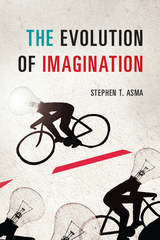 The Evolution of Imagination
Stephen T. Asma
University of Chicago Press, 2017 Consider Miles Davis, horn held high, sculpting a powerful musical statement full of tonal patterns, inside jokes, and thrilling climactic phrases—all on the fly. Or think of a comedy troupe riffing on a couple of cues from the audience until the whole room is erupting with laughter. Or maybe it’s a team of software engineers brainstorming their way to the next Google, or the Einsteins of the world code-cracking the mysteries of nature. Maybe it’s simply a child playing with her toys. What do all of these activities share? With wisdom, humor, and joy, philosopher Stephen T. Asma answers that question in this book: imagination. And from there he takes us on an extraordinary tour of the human creative spirit.
Guided by neuroscience, animal behavior, evolution, philosophy, and psychology, Asma burrows deep into the human psyche to look right at the enigmatic but powerful engine that is our improvisational creativity—the source, he argues, of our remarkable imaginational capacity. How is it, he asks, that a story can evoke a whole world inside of us? How are we able to rehearse a skill, a speech, or even an entire scenario simply by thinking about it? How does creativity go beyond experience and help us make something completely new? And how does our moral imagination help us sculpt a better society? As he shows, we live in a world that is only partly happening in reality. Huge swaths of our cognitive experiences are made up by “what-ifs,” “almosts,” and “maybes,” an imagined terrain that churns out one of the most overlooked but necessary resources for our flourishing: possibilities. Considering everything from how imagination works in our physical bodies to the ways we make images, from the mechanics of language and our ability to tell stories to the creative composition of self-consciousness, Asma expands our personal and day-to-day forms of imagination into a grand scale: as one of the decisive evolutionary forces that has guided human development from the Paleolithic era to today. The result is an inspiring look at the rich relationships among improvisation, imagination, and culture, and a privileged glimpse into the unique nature of our evolved minds.
The Evolution of Investing at the University of Michigan: 1817–2016
Rafael E. Castilla and William P. Hodgeson
Michigan Publishing, 2017 Endowments, foundations, pension funds, private equity, venture capital, hedge funds: these terms are now commonplace as the world of institutional investing has become increasingly complex over the past hundred years. But how did it get this way? The Evolution of Investing at the University of Michigan traces the development of institutional investing through the lens of one of the country’s largest endowments, illustrating how tidal changes in the law, new approaches to governance, portfolio theory and continuing academic advances and studies, as well as incredible innovation in the practice of investment management, have all combined to create the highly sophisticated investing landscape of today.
The Evolution of Keats's Poetry
Claude Lee Finney
Harvard University Press Existing records of Keats’s life and poems are so complete that Professor Finney has been able to trace the evolution of his ideas almost day by day. The book, however, is biographical criticism rather than critical biography, only those facts of Keats’s life being related that help us to understand his poems. Each poem is interpreted in the light of the personal, social, political, philosophical, and literary forces which influenced the poet's mind at the time of writing. The study is based upon all available manuscripts, and these have been quoted so extensively that the volume may be used as a source-book as well as a critical survey. All in all, as the most complete and most detailed work in its field, it will be invaluable to students of Keats, of nineteenth-century poetry, and of literary criticism.
The Evolution of Keats's Poetry
Claude Lee Finney
Harvard University Press Existing records of Keats’s life and poems are so complete that Professor Finney has been able to trace the evolution of his ideas almost day by day. The book, however, is biographical criticism rather than critical biography, only those facts of Keats’s life being related that help us to understand his poems. Each poem is interpreted in the light of the personal, social, political, philosophical, and literary forces which influenced the poet’s mind at the time of writing. The study is based upon all available manuscripts, and these have been quoted so extensively that the volume may be used as a source-book as well as a critical survey. All in all, as the most complete and most detailed work in its field, it will be invaluable to students of Keats, of nineteenth-century poetry, and of literary criticism.
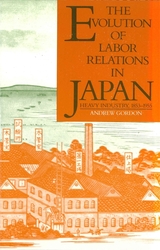 The Evolution of Labor Relations in Japan: Heavy Industry, 1853–1955
Andrew Gordon
Harvard University Press, 1985 The century-long process by which a distinct pattern of Japanese labor relations evolved is traced through the often turbulent interactions of workers, managers, and, at times, government bureaucrats and politicians. The author argues that, although by the 1920s labor relations had reached a stage that foreshadowed postwar development, it was not until the 1940s and 1950s that something closely akin to the contemporary pattern emerged.
The central theme is that the ideas and actions of the workers, whether unionized or not, played a vital role in the shaping of the system. This is the only study in the West that demonstrates how Japanese workers sought to change and to some extent succeeded in changing the structure of factory life. Managerial innovations and the efforts of state bureaucrats to control social change are also examined.
The book is based on extensive archival research and interviewing in Japan, including the use of numerous labor-union publications and the holdings of the prewar elite’s principal organization for the study of social issues, the Kyochokai (“Association for Harmonious Cooperation”)—both collections having only recently been catalogued and opened to scholars. This is an intensive look at past developments that underlie labor relations in today’s Japanese industrial plants.
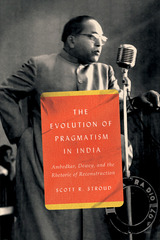 The Evolution of Pragmatism in India: Ambedkar, Dewey, and the Rhetoric of Reconstruction
Scott R. Stroud
University of Chicago Press, 2023 "A magnificent study" (New York Review of Books) of how the Indian reformer Bhimrao Ambedkar reimagined John Dewey’s pragmatism.
In The Evolution of Pragmatism in India, Scott R. Stroud delivers a comprehensive exploration of the influence of John Dewey’s pragmatism on Bhimrao Ambedkar, architect of the Republic of India’s constitution. Stroud traces Ambedkar’s development in Dewey’s Columbia University classes in 1913–1916 through his final years in 1950s India when he rewrote the story of Buddhism. Stroud examines pragmatism’s influence not only on the philosophical ideas underpinning Ambedkar’s fight against caste oppression but also how his persuasive techniques drew on pragmatism’s commitment to reconstruction and meliorism. At the same time, Stroud is careful to point out the ways that Ambedkar pushed back against Dewey’s paradigm and developed his own approach to challenges in India. The result is a nuanced study of one of the most important figures in Indian history.
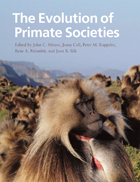 The Evolution of Primate Societies
Edited by John C. Mitani, Josep Call, Peter M. Kappeler, Ryne A. Palombit, and Joan B. Silk
University of Chicago Press, 2012 In 1987, the University of Chicago Press published Primate Societies, the standard reference in the field of primate behavior for an entire generation of students and scientists. But in the twenty-five years since its publication, new theories and research techniques for studying the Primate order have been developed, debated, and tested, forcing scientists to revise their understanding of our closest living relatives. Intended as a sequel to Primate Societies, The Evolution of Primate Societies compiles thirty-one chapters that review the current state of knowledge regarding the behavior of nonhuman primates. Chapters are written by the leading authorities in the field and organized around four major adaptive problems primates face as they strive to grow, maintain themselves, and reproduce in the wild. The inclusion of chapters on the behavior of humans at the end of each major section represents one particularly novel aspect of the book, and it will remind readers what we can learn about ourselves through research on nonhuman primates. The final section highlights some of the innovative and cutting-edge research designed to reveal the similarities and differences between nonhuman and human primate cognition. The Evolution of Primate Societies will be every bit the landmark publication its predecessor has been.
The Evolution of Racism: Human Differences and the Use and Abuse of Science
Pat Shipman
Harvard University Press In an intellectually engaging narrative that mixes science and history, theories and personalities, Pat Shipman asks the question: Can we have legitimate scientific investigations of differences among humans without sounding racist?
Through the original controversy over evolutionary theory in Darwin's time; the corruption of evolutionary theory into eugenics; the conflict between laboratory research in genetics and fieldwork in physical anthropology and biology; and the continuing controversies over the heritability of intelligence, criminal behavior, and other traits, the book explains both prewar eugenics and postwar taboos on letting the insights of genetics and evolution into the study of humanity.
The Evolution of Retirement: An American Economic History, 1880-1990
Dora L. Costa
University of Chicago Press, 1998 Winner of the 1998 Paul A. Samuelson Award given by TIAA-CREF, The Evolution of Retirement is the first comprehensive economic history of retirement in America. With life expectancies steadily increasing, the retirement rate of men over age 64 has risen drastically. Dora L. Costa looks at factors underlying this increase and shows the dramatic implications of her findings for both the general public and the U.S. government. Using statistical, and demographic concepts, Costa sheds light on such important topics as rising incomes and retirement, work and disease, the job prospects of older workers, living arrangements of the elderly, the development of a retirement lifestyle, and pensions and politics.
The Evolution of Settlement Systems in the Region of Vohémar, Northeast Madagascar
Henry T. Wright, Robert E. Dewar, Chantal Radimilahy, and Lucien Marie Aimé Rakotozafy
University of Michigan Press, 2021 On the northeast coast of Madagascar, near the town of Vohémar, is a large cemetery dating to the fourteenth century. During World War II, French troops excavated the site but left no comprehensive report. University of Michigan archaeologist Henry T. Wright led an intensive archaeological survey in the region, hoping to find evidence of earlier settlements. In four seasons, the researchers found evidence of several settlements dating to different periods: a large port site dating to the same era as the cemetery; early estuarine villages of the 7th and 8th centuries; and a rock shelter with microlithic tools. In this study, Wright presents the survey results in detail, including the evidence for settlements as well as illustrations of the ceramics and stone tools.
 The Evolution of Shakespeare’s Comedy: A Study in Dramatic Perspective
Larry S. Champion
Harvard University Press, 1970 The evolution of Shakespeare's comedy, in Larry Champion's view, is apparent in the expansion of his comic vision to include a complete reflection of human life while maintaining a comic detachment for the audience. Like the other popular dramatists of Elizabethan England, Shakespeare used the diverse comic motifs and devices which time and custom had proved effective. He went further, however, and created progressively deeper levels of characterization and plot interaction, thereby forming characters who were not merely devices subordinated to the needs of the plot.
Shakespeare's development as a comic playwright, suggests Champion, was “consistently in the direction of complexity or depth of characterization.” His earliest works, like those of his contemporaries, are essentially situation comedies: the humor arises from action rather than character. There is no significant development of the main characters; instead, they are manipulated into situations which are humorous as a result, for example, of mistaken identity or slapstick confusion. The ensuing phase of Shakespeare's comedy sets forth plots in which the emphasis is on identity rather than physical action, a revelation of character which occurs in one of two forms: either a hypocrite is exposed for what he actually is or a character who has assumed an unnatural or abnormal pose is forced to realize and admit the ridiculousness of his position. In the final comedies involving sin and sacrificial forgiveness, however, character development is concerned with a “transformation of values.”
Although each of the comedies is discussed, Champion concentrates on nine, dividing them according to the complexity of characterization. He pursues as well the playwright's efforts to achieve for the spectator the detached stance so vital to comedy. Shakespeare obtained this perspective, Champion observes, through experimentation with the use of material mirroring the main action—mockery, parody, or caricature—and through the use of a “comic pointer” who is himself involved in the action but is sufficiently independent of the other characters to provide the audience with an omniscient view.
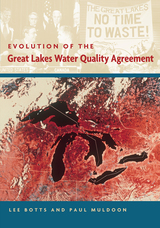 Evolution of the Great Lakes Water Quality Agreement
Lee Botts
Michigan State University Press, 2005 Water quality concerns are not new to the Great Lakes. They emerged early in the 20th century, in 1909, and matured in 1972 and 1978. They remain a prominent part of today’s conflicted politics and advancing industrial growth. The Great Lakes Water Quality Agreement, under the Boundary Waters Treaty of 1909, became a model to the world for environmental management across an international boundary. Evolution of the Great Lakes Water Quality Agreement recounts this historic binational relationship, an agreement intended to protect the fragile Great Lakes.
One strength of the agreement is its flexibility, which includes a requirement for periodic review that allows modification as problems are solved, conditions change, or scientific research reveals new problems. The first progress was made in the 1970s in the area of eutrophication, the process by which lakes gradually age, which normally takes thousands of years to progress, but is accelerated by modern water pollution. The binational agreement led to the successful lowering of phosphorus levels that saved Lake Erie and prevented accelerated eutrophication in the rest of the Great Lakes ecosystem. Another major success at the time was the identification and lowering of the levels of toxic contaminants that cause major threats to human and wildlife health, from accumulating PCBs and other persistent organic pollutants
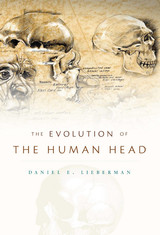 The Evolution of the Human Head
Daniel E. Lieberman
Harvard University Press, 2011 In one sense, human heads function much like those of other mammals. We use them to chew, smell, swallow, think, hear, and so on. But, in other respects, the human head is quite unusual. Unlike other animals, even our great ape cousins, our heads are short and wide, very big brained, snoutless, largely furless, and perched on a short, nearly vertical neck. Daniel E. Lieberman sets out to explain how the human head works, and why our heads evolved in this peculiarly human way.
Exhaustively researched and years in the making, this innovative book documents how the many components of the head function, how they evolved since we diverged from the apes, and how they interact in diverse ways both functionally and developmentally, causing them to be highly integrated. This integration not only permits the head’s many units to accommodate each other as they grow and work, but also facilitates evolutionary change. Lieberman shows how, when, and why the major transformations evident in the evolution of the human head occurred. The special way the head is integrated, Lieberman argues, made it possible for a few developmental shifts to have had widespread effects on craniofacial growth, yet still permit the head to function exquisitely.
This is the first book to explore in depth what happened in human evolution by integrating principles of development and functional morphology with the hominin fossil record. The Evolution of the Human Head will permanently change the study of human evolution and has widespread ramifications for thinking about other branches of evolutionary biology.
|
|

